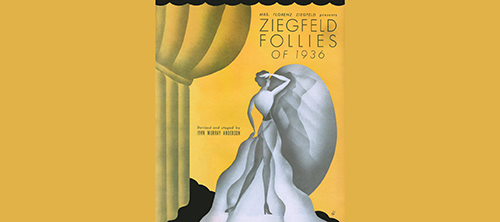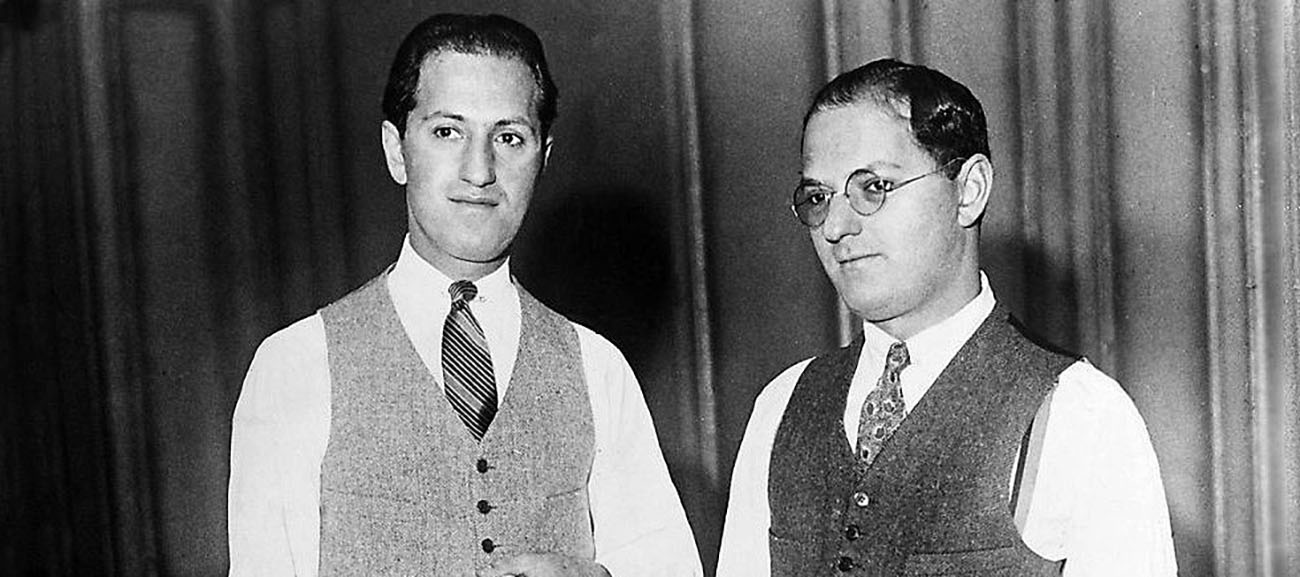
Oeuvres de George Gershwin
Oeuvres de Ira Gershwin
B) Quelques oeuvres de George Gershwin
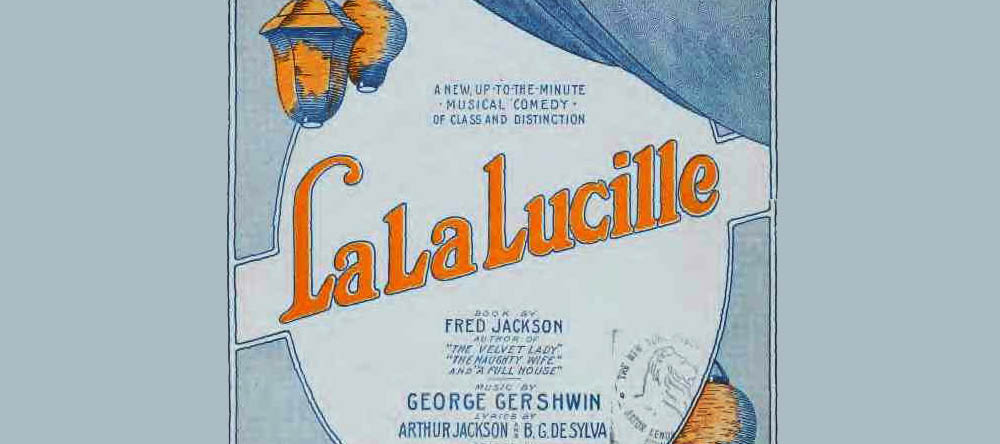
Musical
Musique: George Gershwin • Paroles: Arthur J. Jackson • B.G. DeSylva • Livret: Fred Jackson • Production originale: 1 version mentionnée
Dispo: Résumé Génèse Liste chansons
Ce fut la première fois que Gershwin écrivait la partition complète pour un musical.
Genèse: Le musical est créé à Broadway au Henry Miller’s Theatre le 26 mai 1919, mais doit interrompre ses représentations lorsque l'Actors' Equity fait grève le 19 août. Une fois le différend réglé, il rouvrit au Criterion Theatre le 8 septembre et y resta jusqu’au 11 octobre 1919, après 104 représentations. Le metteur en scène était Herbert Gresham, avec des chorégraphies de Julian Alfred. La distribution comprenait Maurice Cass, John Hazzard, Eleanor Daniels, Janet Velie, Lorin Raker, Marjorie Bentley, Helen Clarke, Alfred Hall, J. Clarence Harvey et Cordelia MacDonald. In 2019, the Third Avenue Playhouse in Sturgeon Bay, WI adapted and reproduced the musical. The Playhouse's co-artistic director, James Valcq, spent years researching and reassembling the original songs and book in order to recreate the original musical as faithfully as possible.
Résumé: L'hsitoire s'intéresse à une riche matrone de la haute société qui lègue sa fortune considérable à son neveu à condition qu’il divorce de sa femme, qui est une 'chorus girl'. Afin de ne pas passer à côté de cet héritage, il décide de se conformer aux conditions imposées et de se remarier après avoir reçu l’argent. Puisque les divorces ne sont accordés que pour adultère, une employée de l’hôtel de Philadelphie nommée Lucille Jaynes-Smith s’arrange pour qu’il soit trouvé avec une femme qui n’est pas sa femme. Il s’enregistre à l'hôtel sous le nom d'emprunt de John Smith, et des complications comiques s’ensuivent quand il découvre qu’il y a plus de trois douzaines d’autres John Smiths enregistrés là aussi.
Création: 26/5/1919 - Stephen Sondheim Theatre (Broadway) - 104 représ.
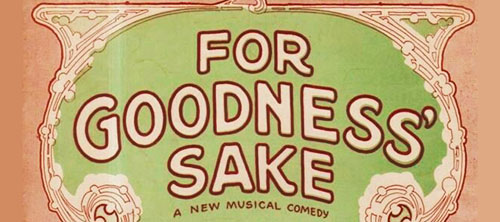
Musical
Musique: George Gershwin • Paul Lannin • William Daly • Paroles: Arthur J. Jackson • Livret: Fred Jackson • Production originale: 3 versions mentionnées
Dispo: Résumé Commentaire Liste chansons
Genèse:
Résumé: Vivian Reynolds suppose à tort que son mari, Perry, la trompe, et elle prétend donc le tromper. Afin de faire regretter à Vivian ce qu’il croit être ses infidélités, Perry feint de se suicider en se noyant, mais Vivian réagit complètement indifférent à sa mort supposée, et l’irrite avec son attitude blasée.
Création: 21/2/1922 - Lyric Theatre (Broadway) - 103 représ.

Revue
Musique: Cole Porter • George Gershwin • Irving Berlin • Max Darewski • Paroles: Livret: John Hastings Turner • Production originale: Chales B. Cochran • 1 version mentionnée
Dispo: Génèse
Une revue produite et mise en scène par C.B. Cochran.
Genèse: Le spectacle comportait trois ballets: un spectacle inca autour du culte du soleil, raconté par Lady Tree avec Alice Delysia comme victime sacrificielle; un ballet florentin avec Nikitina; et un ballet sur l’escalier de Versailles. Les différentes scènes se déroulent à Cannes, Genève, en Chine, sur l’île de la mer du Sud, à Versailles, à Marseille et au Pérou. Il a été décrit comme «l’un des spectacles de scène les plus brillants et luxueux de la Londres actuelle. La réalisation suprême de Mr Cochran en tant que producteur d’imagination et de goût artistique exigeant» (The Stage). Ce fut la première apparition de Lady Tree dans une revue, même si elle apparaît simultanément dans la pièce en un acte de J.M. Barrie Shall We Join the Ladies pièce jouée en lever de rideau avant Loyalties au St Martin’s Theatre. Sa pièce a eu plus de succès, et a duré plus longtemps que la revue. Le spectacle a reçu un accueil mitigé, et il a subi un coup fatal lorsque Delysia a perdu sa voix à cause d’une infection de la gorge et a dû se retirer de la distribution six semaines après le début de la représentation. Un spécialiste de la gorge lui a ordonné de reposer sa voix pendant trois mois. Sans sa star, le spectacle n’a pas réussi à attirer le public, et Cochran l’a fermé après moins de deux mois, subissant une perte de 20.000£.
Résumé:
Création: 9/3/1922 - Oxford Music Hall (Londres) - 77 représ.
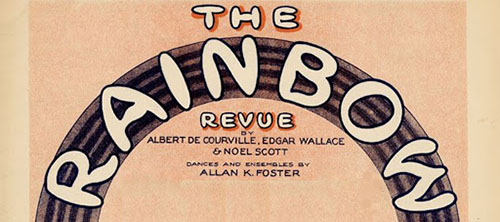
Revue
Musique: George Gershwin • Paroles: Clifford Grey • Livret: Production originale: 1 version mentionnée
Dispo: Résumé Liste chansons
Genèse:
Résumé: La première visite de George Gershwin à Londres lui donne l’occasion d’écrire la partition de cette revue qui l’associe au parolier anglais Clifford Grey. Dans une lettre à Ira de l’hôtel Savoy, George a écrit qu’il était très heureux de l'accueil, qui comprenait un agent des douanes qui l’a reconnu comme le compositeur de «Swanee» et un journaliste qui lui a donné «l’impression d’être Kern ou quelqu’un d’autre». George arriva à Londres seulement quatre jours avant le début des répétitions; heureusement, il apporta avec lui un certain nombre de chansons déjà écrites qui pourraient être insérées dans la production. Gershwin et Grey en créèrent de nombreuses autres - de qualité variable - mais THE RAINBOW REVUE, bien qu’ayant connu du succès à Londres, n’a jamais reçu de production américaine.
Création: 3/4/1923 - Empire Theatre (Londres) - représ.
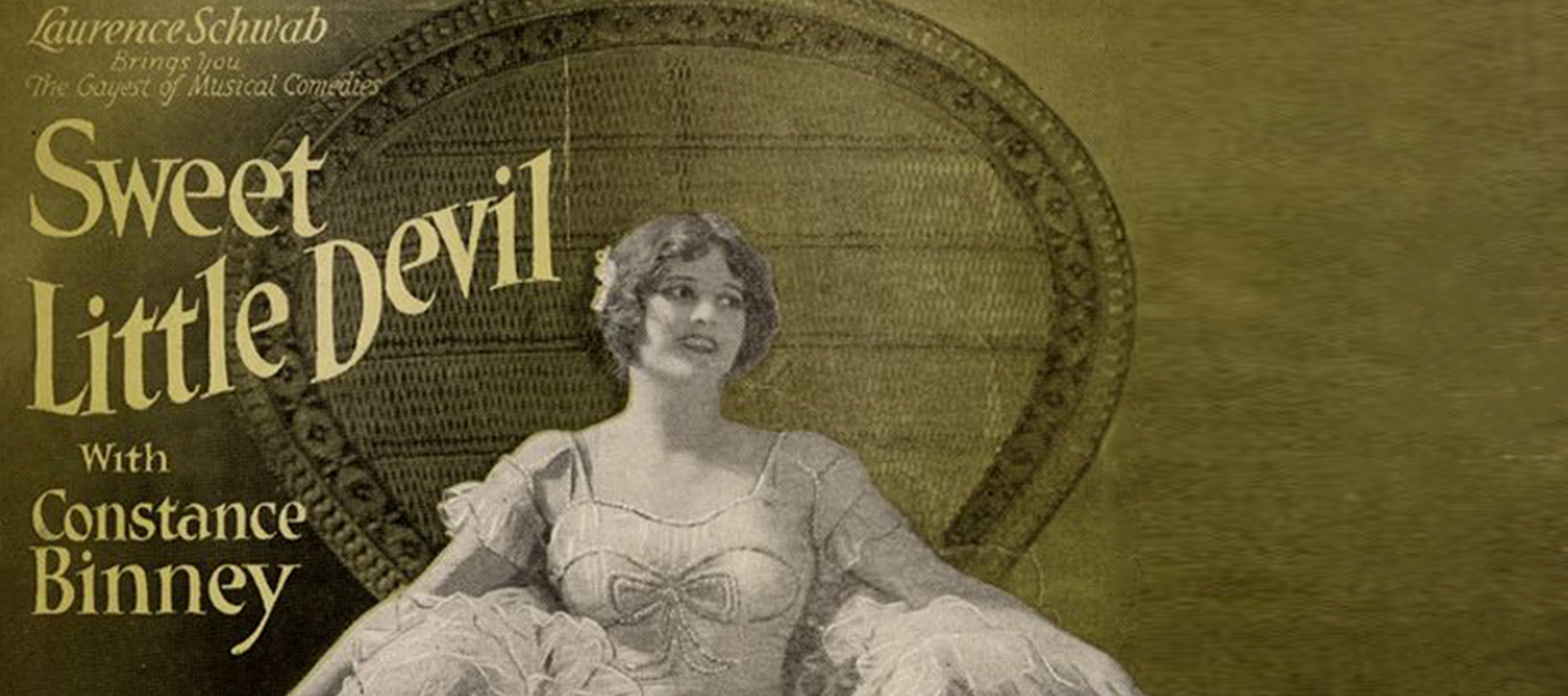
Musical
Musique: George Gershwin • Paroles: B.G. DeSylva • Livret: Frank Mandel • Laurence Schwab • Production originale: 3 versions mentionnées
Dispo: Résumé Liste chansons
Bien qu’aucun standard n’ait émergé de Sweet Little Devil de George Gershwin, la partition était attrayante avec un côté légèrement acidulé. Et l’intrigue était teintée de cynisme…
Genèse:
Résumé: Joyce West, chercheuse d’or désabusée, jette son dévolu sur Tom Nesbitt, un inventeur américain vivant au Pérou qui a vendu une invention à une compagnie de chemin de fer pour 40.000 dollars. Pendant ce temps, la cousine de Joyce et écrivaine Virginia, qui travaille sur son roman The Flaming Maiden, a intercepté les lettres de Tom à Joyce et y répond en se faisant passer pour Joyce. Tom retourne à New York et finit par se rendre compte que Joyce est une imposture et que Virginia est son véritable amour.
Création: 21/1/1924 - Astor Theatre (Broadway) - 120 représ.
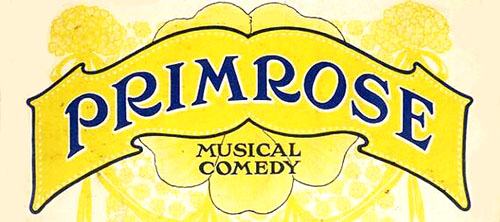
Musical
Musique: George Gershwin • Paroles: Desmond Carter • Ira Gershwin • Livret: George Grossmith • Guy Bolton • Production originale: 1 version mentionnée
Dispo: Résumé Génèse Liste chansons
Primrose is a musical in three acts with a book by Guy Bolton and George Grossmith Jr., lyrics by Desmond Carter and Ira Gershwin, and music by George Gershwin. It centers on a writer whose story-within-a-story forms the basis of the plot. It was written expressly for the London stage, where it ran for 255 performances in 1924 and 1925. George Gershwin, at 25 years old, was an established songwriter by 1924 when Grossmith and his producing partners, J. A. E. Malone and Edward Laurillard, hired him to produce the score for Primrose for them in London. The musical is the first in which Gershwin wrote some of the orchestrations himself. The year was one of the busiest for Gershwin, as it also included his Rhapsody in Blue and two other musicals. Gershwin's score, and the book by Bolton are old-fashioned for their time, with more in common with the frothy Edwardian musical comedies than with the later Gershwin musicals.
Genèse: Primrose was produced by Grossmith and J. A. E. Malone, who wanted to follow up on their earlier successes composed by Jerome Kern.[2] It opened at the Winter Garden Theatre in London on 11 September 1924 only two months before the Gershwins’ Lady, Be Good! debuted on Broadway. The cast featured comedian Leslie Henson and also included Claude Hulbert, Heather Thatcher and opera baritone Percy Heming. The director was Charles A. Maynard, and the choreographer was Laddie Cliff.[5][6] Extensive excerpts from the score were recorded with original 1924 cast members conducted by Ansell, and have been re-released on CD. P. G. Wodehouse rewrote the lyric of 'When Toby is out of Town' as 'The Twenties are Here to Stay', interpolated into a 1960 revival of Gershwin's Oh, Kay! In their joint memoir Bring on the Girls!, Wodehouse and Bolton relate a story about Grossmith holding auditions for Primrose, where he made a routine request of Sylvia Hawkes, a beautiful young dancer, who later married a series of famous men: "Must I sing, Mr Grossmith?" "Yes, Sylvia, you must. All of you have to sing if you want jobs as showgirls in Primrose. The Gershwin score demands it." "Oh very well," she replied petulantly, and, going down to the floats she handed over a piece of music to the pianist in the pit. The piano struck a chord. "God save our gracious King, Long live our noble King, God save the King." Grossmith, a strict observer of ritual, rose and stood at attention. His minions rose and stood at attention. Guy, on his way to announce his arrival, stood at attention. As the anthem came to the normal stopping point, George started to sit down, but there is more, much more of the fine old chorale than is generally known. James Carey is credited with a three-stanza version; in another version John Bull... has expressed the same sentiment in his own way; while James Oswald... also got into the act. A printing is extant giving them all. Sylvia Hawkes sang them all. The pianist stopped playing, but that didn't stop Sylvia. They wanted her to sing, did they? Well, sing she would. Of course no one dared to call a halt. The national anthem is sacrosanct – especially if you're an actor-manager clinging to the hope of a belated knighthood. An Australian production with Maude Fane and Alfred Frith opened in Melbourne, at His Majesty's Theatre in April 1925, before touring nationally. It was produced by J. C. Williamson's company. The show was not produced on Broadway, where it would have competed with Lady, Be Good!. The American première of Primrose did not take place until 1987, when an unstaged concert production at the Coolidge Auditorium of the Library of Congress was given, without dialogue, together with another Gershwin score, Pardon My English (1933), both conducted by John McGlinn.[10] Soloists included Rebecca Luker and Kim Criswell. The next performance in North America was in 2003, when Musicals Tonight! presented a series of staged concerts at the 14th Street YMCA in New York City's Greenwich Village, with dialogue, but accompanied only by piano, directed by Thomas Mills. Ohio Light Opera mounted the first fully staged American production of the show in 2017.
Résumé: Primrose consists of three interconnected love stories about Freddie and May, Hilary and Joan, and Toby and Pinkie. Freddie is reluctantly engaged to his cousin Joan, but falls in love with amateur golfer May Rooker. Joan, a naive, pretty young socialite, loves dashing Hilary Vane, a successful author of romantic yarns who lives on a houseboat. Hilary is writing a story whose heroine, Miss Primrose, is at a similar impasse. Hilary returns Joan's love, but Freddie and Joan are under the thumb of Sir Barnaby Falls – Joan's guardian and Freddie's uncle – who, for financial reasons, refuses consent to their marrying anyone except each other. The romance of aristocratic Toby Mopham and the vulgar but ambitious beautician Pinkie Peach is impeded by Toby's second thoughts after rashly proposing; he enlists Hilary's to pretend to woo Pinkie so that Toby can catch them in flagrante and break off the engagement. However, Joan also catches Hilary wooing Pinkie. During an eventful dance sequence, Toby overcomes his reluctance to marry, Sir Barnaby gives way, and all three couples are free to marry.
Création: 11/9/1924 - Winter Garden Theatre (Londres) - représ.
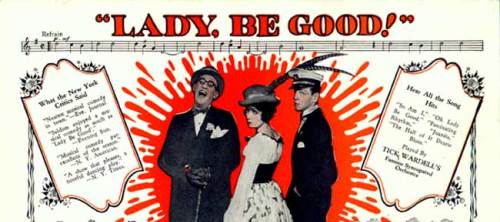
Musical
Musique: George Gershwin • Paroles: Ira Gershwin • Livret: Fred Thompson • Guy Bolton • Production originale: 6 versions mentionnées
Dispo: Résumé Commentaire Génèse Liste chansons
A tous points de vue, Lady, Be Good! a placé les frères George et Ira Gershwin ainsi que les frère et sœur Fred et Adele Astaire dans le panthéon des immortels du théâtre. Ce fut la première collaboration des frères Gershwin à Broadway.
Genèse: Création à Broadway (1924) Lady, Be Good est créé à Broadway au Liberty Theatre le 1er décembre 1924 et ferme le 12 septembre 1925 après 330 représentations. Le musical a été mise en scène par Felix Edwardes et une scénographie de Norman Bel Geddes. Il avait pour vedette les frère et sœur Fred et Adele Astaire. Création à Londres (1926) Le musical a ouvert dans le West End à l'Empire Theatre le 14 avril 1926, avec à nouveau Fred et Adele Astaire. Cela a aussi été un beau succès avec 326 représentations. Les chansons qui ont été les plus remarquées à Londres furent Oh, Lady be Good! et Fascinating Rhythm. Revivals La version de concert de The Encores! de Lady, Be Good s’est jouée du 4 au 8 février 2015. Dirigée par Mark Brokaw et chorégraphiée par Randy Skinner, la distribution met en vedette Tommy Tune et Douglas Sills, avec Danny Gardner et Patti Murin comme acteurs frère et sœur.
Résumé: Acte I: Quartier de Beacon Hill (Rhode Island) Expulsés dans la journée de leur vieille propriété familiale, Dick Trevor et sa sœur Susie se retrouvent le soir même à une fête organisée par la riche Joséphine 'Jo' Vanderwater. Ils y retrouvent notamment leur avocat, 'Watty' Warkins, ainsi que le musicien Jeff White. Il s'avère que Jo a "commandité" l'expulsion, espérant de cette façon "récupérer" Dick dont elle est amoureuse. Mais Shirley, l'amie de Dick, ne l'entend pas ainsi, ni Susie. Watty propose alors à cette dernière une combine lucrative, en se faisant passer pour la veuve de feu Jack Robinson, seul héritier de l'Hôtel du même nom ; de son côté, Dick annonce ses fiançailles avec Jo... Acte II: Trois jours plus tard à Eastern Harbor (Connecticut) Watty et la "veuve" rencontrent, à l'Hôtel Robinson, les membres du Conseil d'Administration. Dick se présente également, ignorant tout de la combine, et s'étonnant de la présence de sa sœur. Arrive aussi à l'hôtel un vagabond, dont Susie est tombée amoureuse à l'Acte I. Mais celui-ci est en réalité Jack Robinson que l'on croyait mort. Il "reconnaît" Susie comme son épouse, au moment où elle et Watty allaient être arrêtés. Plus tard, les protagonistes se retrouvent dans un Yacht Club, à une nouvelle fête où tout s'arrange, avec notamment des projets de mariages…
Création: 1/12/1924 - Liberty Theatre (Broadway) - 330 représ.
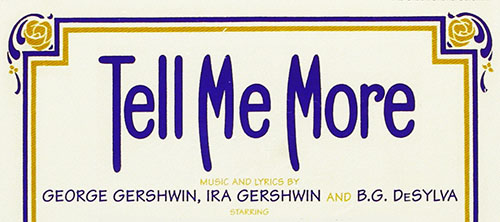
Musical
Musique: George Gershwin • Paroles: B.G. DeSylva • Ira Gershwin • Livret: Fred Thompson • William K. Wells • Production originale: 2 versions mentionnées
Dispo: Résumé Génèse Liste chansons
Genèse: Une comédie musicale négligée de 1925 qui tourne autour des enchevêtrements romantiques de trois couples, TELL ME MORE présente une partition remplie des sensibilités Jazz des frères Gershwin. 1925 a été une année chargée pour George et Ira, avec les premières de deux autres comédies musicales de Gershwin à Broadway et les débuts du CONCERTO IN F de George. L’absence de stars du calibre de Fred et Adele Astaire a peut-être limité le succès de TELL ME MORE à Broadway, mais la série a connu un grand succès à Londres, avec peu de changements structurels. Restauré sous les auspices des Trusts Ira et Leonore Gershwin et de la Bibliothèque du Congrès, TELL ME MORE a fait ses débuts en 2001 lorsqu’il a été publié sur le label New World Records.
Résumé: Lors d’un bal masqué à Manhattan, Kenneth Dennison, fils d’une des plus belles familles de New York, se tient dans une boîte surplombant la piste de danse, regardant une jeune fille vêtue de Pierrette. Il se demande comment l’approcher au mieux, mais il n’a pas à se demander longtemps, pour quelques instants plus tard, cette même Pierrette, qui a l’intention de visiter une fête dans la boîte attenante, ouvre la porte de Kenneth par erreur. Il se présente rapidement et avoue son engouement, et la fille, Peggy, flirte prudemment. Elle se démasque, et l’ambiance devient plus romantique, mais Peggy s’échappe, laissant Kenneth se demander quand ils se reverront. Il s'avère que Peggy est une ouvrière, une vendeuse à la Maison Elise, un établissement de meunerie intelligent sur la Cinquième Avenue. Après une brève nuit de sommeil, elle arrive au magasin le lendemain matin à temps pour assister aux arrivées habituelles: ses collègues vendeuses, Monty, le tailleur et enfin, son ancienne compagne d’école, Jane Wallace, qui vient faire un peu de shopping. Peg avoue à Jane combien ça a été dur pour elle depuis que son père est mort et l’a laissée sans le sou. Jane se demande si le frère de Peg, Billy, pourrait l’aider, mais hélas, Peg et Billy ont eu une dispute stupide après les funérailles et n’ont pas parlé depuis des mois. Gentiment, Jane invite Peggy à sa résidence d’été à Viewport, mais Peggy est trop fière pour accepter la charité. Kenneth entre dans le magasin, accompagné de son pote Billy. Billy supplie Kenneth de rencontrer sa sœur Margaret, mais Kenneth ne veut penser à personne d’autre que sa Pierrette — et son seul indice sur sa localisation est le masque qu’elle a laissé derrière elle, marqué « Propriété de la Maison Elise ». Alors que Billy erre, Kenneth espionne Peggy de l’autre côté de la pièce, et se réjouit que sa recherche se soit terminée si rapidement. Hélas, il doit aller à Viewport demain pour rendre visite à ses proches, mais les tourtereaux promettent qu’une fois Kenneth de retour, ils seront inséparables. Ce n’est pas le seul rendez-vous à la Maison Elise. Monty et Jane ont continué à se fréquenter pendant des mois, mais toujours en cachette. (Son père est un financier éminent, et la nouvelle que sa fille a succombé à un pauvre tailleur pourrait être trop dur pour son coeur.) Apprenant que Jane part pour Viewport, Monty prend son courage à deux mains et propose le mariage. Jane accepte, laissant les deux pour raconter la douleur que l’amour leur a causé. Dans une pièce voisine, Bonnie, une autre vendeuse, rencontre Billy. Il affecte l’air d’un cow-boy robuste afin de l’impressionner; elle est sceptique, mais heureuse de jouer le jeu. Et puis Jane revient avec une idée: Peg se rendra à Viewport avec elle et laissera Monty venir, se faisant passer pour son frère Billy. Comme ça, Jane et Monty pourront être ensemble, et sa famille n’en saura rien. Sentant que son amie a besoin de son aide (et conscient que Kenneth sera ainsi à Viewport), Peg est d’accord. Toutes les vendeuse et la clientèle de la Maison Elise apparaissent sur la scène pour célébrer l’optimisme des jeunes amoureux. Leur joie n’est que brièvement ébranlée par l’arrivée de la mère de Jane et un malheureux faux pas de Monty. Une semaine plus tard, le soleil brille sur le très à la mode Viewport. Jane se retrouve totalement dans son élément, tandis que Monty, très loin de son élément, gagne néanmoins sur la foule en racontant des histoires sur sa maison ancestrale. Peg et Kenneth se rapprochent, et même les pensées de Billy et Bonnie se transforment en romance. Mais quand Bonnie, toujours pipelette, raconte à Billy que Peggy est à Viewport avec un frère qui n’est pas vraiment son frère, Billy en tire la conclusion évidente. Toujours ami loyal, il informe Kenneth de la tromperie de sa Pierrette. (Billy est tout à fait satisfait de briser le couple; après tout, il est toujours engagé à réparer Kenneth avec sa sœur Margaret). Ken affronte Peg, mais elle est trop blessée par l’accusation pour lui dire la vérité. Les amants se disputent, et soudain, avec l’arrivée imminente du père de Jane, les trois relations semblent en danger. Les malentendus sont résolus quelques heures plus tard dans le jardin de l’hôtel où Bonnie a accepté un emploi de danseuse excentrique et Monty travaille comme serveur pour payer sa facture d’hôtel. Alors que Kenneth se lamente de son cœur brisé, Peg le prend en pitié et révèle les raisons de sa tromperie. La mère de Jane affirme sa position à la tête de la maison Wallace et bénit les fiançailles de sa fille avec Monty. Et alors que les trois couples célèbrent leur mariage imminent, Peg et Billy se rencontrent pour la première fois depuis des mois — « Billy! » «Margaret!» — et frère et sœur, eux aussi, sont réunis.
Création: 13/4/1925 - Gaiety Theatre (Broadway) - 100 représ.
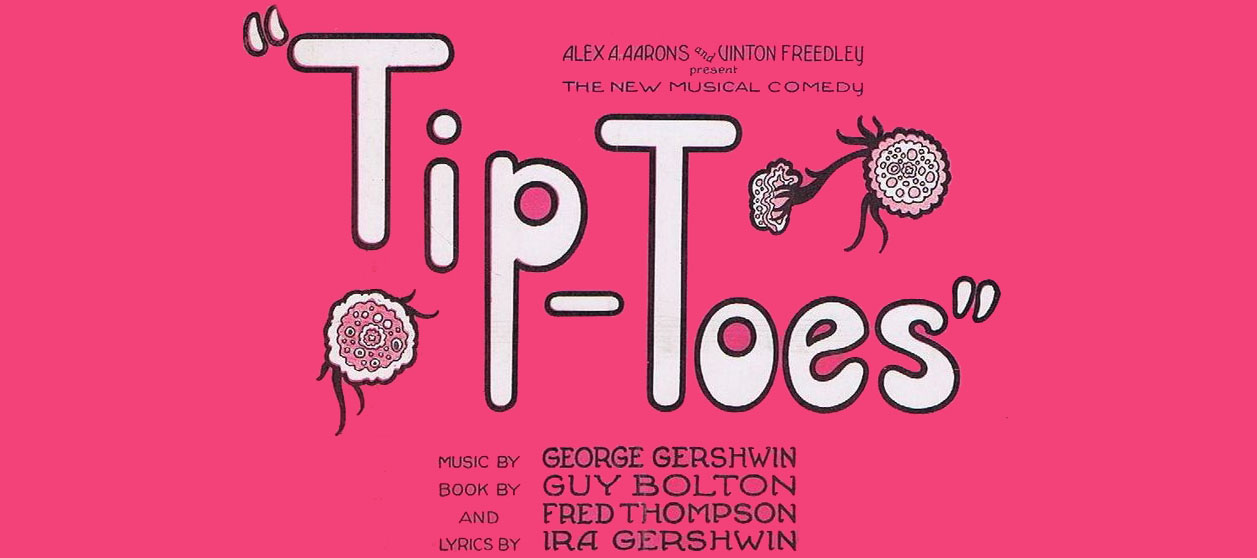
Musical
Musique: George Gershwin • Paroles: Ira Gershwin • Livret: Fred Thompson • Guy Bolton • Production originale: 3 versions mentionnées
Dispo: Résumé Génèse Liste chansons
Tip-Toes de George et Ira Gershwin n’a pas été le succès espéré après le triomphe de Lady Be Good (), mais il s'est joué presque six mois à Broadway et a fait des bénéfices, et la production londonienne s'est jouée pendant presque la même durée.
Genèse: Création à Broadway (1925) Tip-Toes a été produit par Alex A. Aarons et Vinton Freedley pour se moquer du boom immobilier de l'époque en Floride, qui était alors à son apogée. Ils ont réuni l’équipe créative de Lady Be Good (), qui avait été un succès l’année précédente avec Fred et Adele Astaire. La production a ouvert à Broadway au Liberty Theatre le 28 décembre 1925 et a tenu l'affiche 192 représentations. Ce ne fut pas du toutle succès espéré, surtout si on le compare à Lady Be Good () sans être un flop, même un échec. Il a été mis en scène par John Harwood. La distribution comprenait Queenie Smith comme Tip-Toes, Allen Kearns comme Steve Burton, Jeanette MacDonald comme Sylvia Metcalf, Andrew Tombes comme Al, et Harry Watson Jr. comme Hen. Création à Londres (1926) Une production dans le West End mettant en vedette Dorothy Dickson, Laddie Cliff, Allan Kearns, John Kirby, Vera Bryer, Peggy Beaty et Evan Thomas ouvre au Winter Garden Theatre le 31 août 1926 où elle se joue pour 182 représentations. Adaptation au cinema (1927) En 1927, le spectacle a été adapté au cinéma, l’un des derniers films muets, mettant en vedette Dorothy Gish comme Tip-Toes (orthographié Tiptoes dans le film) et Will Rogers comme Hen.
Résumé: Acte I Il y a un boom immobilier en Floride en 1925. À la gare de Palm Beach, Rollo Fish Metcalf est surpris d'apprendre que sa femme, Sylvia, désire organiser une fête pour son frère millionnaire, Steve, qui vient lui rendre visite. Il faut dire que Steve va hériter de l’usine familiale. Pour cette raison, Rollo accepte d’attendre les amuseurs vaudevilliens, les "Komical Kayes" (Tip-Toes, son frère Al et Oncle Hen), qui arrivent pour animer la fête de Steve. Mais il s’avère que Rollo a eu jadis un flirt avec Tip-Toes Kaye - qui n’a pas du tout été heureuse de découvrir qu’il était marié - et Sylvia a vu une photo incriminante du couple, permettant de reconnaître la jeune fille… Quand Rollo voit que Tip-Toes est l’une des interprètes de Vaudeville, il paie la troupe pour qu'ils partent. Mais les Kayes sont très pauvres. A un tel point que Tip-Toes a dû voyager dans les valises pour éviter de payer un billet de train. Ils décident de rester à Palm Beach afin de trouver un millionnaire pour que Tip-Toes puisse se marier et devenir riche (ils sont socialement ambitieux). Tip-Toes tombe sur Steve à la gare… Sylvia veut que son frère Steve paraisse plus sophistiqué. Alors elle lui présente deux jeunes filles, Binnie et Denise, qui lui donneront des leçons de danse, d’élocution, de musique, de golf et de bridge. Pendant ce temps, Tip-Toes (grâce à l'argent de Rollo elle pu s'acheter une robe et elle se fait passer pour une fille riche, "Roberta Van Renssalaer") joue un jeu au Palm Beach Surf Club qui la conduit à être embrassée par Steve, dont elle se souvient de la gare. Les deux sont immédiatement et puissamment attirés l’un à l’autre. Le frère de Tip-Toes, Al, rencontre Binnie et Denise, et ils décident tous d’aller au Blues Café. Al et oncle Hen se disputent après que Tip-Toes leur ait dit qu’elle ne voulait pas tromper Steve maintenant qu’elle en était vraiment tombée amoureuse. Tip-Toes est presque écrasée par une voiture et bien qu’elle ne soit pas gravement blessée, elle développe une amnésie et pense qu’elle est vraiment Roberta Van Renssalaer. Al et oncle Hen sont contents. Acte II Tout le monde se prépare pour la fête sur le yacht de Steve le lendemain soir. "Roberta" et Steve sont très heureux de s'êtrte trouvés l'un l’autre. Cependant, comme elle se croit riche suite à l'amnésie, elle dépense plus d’argent qu'en possèdent Al et oncle Hen. Afin de protéger son secret, Rollo dévoile la véritable identité de Tip-Toes à Steve qui déprime. Il confronte Tip-Toes, qui se souvient maintenant qui elle est, mais elle lui dit qu’elle l’aime vraiment et que ce n’est en rien lié à sa fortune. Steve lui révèle alors qu’il est en faillite. Il lui dit de s’en prendre à l’un des autres millionnaires à la fête. Tip-Toes reste à bord du yacht toute la soirée, et quand Steve revient, elle lui confirme qu’elle l’aime, même ruiné, et restera à bord toute la nuit "sans chaperon". Il est persuadé qu’elle dit la vérité. De retour à l’hôtel le lendemain, Tip-Toes paie la note d’hôtel de sa famille en exécutant une de ses danses pour les invités. Steve la demande en mariage et lui offre une bague de fiançailles. Elle est ravie, même si elle suppose que cette bague est fausse puisque Steve n’a plus d’argent. Mais il s’avère que c’est réel, parce que Steve est toujours millionnaire.
Création: 28/12/1925 - Liberty Theatre (Broadway) - 192 représ.

Musical
Musique: George Gershwin • Herbert Stothart • Paroles: Oscar Hammerstein II • Otto Harbach • Livret: Oscar Hammerstein II • Otto Harbach • Production originale: 2 versions mentionnées
Dispo: Résumé Génèse
L’opérette The Song of the Flame était un spectacle gargantuesque mis en scène à l’époque de la révolution russe. Le producteur Arthur Hammerstein dépensa une petite fortune pour la production, qui comptait environ 125 personnes dans la distribution (dont le Russian Art Choir et la troupe de l'American Ballet) et une cinquantaine de musiciens, dont une vingtaine de violonistes. Le spectacle s'est joué six mois à Broadway, et l'US Tour s'est joué dans cinq villes pour une tournée de deux mois et demi, mais les coûts de création et ceux importants de chaque représentation ont probablement empêché l’opérette de finir en bénéfice.
Genèse: Alors qu'il composait son Concerto in F et écrivait la partition du musical Tip-Toes () avec Ira (Tip-Toes a ouvert deux jours avant Song of the Flame), George s'est retrouvé dans l'équipe qui a produit cette opérette sur la révolution russe. On ne sait pas exactement comment Gershwin, Stothart, Harbach et Hammerstein se sont réparti le travail, mais George Gershwin n'aurait pas pu y consacrer beaucoup de temps, compte tenu de ses autres obligations. La production stylisée de SONG OF THE FLAME a eu un succès raisonnable, mais aucune des chansons n'a pu vivre en dehors du contexte du spectacle.
Résumé: Se déroulant pendant et après la Révolution russe, Song of the Flame se concentre sur Aniuta (Tessa Kosta), une noble qui mène une double vie de révolutionnaire et qui est connue de ses partisans sous le nom de «La flamme». Le prince Volodya (Guy Robertson) tombe amoureux d’elle, mais quand il découvre qu’elle est «La flamme», leur flamme d’amour vacille. Cependant, après la Révolution, les deux se retrouvent à Paris, et leur amour leur permet de mettre de côté les divergences politiques.
Création: 30/12/1925 - 44th Street Theatre (Broadway) - 219 représ.
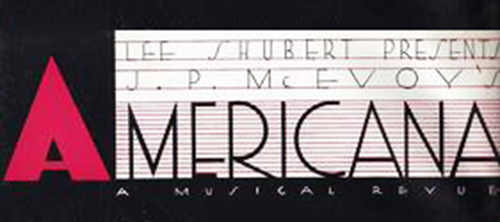
Revue
Musique: Con Conrad • George Gershwin • Henry Souvaine • Paroles: J.P. McEvoy • Livret: J.P. McEvoy • Production originale: 3 versions mentionnées
Dispo: Génèse
Americana is a musical revue in two parts.
Genèse: Broadway 1926 The show was presented by Richard Herndon at the Belmont Theatre (121 W. 48th Street, New York, NY), and, after many postponements, opened July 26, 1926. The show was staged by Allan Dinehart with dance numbers by Larry Ceballos. The production was designed by John Held, Jr. It ran for 224 performances, closing in February, 1927. The cast headlined Lew Brice, Roy Atwell, Betty Compton, Charles Butterworth and the Eddie Elkins Orchestra. The New York Times review called it a "witty, ingenious and sophisticated evening of fun-making, it made up in its abundant humor for more than it lacked in some other departments." The other departments referred to were lack of chorus girls and opulent settings. Broadway 1928 The revue was revived on October 30, 1928, at Lew Fields’ Mansfield Theatre for 12 performances, closing November 3, 1928. It had music by Roger Wolfe Kahn and lyrics by J. P. McEvoy and Irving Caesar. The cast included Frances Gershwin, the younger sister of George and Ira Gershwin. The New York Times review called it "a reasonably bright and generally entertaining revue . . ." Broadway 1932 After trying out in Philadelphia, the show was revived once again on October 5, 1932, at the Shubert Theatre running for 77 performances, until December 1932. It was produced by Lee Shubert and had music by Jay Gorney, Harold Arlen, Herman Hupfeld, and Richard Myers, with lyrics by E. Y. Harburg and sketches by J. P. McEvoy. It was directed by Harold Johnsrud with scenic design by Albert R. Johnson. The cast included Don Barclay, George Givot, Doris Humphrey Dance Group, Lloyd Nolan, and the Charles Weidman Dancers. It contained the famous song, “Brother, Can You Spare a Dime?”, which The New York Times review called "the first song of the year that can be sung ... Mr. Gorney has expressed the spirit of these times with more heart-breaking anguish than any of the prose bards of the day." The show was also favorably reviewed for its dance numbers.
Résumé:
Création: 26/7/1926 - Belmont Theatre (Broadway) - 224 représ.
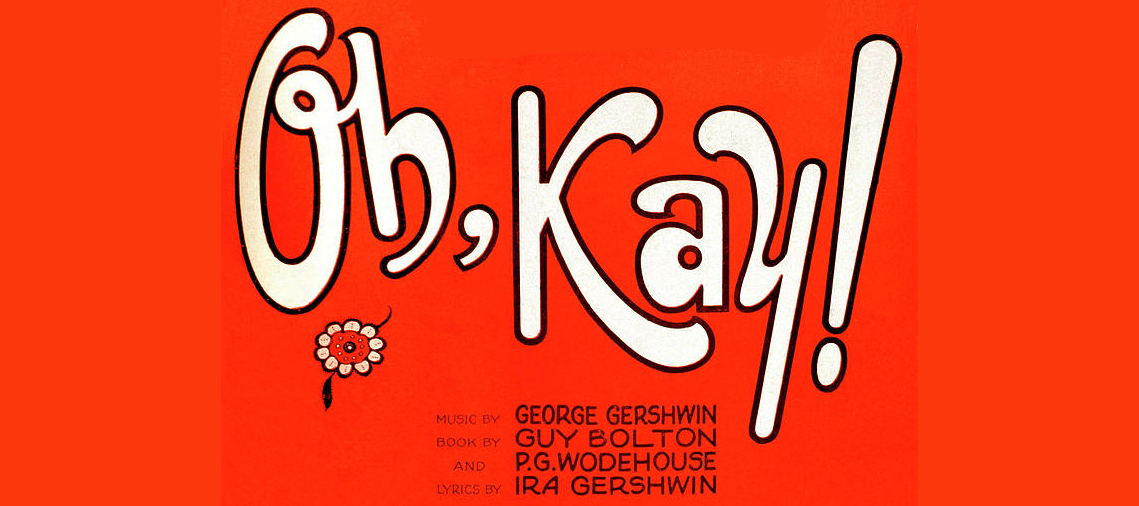
Musical
Musique: George Gershwin • Paroles: Ira Gershwin • Livret: Guy Bolton • P.G. Wodehouse • Production originale: 4 versions mentionnées
Dispo: Résumé Génèse Isnpiration Liste chansons
Oh, Kay! est un musical avec une musique de George Gershwin, des paroles d'Ira Gershwin et un livret de Guy Bolton et PG Wodehouse. L'intrigue tourne autour des aventures du duc de Durham et de sa sœur, Lady Kay, contrebandiers anglais en pleine prohibition américaine. Kay tombe amoureuse d'un homme qui semble indisponible. Le spectacle est connu pour sa chanson Someone to Watch Over Me.
Genèse: Création et Try-Out Les producteurs Alex A. Aarons et Vinton Freedly ont imaginé Oh, Kay! comme un spectacle qui aurait le style du Princess Theatre, avec un cadre contemporain, des décors simples et une histoire farcique. Gertrude Lawrence, qui a0vait joué dans les revues d'André Charlot de 1924 et 1925, a été choisie comme vedette avant que les chansons ou l’histoire aient été écrites. Conformément au processus créatif typique des premiers musicales américains, George et Ira Gershwin ont écrit la partition de Oh, Kay! avant que les librettistes, Bolton et Wodehouse, ne commencent à travailler sur le livret. Lorsque le livret a été achevé, huit chansons de la partition des Gershwins ont été coupées parce qu’elles ne pouvaient pas être facilement insérés dans le livret. Les représentations des Try-Out à Philadelphie ont duré plus de trois heures, et les producteurs ont donc coupé le prologue (mettant en valeur l'actrice vedette), perdant ainsi les 4 premières chansons, ainsi que Finaletto dans l'acte II. Cela a mis en évidence les éléments drôles de l’intrigue aux dépens des moments plus romantiques, puisque le personnage titre n’apparaît plus qu’après 40 minutes du spectacle. L’histoire a bien saisi l’esprit des Années Folles, mettant en vedette des décors et des personnages familiers au public du théâtre: un manoir décadent de Long Island et des trafiquants notoires (mais comiques). Pendant les répétitions, George Gershwin a acheté une poupée de chiffon dans un magasin de jouets de Philadelphie. La ballade Someone to Watch Over Me a été mise en scène avec Lawrence seule sur scène, serrant la poupée et chantant pour elle. C’était la chanson à succès de la série et est devenu un standard de Gershwin. Création à Broadway (1926) puis Londres (1927) Oh, Kay! a été créé le 8 novembre 1926 à l'Imperial Theatre de Broadway et joué 256 représentations. À Londres, il fut créé au His Majesty’s Theatre à partir du 21 septembre 1927 pour 213 représentations. Revivals Il fut repris au Century Theatre en 1928. Il a été rejoué en 1990 jouée au Richard Rodgers Theatre et au Lunt-Fontanne Theatre avec une distribution entièrement noire. En 1997, une version de concert de Discovering Lost Musicals est jouée au Barbican Theatre de Londres, en utilisant le scénario original (avec Louise Gold dans le rôle-titre). Il y a eu d’autres productions britanniques, dont une production de 1984 à Chichester, dirigée par Ian Judge et mettant en vedette Jane Carr dans le rôle de Kay et Michael Siberry dans celui de Jimmy. Jane How, Edward Hibbert et Gareth Valentine jouaient également dans cette production. Adaptations cinématographiques Oh, Kay! a été adapté en un film muet du même nom en 1928 mais jamais en film sonore. Un enregistrement du musicale fait en 1995, avec Dawn Upshaw, a restauré les chansons The Moon Is On the Sea, When Our Ship Comes Sailing In et Ain’t It Romantic, coupées de la production originale, et a replacé Someone to Watch Over Me à son endroit original, au début de l’acte I.
Résumé: Le fringant Jimmy Winter (Shaw) est un millionnaire qui possède un manoir riverain sur Long Island. Il est la plupart du temps absent car il a une vie romantique bien remplie qui le conduit à l’autel avec sa deuxième épouse, une fille snob de la société Constance Appleton (Sascha Beaumont). Un Lord britannique désargenté, connu sous le nom de The Duke (Gerald Oliver Smith), est devenu contrebandier d'alcool pour afin de se refaire une fortune grâce au dollar facile. Il utilise son yacht pour livrer l'alcool qu'il stocke dans la cave de Jimmy. Lorsque Jimmy rentre chez lui, plus tôt que prévu, avec sa nouvelle épouse, il hésite à faire appel à la justice parce qu’il est tombé amoureux de la sœur de Duke, Lady Kay (Lawrence), qui, avec le faux majordome de Duke, « Shorty » McGee (Victor Moore), fait partie de la bande de contrebandiers. Pendant ce temps, Jimmy découvre qu’il n’est pas légalement marié à Constance parce qu’il n’a jamais officiellement divorcé de sa précédente femme. Constance se défile alors, de vrais et faux agents des Impôts entrent et sortent de l’action, et tout finit bien par un mariage de Kay et Jimmy.
Création: 8/11/1926 - Imperial Theatre (Broadway) - 256 représ.
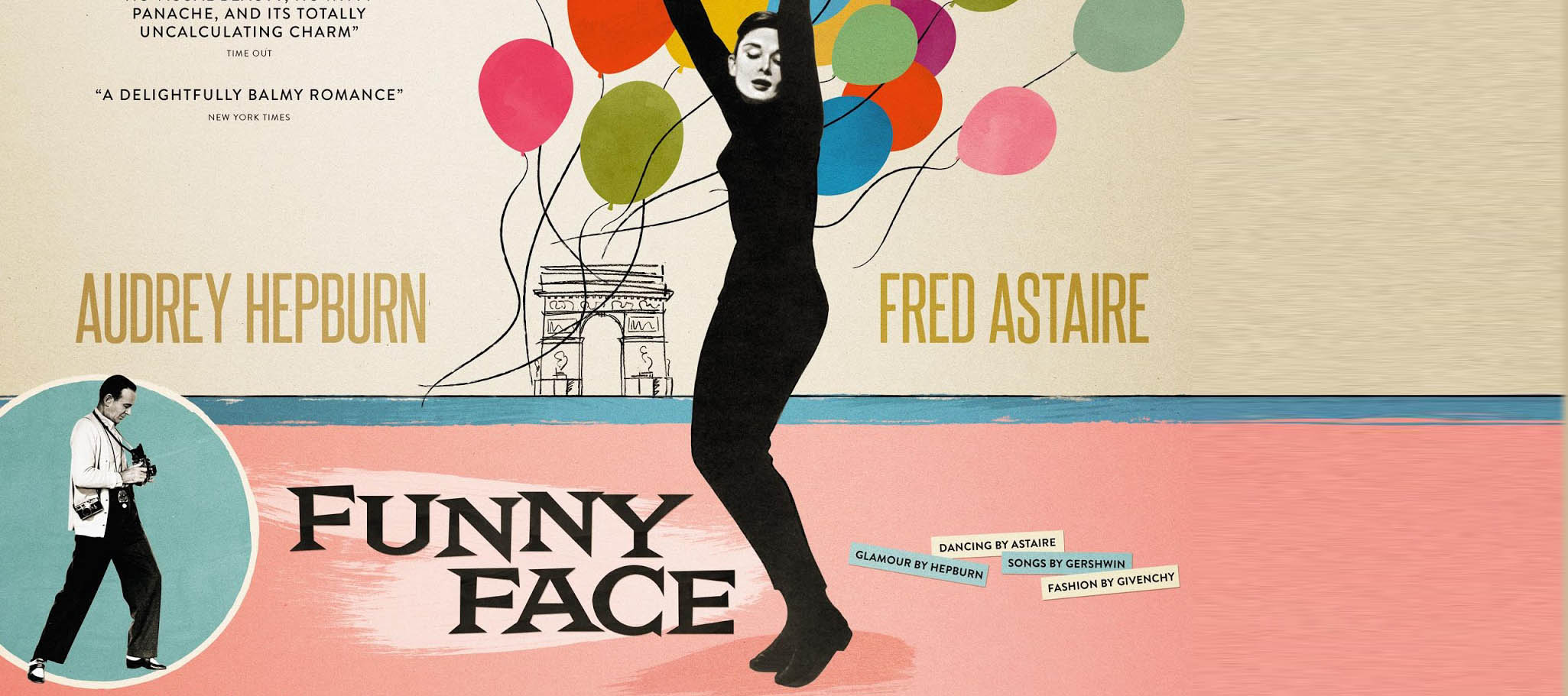
Musical
Musique: George Gershwin • Paroles: Ira Gershwin • Livret: Fred Thompson • Paul Gerard Smith • Production originale: 2 versions mentionnées
Dispo: Résumé Commentaire Génèse Liste chansons
Quand il a ouvert sur Broadway le 22 novembre 1927, Funny Face fut le spectacle qui a inauguré l'Alvin Theatre tout nouvellement construit. Il a mis en vedette Fred Astaire et sa sœur Adele Astaire. C’est dans ce spectacle que Fred Astaire a dansé pour la première fois en tenue du soir et avec un haut-de-forme. Ce succès de George et Ira Gershwin est un autre de ces musicals des années '20 empli d'une ribambelle de stars, de rebondissements nombreux et improbables et de danses … Le tout baigné dans une musique de l’époque. Peu de gens voyant cette production lisse et soignée à Broadway, peuvent imaginer qu'elle a traversé l'enfer pendant les Try-Out.
Genèse: Création et Try-Out Initialement appelé Smarty, le musical a ouvert en Try-Out à Philadelphie le 11 octobre 1927 et à reçu de très mauvaises critiques. Cela a rendu obligatoire une réécriture en profondeur de l'œuvre et au remplacement de Robert Benchley qui avait contribué au livret de Philadelphie. L'ouverture à Broadway a été postposée. Et les Try-Out vont s'enchaîner alors que les réécritures et les changements se poursuivent jour après jour. Le spectacle est présenté à Washington à partir du 31 octobre, à Atlantic City à ârtir du 7 novembre puis à Wilmington à partir du 14 novembre. Création à Broadway (1927) Le spectacle atteint Broadway le 22 novembre 1927 à l'Alvin Theatre. Il a change de nom et s'appelle maintenant Funny Face. Grâce à tous ces changements judicieux, le spectacle est devenu un succès majeur de Broadway de 244 représentations. Création à Londres (1928) A la fin de la série à Broadway, toute la troupe a transféré le spectacle à Londres au Princes Theatre dès le 8 novembre 1928, se jouant jusqu’au 29 janvier 1929. Après un court UK-Tour, le musical rouvrit ses portes au Winter Garden Theatre de Londres le 11 mars 1929, où elle se déroula jusqu’en juin 1929, soit un total de 263 représentations à Londres. Un vrai succès!
Résumé: Jimmy Reeve est le tuteur légal de trois jolies sœurs: Dora, June et Frankie. Il garde leurs biens précieux dans son coffre. Le collier de perles de June y est enfermé, tout comme le journal de Frankie confisqué par Jimmy. Mais ce journal contient des choses très compromettantes pour Frankie et elle convainc l’aviateur Peter Thurston de le voler dans le coffre. Mais comme les bijoux et le journal se trouvent dans des enveloppes identiques, il se trompe et vole les perles à la place, déclenchant une poursuite joyeuse qui emmène tout le monde à la jetée d’Atlantic City. Et pour rendre les choses encore plus compliquées, deux cambrioleurs maladroits, Herbert et Dugsie, tentent également de pénétrer dans le coffre-fort et sont emportés dans la poursuite.
Création: 22/11/1927 - Neil Simon Theatre (Broadway) - représ.
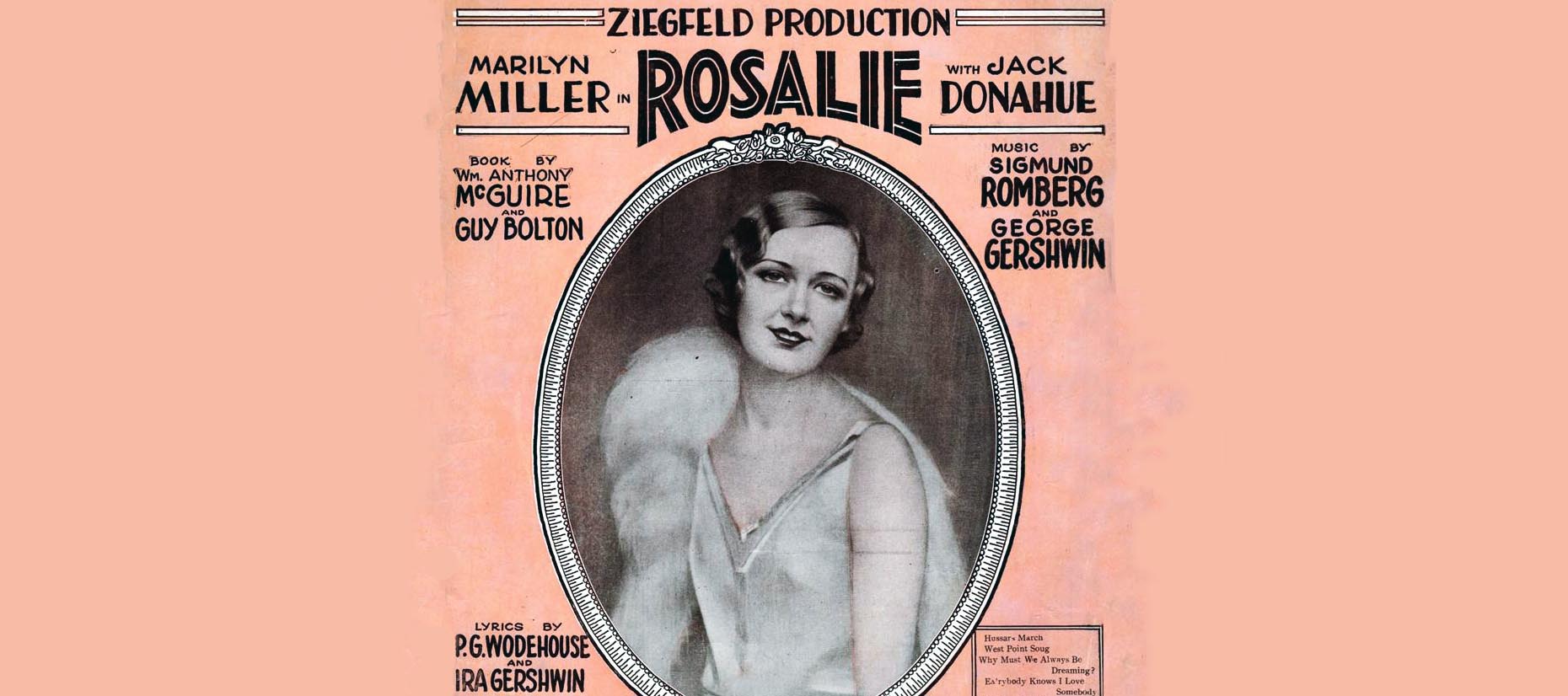
Musical
Musique: George Gershwin • Sigmund Romberg • Paroles: Ira Gershwin • P. G. Wodehouse • Livret: Guy Bolton • William Anthony McGuire • Production originale: Florenz Ziegfeld • 2 versions mentionnées
Dispo: Résumé Commentaire Génèse Liste chansons
L’histoire est celle d’une princesse d’un pays lointain qui vient en Amérique et tombe amoureuse d’un lieutenant de West Point. Il a été produit pour la première fois à Broadway en 1928 au New Amsterdam Theatre et adapté en 1937 au cinéma avec des chansons de Cole Porter.
Genèse: Création Deux mois après Funny Face, dont le succès est moindre qu’espéré, Ziegfeld décide de produire un nouveau musical, Rosalie (du nom de sa mère). Il a embauché son auteur préféré William Anthony McGuire pour rédiger le livret. McGuire a basé son histoire sur des faits réels: le tour du monde accompli par la reine Marie de Roumanie, la princesse Ileana et le prince Nicolas, s'arrêtant à West Point, mais aussi sur l’exploit du vol transatlantique de Charles Lindbergh. Le compositeur choisi par Ziegfeld est Sigmund Romberg. Mais ce dernier, en fonction des délais très courts imposés par le production, prévient qu’il ne parviendra pas à livrer toutes les chansons s’il reste le seul compositeur… Rien n’impressionnant Ziegfeld, ce dernier contacte le jeune George Gershwin qui accepte car, selon ses dires, «j’admire tellement Marilyn Miller (actrice principale et amante de Ziegfeld) et Jack Donahue que j’aimerais tant composer pour eux». Mais Gershwin est déjà sur un autre projet qui se décale et il va devoir revenir sur sa promesse. Ziegfeld va être direct et convainquant en lui envoyant un télégramme très clair: «Après ta promesse et vu les circonstances, Georges, ne penses-tu pas que tu pourrais composer trois ou quatre chanson pour le musical avec Marilyn Miller et Jack Donahue, que nous pourrions spécialement annoncer. Marilyn est si impatiente d’avoir une musique de toi à chanter et à danser, comme tu m’avais promis de le faire.» Gershwin a accepté de participer au spectacle. Loin des trois ou quatre chansons demandées par Ziegfeld, George et Ira en ont préparé au moins 17 et peut-être 3 ou 4 autres de plus – pas toutes utilisées, naturellement. Pour au moins huit d’entre elles, Gershwin a retravaillé des airs antérieurs, remontant jusqu’à «When the Mites Go By» (paroles, Clifford Grey) d’un musical non produit, Flying Island (1922), pour devenir le chœur «When Cadets Parade»; et «Wait a Bit, Susie» de Primrose (1924), avec de nouvelles paroles pour une chanson pour Dick et Rosalie, «Beautiful Gypsy». Il a aussi recyclé ou adapté des chansons de Lady, Be Good! («The Man I Love»), Oh, Kay! («Show Me the Town ») et Strike Up the Band («Yankee Doodle Rhythm»), ainsi que quatre chansons initialement destinées à Funny Face: «Dance Alone with You» (devenant «Ev’rybody Knows I Love Someone»), «When the Right One Comes Along» (devenant «Say So!»), «How long has this been going on?» et «Setting-Up Exercices». George Gershwin et Romberg n’ont co-composé que sur une seule chanson «Under the Furlough Moon». Par contre Ira Gershwin et Wodehouse ont co-écrit de nombreuses paroles de chansons. Try-out à Boston Lors des try-out à Boston au Colonial Theater, le 8 décembre 1927, Ziegfeld annonçait au public présent d’être «judicieux avec vos applaudissements car ils nous permettront de mieux savoir ce qu’il s’agit de couper avant d’arriver à Broadway». Mais le public a applaudi toutes les chansons avec enthousiasme. Une demi-heure de spectacle sera cependant supprimée. Création à Broadway Le musical a été créée à Broadway au New Amsterdam Theatre le 10 janvier 1928 et s’est joué durant 335 représentations. Mise en scène par William Anthony McGuire, la distribution met en vedette Marilyn Miller dans le rôle de la princesse, Frank Morgan dans celui de son père, le roi Cyril, Bobbe Arnst (Mary), Margaret Dale (la reine) et Jack Donahue. Le scénographe, Joseph Urban, et le costumier, John Harkrider, «ont conçu des tableaux de scène élaborés allant d’une place publique... à une salle de bal de West Point ou à une discothèque parisienne.» Michel Fokine chorégraphie le ballet du deuxième acte où il dispose d’un chœur de ballet de 64 danseurs!!! La presse est enthousiaste même si certains sont un peu ironiques comme Alexander Woolcott dasn World: «There comes a time once in every two or three years when the vast stage of that playhouse [the New Amsterdam] begins to show signs of a deep and familiar agitation. Down in the orchestra pit the violins chitter with excitement and the brasses blare. The spotlights turn white with expectation. Fifty beautiful girls in simple peasant costumes of satin and chiffon rush pellmell onto the stage, all squealing simple peasant outcries of “Here she comes!” Fifty hussars in a fatigue uniform of ivory white and tomato bisque march on in column [s/c] of fours and kneel to express an emotion too strong for words. The lights swing to the gateway at the back and settle there. The house holds its breath. And on walks Marilyn Miller.» Autres productions Malgré son succès originel, le musical Rosalie, à l'exception de quelques représentations dans de petites compagnies, n'a jamais été jouée à nouveau. Adaptation au cinéma En 1930, la MGM a engagé Wodehouse pour adapter Rosalie au cinéma pour le réalisateur Marion Davies, mais le projet est finalement abandonné, en partie à cause de l’intérêt déclinant pour les musicals, mais aussi peut-être à cause de l’indifférence de Davies pour l’œuvre. En 1936, après que le retour des films musicaux à la mode, le studio a de nouveau souscrit aux services de Wodehouse pour préparer une adaptation cinématographique. Le premier auteur, William McGuire, maintenant producteur du film, finira par réécrire lui-même le scénario. La MGM a commandé une nouvelle partition à Cole Porter, ce qui semble totalement inexplicable: mettre des chansons de Gershwin à la poubelle! Réalisé par W. S. Van Dyke, Rosalie (1937) met en vedette Nelson Eddy et Eleanor Powell avec Frank Morgan recréant son rôle de Broadway, et Ray Bolger dans le rôle de Donahue. L’histoire est restée très proche de la version de Broadway, reprenant une partie du dialogue original.
Résumé: Acte I Le musical ouvre sur une grande place devant le palais royal dans le pays fictif de Romanza. La foule se rassemble pour attendre l'arrivée d’un héros, le lieutenant aviateur Richard (Dick) Fay, un cadet de West Point («Here They Are»), qui vient rendre visite à une fille qu'il a rencontrée à Paris. Parmi la foule se trouvent deux Américains, l'ancien champion de boxe Michael O'Brien et sa fille, Mary qui attend elle son petit ami Bill, également cadet de West Point et ami proche de Dick. Mary est persuadée que Bill escortait le lieutenant Dick Fay lors de son vol héroïque («Show Me The Town»). Le Royaume de Romanza a pour roi Cyril de Romanza, un coureur de jupons. Son royaume est en grandes difficultés financières. Il tente lors d'une visite aux États-Unis d’obtenir un prêt pour son pays et sa femme projette de marier leur fille, la Princesse Rosalie avec le capitaine Carl Rabisco, fils du riche prince Rabisco et ami de la famille royale. Mais personne ne sait que notre héros aviateur, Dick, vient en fait rejoindre Rosalie, dont il ne connaît pas lui-même la condition de Princesse de Romanza! Lorsque Dick et Rosalie se rencontrent, ils se rendent compte qu'ils sont amoureux («Say So!»), mais quand Dick découvre qu'elle est une Princesse, il entre dans une terrible colère. Tout ce petit monde se rend aux États-Unis. Pendant ce voyage en mer sur le SS Isle de France, Rosalie et Bill se lient d’amitié («Let Me Be a Friend to You»). Dick a entre-temps été promu capitaine («West Point Bugle»). Sur la terrasse de West Point, les cadets saluent la fête royale («West Point March»). Dick et Rosalie ont dépassé le malentendu lié à la condition de Princesse de Rosalie et vivent un parfait amour («Oh Gee!-Oh Joy!»). Mais lorsque Dick rencontre la reine, les choses se passent très mal. Rosalie accepte les ordres de sa m ère d'épouser le capitaine Carl afin d’éviter toute condamnation («Kingdom of Dreams»). Afin d’éviter tout risque inutile, pendant la préparation du mariage entre Carl et Rosalie, la reine décide que Rosalie restera sur le bateau pendant le reste de leur séjour à West Point. Acte II Lors d'un bal à West Point («Opening Valse»), l’autre couple-vedette de ce musical, Mary et Bill, se chamaille à propos de la musique américaine («New York Serenade») que Mary adore. Pendant ce temps, le roi Cyril de Romanza en profite pour flirter avec différentes femmes («The King Can Do No Wrong»). Mary et Bill règlent leur désaccord sur la musique («Ev'rybody Knows I Love Somebody»). Rosalie, aidée de Bill, quitte sa retraite forcée sur le bateau et rejoint la salle de bal, déguisée en cadet («Follow the Drum»). Tous ses événements poussent Mary, isolée, à réfléchir sur la nature et la véracité des sentiments qu’elle a pour Bill («How Long Has This Been Going On?»). Rosalie, toujours en cadet, se réfugie dans la chambre de Bill. Dick et Rosalie se rendent compte que tant que Rosalie aura des obligations royales, leur relation sera impossible. Bill va leur donner un conseil pour le moins audacieux: retourner tous les deux à Romanza et tenter de lancer une révolution pour forcer le roi Cyril à abdiquer, ce qui libérerait Rosalie de facto de ses fonctions royales. La révolution échoue et les deux sont exilés à Paris. Au « Ex-Kings’ Club » à Paris, d’anciens monarques européens se rassemblent ( «At the Ex-Kings’ Club» ou «Tho’ Today We Are Flunkeys Simply»). Rosalie et un corps de ballet se produisent et divertissent l’assemblée («The ballet of flowers»). Coup de théâtre : le Roi Cyril annonce avec joie son abdication et autorise les fiançailles de Dick et Rosalie (« Finale »).
Création: 10/1/1928 - New Amsterdam Theatre (Broadway) - 335 représ.
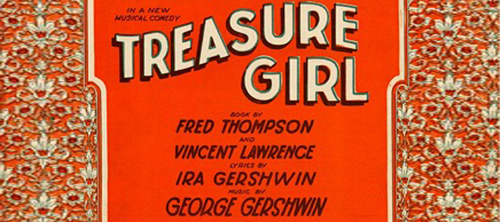
Musical
Musique: George Gershwin • Paroles: Ira Gershwin • Livret: Frederick A. Thompson • Vincent Lawrence • Production originale: 1 version mentionnée
Dispo: Génèse Liste chansons
Treasure Girl a tenté de recréer la magie de Oh, Kay! (), le hit des Gershwins en 1926 avec Gertrude Lawrence, mais le nouveau musical n’a pas été à la hauteur… Lawrence jouait une jeune femme gâtée participant à une chasse au trésor, et ce musical ne lui a pas donné beaucoup de moments pour montrer sa personnalité pétillante qui avait fait d'elle une star de Broadway. L'œuvre contient des chansons parmi les plus sous-estimées de Gershwin, dont le classique I’ve Got a Crush on You et le duo attrayant I Don’t Think I’ll Fall in Love Today. Une chanson oubliée de Treasure Girl, What Causes That? est devenue un tube pour Harry Groener et Bruce Adler dans My one and only () en 1983.
Genèse: Treasure Girl était le musical de la saison que tout le monde attendait… Les chansons étaient de George et Ira Gershwin, la first lady était la star Gertrude Lawrence, les chorégraphies étaient de Bobby Connolly, et les producteurs Alex. A. Aarons et Vinton Freedley n'ont reculé devant rien pour proposer une production somptueuse avec un décor de Joseph Urban et des costumes de Kiviette. Alfred Newman dirigeait l’orchestre, les célèbres pianistes Victor Arden et Phil Ohman étaient là pour un numéro de spécialité, et la troupe comprenait une impressionante galerie de personnalités de Broadway, dont Clifton Webb, Mary Hay, Walter Catlett et Paul Frawley. Les chansons comprenaient un des futurs grands classiques de Gershwin, I’ve Got a Crush on You mais comprenanit de nombreuses autres très belles chansons don’t Oh, So Nice!, I Don’t Think I’ll Fall in Love Today, K-ra-zy for You, Where is the Boy? Here the Girl!, Feeling I’m Falling, What Are We Here For? et What causes that?. Pourtant, le spectacle n'a tenu que deux mois à Broadway. Que s’est-il passé? Le problème majeur est le livret de Fred Thompson et Vincent Lawrence. Leur histoire était assez prometteuse: lors d’une fête costumée à Long Island, ambiance pirates, les invités sont invités à jouer à un jeu passionnant: leur hôte a caché un trésor de 100.000$ en espèces sur une île déserte à proximité. Parmi les invités, on trouve Ann Wainwright, jouée par Gertrude Lawrence, dont les auteurs ont fait un femme avare et désagréable qui se soucie seulement de l’argent. C'est drôle évidemment mais les critiques et le public étaient déçus de retrouver Lawrence, le chouchou de Broadway, dans un rôle aussi aigre, et apparemment peu a été fait pour adoucir le personnage pendant les trois semaines de Try-Out à Philadelphie.
Résumé:
Création: 8/11/1928 - Neil Simon Theatre (Broadway) - 68 représ.
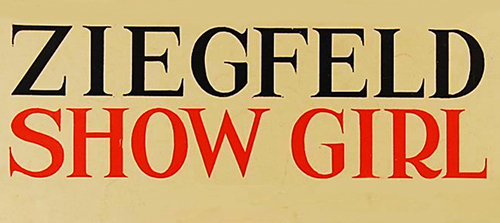
Musical
Musique: George Gershwin • Paroles: Gus Kahn • Ira Gershwin • Livret: William Anthony McGuire • Production originale: Florenz Ziegfeld • 1 version mentionnée
Dispo: Résumé Commentaire Génèse Liste chansons
Les Gershwins travaillaient dur sur un musical appelé East is West lorsque le producteur Florenz Ziegfeld a brusquement annulé le projet et l’a remplacé par cette adaptation du roman de J. P. McEvoy Show Girl. Ils ont eu besoin de l’aide de Gus Kahn comme parolier, parce que George et Ira étaient confrontés à des délais de création excessivement courts mais aussi à un livret terriblement incomplet. Le point culminant de Show Girl s’est produit lors des try-out à Boston quand Al Jolson assis dans le public a chanté avec Ruby Keeler – la first lady du show et sa nouvelle épouse – la chanson Liza. Il a continué à faire cela tous les soirs durant les premières semaines du spectacle de New York. L’échec financier de Show Girl a conduit Ziegfeld à cesser de payer les droits des Gershwin; ils se sont plaints et Ziegfeld a contre-attaqué en affirmant que George et Ira n’avaient pas livré un spectacle à succès. Le krach boursier à venir mettrait en grande partie fin à la carrière de The Great Ziegfeld.
Genèse: Selon Variety, Ziegfeld a jeté 150.000 $ dans la production de Show Girl, mais ce spectacle infaillible n’a pourtant pas été un succès et a quitté l’affiche en trois mois, malgré les rumeurs qu’avant son ouverture il avait déjà 20 semaines de représentations sold-out. Et pourtant, il y a avait les somptueux décors de Joseph Urban et costumes de John W. Harkrider, la musique était signée George Gershwin, les paroles ont été écrites conjointement par Ira Gershwin et Gus Kahn, les danses ont été conçues par Bobby Connolly et le livret était de William Anthony McGuire, qui avait écrit ceux des hits de Ziegfeld The Three Musketeers () et Whoopee! (). Et la star du show était la nouvelle Mme Al Jolson, autrement connue sous le nom de Ruby Keeler et Ruby Keeler Jolson (elle et Jolson s’étaient mariés près d’un an plus tôt, en septembre 1928, et divorceront en 1940). Elle avait laissé une impression favorable auprès des critiques et du public dans ses quatre apparitions antérieures à Broadway dans les chœurs ou même en vedette, et souvent en tant que danseuse principale («The Rise of Rosie O’Reilly», «Bye Bye», «Bonnie», «Lucky», et «Sidewalks of New York»), et Ziegfeld a voulu avec ce musical faire d’elle la prochaine reine de la comédie musicale à Broadway. Mais cela n’a pas tout à fait fonctionné de cette façon: les avis étaient mitigés à froids et elle a quitté le spectacle trois semaines après son ouverture (pour des raisons médicales non précisées…). Elle n’est revenue à Broadway que quarante-deux ans plus tard quand elle a triomphé en 1971 dans le revival à succès de No, No, Nanette de Vincent Youmans. Le cast de Show Girl comprenait également les populaires Lou Clayton, Eddie Jackson, et Jimmie Durante – ils triomphaient avec leurs numéros comiques dans les night-clubs – mais on tretoruvait aussi dans la distribution Nick Lucas, Eddie Foy Jr., Frank McHugh, Harriet Hoctor, Barbara Newberry, Joseph Macaulay et Doris Carson. Outre l’orchestre dans la fosse, on retrouvait sur scène rien de moins que Duke Ellington et son Cotton Club Orchestra. Et pour couronner le tout, la pièce orchestrale de Gershwin An American in Paris a été transformée en un somptueux ballet (ici intitulé American in Paris—Blues Ballet). Mais tout cet amoncellement très impressionnant n’a jamais décollé et a disparu en trois mois. Il a ouvert le 2 juillet, et quand Keeler s’est retirée de la production le 27 juillet, le musical a perdu la vedette sur lequel toute la publicité du show avait été construite. Le New York Times avait rapporté qu’en raison de problèmes de santé, Keeler serait remplacé par Dorothy Stone (qui avait assisté au show depuis le public pour la soirée d’ouverture quelques semaines plus tôt), mais resterait dans la production jusqu’à ce que Stone soit prête à assumer le rôle. Cependant, un article du 30 juillet dans le New York Daily News indiquait que Keeler s’était effondrée dans sa loge avant le spectacle du samedi soir, le 27 juillet, et qu’elle avait été admise à l’hôpital pour une opération «nécessaire pour lui sauver la vie». Doris Carson, qui était aussi l’understudy de Keeler, jouerait le rôle jusqu’à ce que Stone soit prête à intervenir. Le 2 août, le Times a déclaré que l’opération de Keeler avait eu lieu le 1er août, le jour même où Stone était arrivée à New York pour commencer les répétitions. Les critiques étaient assez bonnes, mais les lecteurs exigeants pouvaient lire entre les lignes et déduire que Show Girl n’était pas le spectacle de l’année et n’allait pas rejoindre les blockbusters appréciés de Ziegfeld: Sally (), Kid Boots (), Rio Rita (), Show Boat (), Rosalie (), The Three Musketeers () et Whoopee! (). Les critiques ont été particulièrement déçus par la partition la moins impressionnante de Gershwin, bien que les morceaux Liza et Do What You Do! aient été mentionnés favorablement. Mais aucune des chansons n’a jamais été un succès, et il était révélateur que les cinq chansons du spectacle pour Durante, Clayton et Jackson n’étaient pas de Gershwin mais de … Durante. En outre, Time a rapporté que la partition comprenait en plus deux autres chansons de Durante, qui n’étaient même pas répertoriées dans les programmes de Show Girl: Shades, Yellow Shades for the Window et Who Will Be with You When I’m Far Away?. Le spectacle a subi une révision drastique après l’ouverture. Cinq numéros ont été supprimés: le numéro des Albertina Rasch Dancers, How Could I Forget? (tous deux faisant partie du segment Magnolias), Lolita, My Love, Spain et Follow the Minstrel Band et quand Lucas a quitté le spectacle, son numéro a été coupé. Mississippi Dry a été ajouté pour la scène Magnolias où il a été interprété par Duke Ellington et Son Cotton Club Orchestra et les Jubilee Singers (qui a rejoint la distribution lorsque la chanson a été rajoutée). Comme indiqué, Keeler a quitté la série après environ trois semaines, tout comme Lucas.
Résumé: L’intrigue tournait autour de Dixie Dugan (Keeler), qui ne rêvait que d’une chose: être une star de la scène. L’histoire commençait par une scène d’une comédie musicale récente (imaginaire) de Ziegfeld appelée Magnolias, qui se déroule dans le Vieux Sud de la Virginie en 1863 où l’on découvre Durante dans un rôle blackface, Sombre Eyes. À partir de là, nous suivons les progrès de Dixie depuis le New Jersey, Brooklyn et Manhattan (y compris un arrêt au Club Caprice) jusqu’à la magnifique scène du Théâtre Ziegfeld et la production des Follies où elle devient une star (c’est pendant les séquences de Follies que l’on retrouve un ballet sur An American in Paris de Gerhwin et un numéro de Minstrel). En parallèle, quand Dixie n’est pas occupée à percer dans le show-business, elle est poursuivie par un trio d’hommes, dont Jimmy Doyle (McHugh), qui finira par gagner sa main.
Création: 2/7/1929 - Ziegfield Theatre (Broadway) - 111 représ.
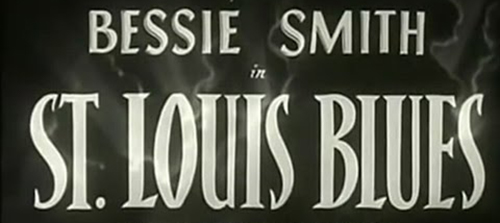
Film
Musique: George Gershwin • Paroles: Livret: Dudley Murphy • Production originale: 1 version mentionnée
Dispo: Commentaire
St. Louis Blues is a 1929 American two-reel short film starring Bessie Smith. The early sound film features Smith in an African-American speakeasy of the prohibition era singing the W. C. Handy standard, "St. Louis Blues". Directed by Dudley Murphy, it is the only known film of Bessie Smith, and the soundtrack is her only recording not controlled by Columbia Records.
Genèse:
Résumé:
Création: 5/11/1929 - *** Film (***) - représ.
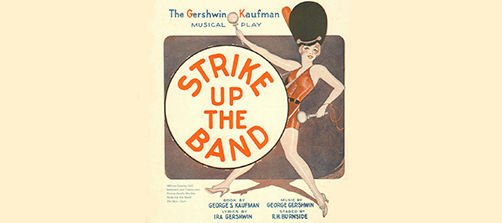
Musical
Musique: George Gershwin • Paroles: Ira Gershwin • Livret: Morrie Ryskind • Production originale: 1 version mentionnée
Dispo: Résumé Génèse Liste chansons
Strike Up the Band is a 1927 musical with a book by Morrie Ryskind, lyrics by Ira Gershwin and music by George Gershwin. It ran in Philadelphia that year, unsuccessfully, and on Broadway in 1930 after the original book by George S. Kaufman was revised. The story satirizes America's taste for war: America declares war on Switzerland over a trivial trade issue.
Genèse: Strike Up the Band is a 1927 musical with a book by Morrie Ryskind, lyrics by Ira Gershwin and music by George Gershwin. It ran in Philadelphia that year, unsuccessfully, and on Broadway in 1930 after the original book by George S. Kaufman was revised. The original book by George S. Kaufman centered on Horace J. Fletcher, a Babbitt-like cheese tycoon who tries to maintain his monopoly on the American market by convincing the United States government to declare war on Switzerland. The story ended darkly. The 1930 plot by Ryskind, softened the political overtones, increased the emphasis on romance and added a happy ending. It relegated the war plot to a dream sequence. The incident that incites war concerned chocolate instead of cheese. During its original 1927 pre-Broadway tryouts, the political satire closed in Philadelphia, fulfilling original librettist's George S. Kaufman's definition of satire as "what closes on Saturday night." The original is heavily influenced by Gilbert and Sullivan. The Gershwins revised the story with Ryskind for the 1930 Broadway run; they also removed the song The Man I Love, now a Gershwin standard, from the show. They added a dozen new songs and rewrote the lyrics or even changed the melodies of many of the 1927 songs. The new score is less Gilbert-and-Sullivan and more swing-influenced. Directed by Alexander Leftwich and choreographed by George Hale, the revised production opened on Broadway at the Times Square Theatre on January 14, 1930 and closed on June 28, 1930 after a moderately successful run of 191 performances. The Gershwins' first fully integrated score for a book musical was influenced by the operettas of Gilbert and Sullivan.
Résumé: Horace J. Fletcher is a manufacturer of chocolates who is aggrieved that Washington has refused to raise the tariff on Swiss chocolates. A doctor gives him a sedative to help him sleep and this he does but the sedative also induces dreams. In his dream he sees himself at the head of an American Army that foes to war with Switzerland over the issue of chocolates. The war was funded by Fletcher who becomes a national hero, but not for long. The American newspapers uncover the unsavoury fact that Fletcher's chocolates use Grade B milk - a fact that shocks the whole nation. Fletcher's daughter Joan has a fiancé, Jim Townshend . Jim is suspicious of Fletcher, and has been from the first time they met. He threatens to expose Fletcher which causes the latter to become an ardent pacifist. This about face comes too late, however, to stop America going to war against Switzerland. The Swiss hotel-keepers are delighted. They are able to raise the prices of their rooms as the American soldiers need lodgings. The war is somewhat phoney as there is never any engagement. The Americans sit in their hotels knitting socks and sweaters for the folks back home. Accidentally, the enemy's secret call to arms is discovered - a yodel - and the American troops are able to corner and rout the Swiss army.
Création: 14/1/1930 - Times Square Theater (Broadway) - 191 représ.
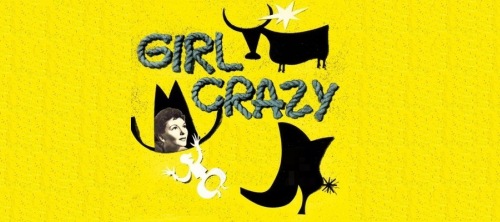
Musical
Musique: George Gershwin • Paroles: Ira Gershwin • Livret: Guy Bolton • John McGowan • Production originale: 8 versions mentionnées
Dispo: Résumé Synopsis Commentaire Génèse Liste chansons
"Girl Crazy" was written during the Depression, partly in an attempt to lighten the spirits of its audiences. Although the plot is frothy, the musical score is exquisite and features such enduring and beloved standards as "Embraceable You" and "I've Got Rhythm."
Genèse: The musical opened at the Alvin Theatre on October 14, 1930 and closed on June 6, 1931 after 272 performances. It was directed by Alexander Leftwich, with choreography by George Hale and sets by Donald Oenslager. This musical made a star of Ginger Rogers, who, with Allen Kearns, sang "Could You Use Me?" and "Embraceable You" and, with Willie Howard, "But Not for Me". Ethel Merman, in her Broadway debut sang "I Got Rhythm", "Sam and Delilah", and "Boy! What Love Has Done To Me!" and "became an overnight sensation...that launched her fifty year career." Also of note is the opening night pit orchestra, which was composed of many well-known jazz musicians, including Benny Goodman, Gene Krupa, Glenn Miller and Jimmy Dorsey. "The score was one of the Gershwins' best" according to theatre writer Ken Bloom. In 1992 it was produced with a new title as the stage musical Crazy for You. The show was heavily revised, with a completely new plot, and songs from other Gershwin shows added. "Musicals Tonight!", New York City, presented a staged concert in September 2001. An abridged version of Girl Crazy was presented at the Kennedy Center in Washington, DC October 2–5, 2008 as part of their Broadway: Three Generations production. Max von Essen played Danny, Jenn Colella played Molly, and Randy Graff played Kate, directed by Lonny Price. The New York City Center Encores! staged concert was held in November 2009. Directed by Jerry Zaks, it starred Ana Gasteyer, Marc Kudisch, Becki Newton, and Wayne Knight.
Résumé: According to his father, Danny Churchill Jr. too focused on girls and parties. Thus, Danny’s father ships him off to a mostly male town in Arizona with the goal of getting Danny’s attention focused on more serious matters. However, soon after arriving, Danny falls in love with the local postmistress, Molly Gray. He wins Molly’s affections – but can he beat off a New York rival?
Création: 29/9/1930 - Shubert Theatre (Philadelphia) - 272 représ.
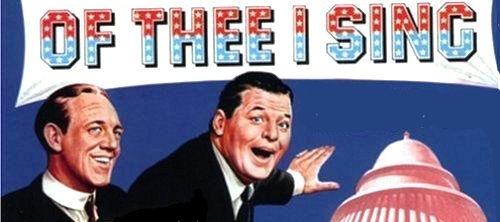
Musical
Musique: George Gershwin • Paroles: Ira Gershwin • Livret: George S. Kaufman • Morrie Ryskind • Production originale: 4 versions mentionnées
Dispo: Résumé Commentaire Génèse Liste chansons
Of Thee I Sing is a musical with a score by George Gershwin, lyrics by Ira Gershwin and a book by George S. Kaufman and Morrie Ryskind. The musical lampoons American politics; the story concerns John P. Wintergreen, who runs for President of the United States on the "love" platform. When he falls in love with the sensible Mary Turner instead of Diana Devereaux, the beautiful pageant winner selected for him, he gets into political hot water. The original Broadway production, directed by Kaufman, opened in 1931 and ran for 441 performances, gaining critical and box office success. It has been revived twice on Broadway and in concert stagings in the U.S. and in London. In 1932, Of Thee I Sing was the first musical to win the Pulitzer Prize for Drama.
Genèse: The Gershwins and George S. Kaufman had collaborated on a satirical musical in 1927 entitled Strike up the Band, which played in Philadelphia. The show concerned a cheese manufacturer who sponsors a war against Switzerland because it will be named after him. A version of Strike Up the Band, with the book altered by Morrie Ryskind, played on Broadway in early 1930. Much of the satire was replaced in the new version by silliness, leading Ryskind to recall, "What I had to do, in a sense, was to rewrite War and Peace for the Three Stooges." Later that year, Kaufman and Ryskind conceived a new musical focusing on satire about rival political parties battling over a new national anthem. The Gershwin brothers agreed to write the score, although they were scheduled to be in Hollywood writing songs for the film Delicious. Kaufman and Ryskind soon realized that their concept did not provide sufficient plot for a musical. They crafted a libretto inspired by the timeless battle of political idealism with corruption and incompetency, creating the first American musical with a consistently satiric tone. The writers and the cast were unsure of what the public's reception would be, prompting Kaufman's now-famous statement, "Satire is what closes on Saturday night." Productions The original Broadway production, directed by Kaufman, opened at the Music Box Theatre on December 26, 1931 and ran for 441 performances. The cast included William Gaxton as John P. Wintergreen, Lois Moran as Mary Turner, Grace Brinkley as Diana Devereaux, Victor Moore as Alexander Throttlebottom and George Murphy as Sam Jenkins. It was produced by Sam H. Harris. Sets were designed by Jo Mielziner, costumes by Carles LeMaire, and dances staged by Georgie Hale. It was Gaxton and Moore's first comedic pairing; they would collaborate on six more Broadway musicals, including Anything Goes. The orchestrations were by Robert Russell Bennett, William Daly (including the "Overture"), and Gershwin ("Hello, Good Morning"). Of Thee I Sing was the longest-running Gershwin show during George Gershwin's lifetime. There were Broadway revivals in 1933 at the Imperial Theatre and in 1952 at the Ziegfeld Theatre, both directed by Kaufman. A concert production of Of Thee I Sing was mounted by Ian Marshall Fisher's Lost Musicals series at the Barbican Centre in London in August 1996. Fisher's series examines the Gershwins' lesser known works (as well as others) and has been based at London's Royal Opera House and Sadler's Wells. The musical was presented in May 2006 as part of the New York City Center Encores! staged concert series. Directed by John Rando and choreographed by Randy Skinner, the cast starred Victor Garber as John P. Wintergreen, Jefferson Mays as Vice President, Alexander Throttlebottom, and Jennifer Laura Thompson as First Lady. The latest revival was in July 2015 at the Royal Festival Hall, London by producer Ollie Rosenblatt as a full musical with orchestra. Diana Devereaux was played by Hannah Waddingham, Wintergreen by Hadley Fraser and Throttlebottom by Tom Edden. The Royal Philharmonic Concert Orchestra provided the new musical setting for the piece. In September 2015 the Sqabbalogic theatre company and Sydney Philharmonia Choirs presented the musical in the Concert Hall, Sydney Opera House.
Résumé:
Acte I
In the U.S. in the 1930s, a campaign parade is taking place to support Wintergreen for President. John P. Wintergreen has been nominated for President and Alexander Throttlebottom has been nominated for Vice President, but he is of such little importance no one can remember who he is. Politicians meet in a hotel room to devise a campaign platform, and when they ask the chambermaid what she cares about, she first says "money," then "love" when pressed further. The men decide that Wintergreen's platform will be "love;" they'll have a pageant to select the most beautiful girl in the United States, and Wintergreen will fall in love and marry her. The pageant begins in Atlantic City, New Jersey, and the contestants wonder, Who is the Lucky Girl to Be? The photographers assure them that even if they do not win, they will surely be loved (The Dimple on My Knee). Wintergreen is getting nervous about marrying a girl he doesn't know. While the girls are at the final judging, he confides in Mary Turner, the sensible young woman running the pageant. He does not want to marry a girl just because she's beautiful; he wants a wife who will make a good home for him and his future children. Mary shares her corn muffin with him. Wintergreen tells Mary that he'd rather marry her than any of the girls in the contest. He kisses her, and she agrees to marry him. The judges of the pageant announce that Diana Devereaux, a beautiful southern girl, has won the contest, but Wintergreen declares that he loves Mary Turner. When he gives some of Mary's extraordinary corn muffins to the judges, they agree that John and Mary are meant to wed (Because, Because). Outside Madison Square Garden in New York City, at a rally for Wintergreen, the campaigners declare that Love is Sweeping the Country. Inside, where politicians are speaking in favor of Wintergreen, a wrestling match is going on just below the speakers' platform as Alexander Throttlebottom tries to explain to the organizers that he's the candidate for Vice-President. Wintergreen proposes to Mary onstage, as he has in forty-seven states before. She accepts again, and Wintergreen sings the campaign song to her, Of Thee I Sing. On election night, Wintergreen wins by a landslide. Inauguration day arrives, which is also Wintergreen's wedding day. As his inaugural address, Wintergreen bids goodbye to the girls he used to know (Here's a Kiss for Cinderella). The Chief Justice presides over the wedding ceremony, and just after he has pronounced John and Mary man and wife, Diana Devereaux interrupts the proceedings. She is serving Wintergreen with a summons for breach of promise. She insists she is the one he should have married (I Was the Most Beautiful Blossom). The Supreme Court rules that Mary's corn muffins are more important than justice in this matter, and Diana angrily leaves to tell her story across the nation. Wintergreen leads the Supreme Court and spectators in a chorus of Of Thee I Sing.Acte II
John and Mary settle down to business in the White House. Her "desk," back-to-back with his, is a fully loaded tea-table. Their secretaries greet each other "Hello, Good Morning." Alexander Throttlebottom, now Vice-President, sneaks into the White House with a tour group. When a guide tells him that the Vice-President's job is to preside over the U. S. Senate, Throttlebottom eagerly dashes off to the Capitol. Wintergreen's fellow party members inform him that Diana Devereaux is gaining support across the nation. Wintergreen holds a press conference and tells the reporters that his love for Mary is the only thing that matters (Who Cares?). The French ambassador unexpectedly arrives (Garçon, S'il Vous Plaît). He has a surprise for Mr. Wintergreen: Diana is "'The Illegitimate Daughter' of the illegitimate son of the illegitimate nephew of Napoleon." He insists that Wintergreen annul his marriage and marry Diana to right his grievous offense against France. Everyone agrees that Wintergreen should be impeached for breach of promise (We'll Impeach Him), but John and Mary do not care, since they have each other (Who Cares?" (Reprise)). Throttlebottom has found the Senate, and the party members inform him that he will soon be President. He is very excited and goes into the Senate Chamber to preside, beginning by taking "The Roll Call." The resolution on the impeachment of the President is brought up, and the French Ambassador and Diana mournfully insist that she was Jilted. Mary saves the day when she announces that she is pregnant (Who Could Ask For Anything More?). The senators refuse to impeach an expectant father, and Wintergreen declares that Posterity is just around the corner. The French Ambassador informs Wintergreen that by not marrying Diana, he has contributed to France's declining birth rate. He demands the Wintergreens' baby as a replacement for the one they have "taken" from France. John refuses, and the ambassador walks out. In the Yellow Room of the White House, guests are arriving bearing gifts for the baby (Trumpeter, Blow Your Horn). Wintergreen is nervously awaiting the baby's birth when the French Ambassador arrives with a final message from France: surrender the baby or France will sever diplomatic relations with the U.S. The Supreme Court justices, who have the duty to determine the sex of the baby, announce that twins have been born, a boy and a girl. The French ambassador is even more wounded by this proclamation: France has lost two babies instead of one! Diana mournfully joins him, and Alexander Throttlebottom arrives bearing sweaters for the babies. The French Ambassador is about to declare war when Wintergreen has a brilliant idea: according to Article Twelve of the Constitution, when the President of the United States is unable to fulfill his duties, his obligations are assumed by the Vice-President! The ambassador calls Wintergreen a genius, and Throttlebottom is ecstatic as they pass Diana over to him. Servants wheel a large bed into the room, where Mary sits with the babies. Wintergreen leads everyone in proclaiming, "Of Thee I Sing."Création: 26/2/1931 - Music Box Theatre (Broadway) - 441 représ.
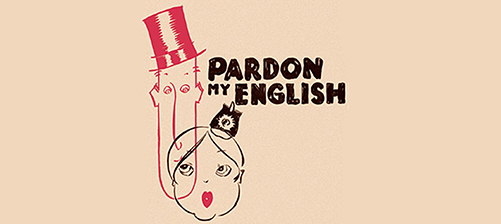
Musical
Musique: George Gershwin • Paroles: Ira Gershwin • Livret: Herbert Fields • Morrie Ryskind • Production originale: 1 version mentionnée
Dispo: Résumé Génèse Liste chansons
Genèse: Producers Alex A. Aarons and Vinton Freedley approached the Gershwins to create a showcase for the talents of English music hall star Jack Buchanan, and linked them with Fields and Ryskind, whose book required the actor to appear in dual roles, lower-class German thug Golo Schmidt and upper-crust British nobleman Michael Bramleigh. The sophisticated Buchanan had no problem portraying Bramleigh but was unable to capture the essence of Schmidt. The show opened in Philadelphia to critical pans. Rather than proceed to Broadway, the creative team added characters and expanded the role of police commissioner Bauer, played by radio's "Baron Munchausen", Jack Pearl. The revised production opened in Newark on January 2, 1933, but it was obvious that Buchanan was still a major problem. He bought out his contract and the producers replaced him with dialect comedian George Givot. The production opened on Broadway on January 20, 1933, at the Majestic Theatre and ran for 43 performances. The book was directed by John McGowan, the production was staged by producer Vinton Freedley, and the musical numbers were staged by George Hale. In addition to Givot and Pearl, the cast included Josephine Huston as Bauer's daughter Ilse and musical-comedy star Lyda Roberti (her speciality was a "polyglot of Polish, German, and near-Hungarian") as Gita Gobel. According to Ben Brantley, "By the time it hit Broadway it was a desperately stitched patchwork that ran for 33 performances before exiting into oblivion. It was, Ira Gershwin later wrote, 'a headache from start to finish'." The critics unanimously condemned it. In 1982, a producer discovered a number of the musical's manuscripts in the Warner Brothers warehouse in Secaucus, New Jersey. The score was pieced together and performed at the Library of Congress in concert in 1987. Elektra Records released a studio cast album featuring John Cullum and William Katt in 1993. New York City Center's Encores! presented a staged concert in 2004, with a revised book by David Ives. Directed by Gary Griffin and choreographed by Rob Ashford, it featured Brian d'Arcy James as Golo/Michael, Emily Skinner as Gita, Jennifer Laura Thompson as Frieda (originally Ilse), and Rob Bartlett as Bauer. 42nd Street Moon, San Francisco, California, presented a staged concert in November 2006. The European premiere took place on November 29, 2009, at the Dresden State Operetta in Dresden, translated by Wolfgang Adenberg, directed by Holger Hauer and conducted by Ernst Theis.
Résumé: In order to promote the sale of beer and wine, the German government bans the sale of all non-alcoholic beverages. In retaliation, Golo Schmidt opens Club 21, a speakeasy where patrons can imbibe such forbidden drinks as cream soda and ginger ale. Police Commissioner Bauer makes it his mission to shut down the illegal operation. Golo decides to disrupt a birthday celebration for Bauer, but while en route to the party he is struck by a car and knocked unconscious. When he awakens in Bauer's home, he believes he is Michael Bramleigh, a wealthy, sophisticated member of British society. He eventually falls in love with Bauer's daughter Ilse and proposes marriage. A birdhouse falls on Bramleigh, and his memory returns. Golo once again, he has no memory of his relationship with Ilse and returns to Club 21 and his sweetheart Gita Gobel. Hearing Bauer's daughter is about to marry, he plans to kidnap the bride and hold her for ransom. At the wedding, Golo locates Ilse, who naturally thinks he's her fiancé Michael, and the two escape to an inn in Schandau. Golo, inexplicably thinking he's Michael once again, returns to Bauer's house and apologizes for missing the wedding. The two plot to find Ilse and save her from her kidnapper. Recognized as Golo by some and Michael by others, the hero becomes involved in a series of comic misadventures.
Création: 20/1/1933 - Majestic Theatre (Broadway) - représ.
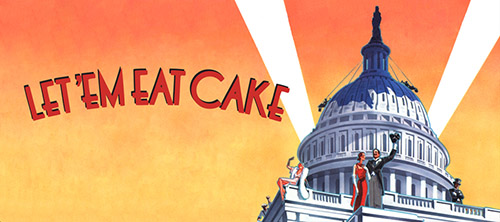
Musical
Musique: George Gershwin • Paroles: Ira Gershwin • Livret: George S. Kaufman • Morrie Ryskind • Production originale: 1 version mentionnée
Dispo: Résumé Génèse Liste chansons
Genèse: The original Broadway production of Let 'Em Eat Cake opened October 21, 1933 at the Imperial Theatre, New York City, USA and ran for 89 performances. It had The cast included William Gaxton as J.P. Wintergreen, Victor Moore as Alexander Throttlebottom, Philip Loeb as Kruger, and Lois Moran as Mary Wintergreen. The no longer extant orchestrations were by Edward B. Powell. The show carried a message that audiences did not want to hear and it was a failure. However, it did have one song: "Mine". Several musical themes from Of Thee I Sing are reused in Let 'Em Eat Cake, including the Supreme Court Judges' song and the campaign song "Wintergreen for President", which includes parts of folk and patriotic songs such as Sousa's "Stars and Stripes Forever", and "Hail, Hail, the Gang's All Here." A concert version of the show was performed on BBC Radio in 1994 (with a cast that included: Denis Quilley, Kim Criswell, Joss Ackland, Henry Goodman, and Louise Gold), and Opera North staged the show, along with a revival of Of Thee I Sing, during its 2008–9 season. The Opera North production was broadcast by BBC Radio 3 on Saturday, 26 September 2009, as part of its Opera on 3 series.
Résumé:
Acte I
President Wintergreen is up for reelection, but due to the continuing Great Depression, loses in a landslide to John P. Tweedledee. Wintergreen makes an unsuccessful appeal to the Supreme Court to overturn the election results. It is also revealed that Diana Deveraux divorced Throttlebottom to marry the French Ambassador. After the end of his term, Wintergreen, Throttlebottom, and their associates start a business selling his wife Mary's blue shirts on "Union Square." At Union Square, Kruger, an agitator, is proclaiming his doctrine "Down with Everything That's Up." After talking with Kruger, Wintergreen decides that to increase shirt sales they should promise a revolution or their money back, citing the European Brown Shirts and Black Shirts. With business now booming ("Shirts by Millions"), Mary appeals to the women to join the New Blue D.A.R. ("Climb up the Social Ladder") to increase female shirt sales. Wintergreen now needs the support of the Union League Club, because General Snookfield is a member. Throttlebottom persuades them by saying that the British are attacking Bunker Hill ("Comes the Revolution Reprise"). Having secured the Union League Club support, The Blue Shirts meet with Snookfield to plan the overthrow of the government ("On and On and On"). At nine o'clock on July 4, when the Blue Shirts arrive, Snookfield will give the signal for his soldiers to seize Tweedledee. On the Fourth, at the White House grounds, Tweedledee is giving a speech, when Snookfield leaves with Trixie for a party. The Blue Shirts arrive only to find the general is missing and the soldiers don't know what to do. Tweedledee promises the army a "dollar a day which (he) may not pay." Wintergreen promises the army the war debts owed by the League of Nations, which the soldiers accept. Tweedledee is deposed, and Wintergreen declares that "the land of freedom is free once more" ("Let 'Em Eat Cake").Acte II
The White House is being painted "Blue, Blue, Blue." The Supreme Court, now in chains, are brought before Wintergreen. He decides to show leniency because the Court officiated his marriage ceremony. The Court is reorganized into a baseball team. When the League of Nations arrives to discuss repayment of the war debts, they "No Comprenez, No Capish, No Versteh" when the issue is raised; only Finland repays their debt. Kruger, now head of the army following Snookfield's disgrace, is also putting pressure on Wintergreen to remember his promise. Wintergreen offers a solution where the debts will be settled by a baseball game for double or nothing. If the League loses, they will have another conference to discuss it. Kruger accepts the League's offer of Finland's money as a side bet. Throttlebottom hesitatingly accepts an offer to be the game's umpire. On the date of the ballgame the Supreme Ball Players, the League, and Kruger's army try to influence Throttlebottom to bend the rules their way. The United States loses the game after a controversial call by umpire Throttlebottom. The soldiers want someone to be held to account for the loss, over Wintergreen and his associates' objections ("Oyez, Oyez, Oyez"). In the "Trial of Throttlebottom" a military tribunal is underway. Kruger, the Army, and the Ball Players call for Throttlebottom's execution claiming he conspired with the enemy. Wintergreen and his associates object, until the army levels the guns at them. Kruger and the army want to know when they are going be paid ("A Hell of a Hole"). After Wintergreen offers them a share of the shirt business, the army is going to take it all (Down With Everything That's Up—Reprise). Despite pleading he tried his best to get the money ("It Isn't What You Did"), Kruger sentences Wintergreen and his cronies to death by beheading. Mary and the condemned's wives enter and proclaim they are pregnant. Kruger says this may have worked four years ago during Wintergreen's impeachment hearings, but it doesn't work with the army. Trixie, who controls the Navy, arrives and joins forces with Kruger ("First Lady and First Gent"). Kruger proclaims "Let 'em Eat Caviar." Execution day arrives, and in their jail cell Wintergreen, Throttlebotton, and the Committee discuss how they ended up in this situation. Next, the crowds gather to watch the executions ("Hanging Throttlebottom in the Morning"). A guillotine bought from France is unveiled, and Snookfield is shown to be the executioner. Since Throttlebottom is not married, he will be executed first. After a series of mishaps with the guillotine, Mary interrupts the proceedings. She presents a "Fashion Show" with dresses that arrived on the boat that brought the guillotine. After being reminded that the color of the revolution is blue, and they cannot wear the new fashions, the women revolt. Kruger objects, but the soldiers seize him after Trixie reminds them of an upcoming party. Wintergreen tells the soldiers to shoot Kruger. When Kruger reveals he used to be in the dress making business, Wintergreen decides to go into business with him. Wintergreen decides to leave the revolution business and restores the republic and the Supreme Court. Tweedledee shows up and Wintergreen gives his vice-president, Throttlebottom, to him, since he can't remember his. Tweedledee declines the Presidency, since he is going to be President of Cuba. Throttlebottom is now the President. After Wintergreen promised the people cake and Kruger promised them caviar, Throttlebottom promises them pistache ice cream, which he formerly detested.Création: 21/10/1933 - Imperial Theatre (Broadway) - 90 représ.
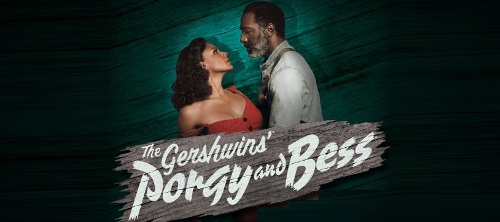
Musical
Musique: George Gershwin • Paroles: DuBose Heyward • Ira Gershwin • Livret: DuBose Heyward • Production originale: 23 versions mentionnées
Dispo: Résumé Commentaire
il aura fallu attendre les années 1980 pour que Porgy and Bess soit reconnu aux États-Unis comme un véritable opéra. Au XXIe siècle, c'est un classique du répertoire lyrique américain. Musicalement, Porgy and Bess réussit une synthèse innovante entre les techniques orchestrales européennes, le jazz américain et la musique populaire.
Genèse:
Résumé:
Acte I
Scène 1 - Catfish Row, un soir d'été
L'opéra commence par une petite introduction très vivace (Allegro con brio). Le rideau s'ouvre sur un soir d'été à Catfish Row. Jabso Brown joue du piano et Clara chante une berceuse pour son enfant (Summertime) pendant que les hommes se préparent à jouer au craps. Le mari de Clara, Jake, tente lui aussi de chanter une berceuse (A woman is a sometime thing), qui n'apaise guère le bébé. Porgy, un mendiant estropié, arrive pour organiser le jeu. Crown, un voyou, et sa femme Bess entrent, et le jeu commence. Sportin' Life, fournisseur de cocaïne et d'alcool de contrebande, prend lui aussi part au jeu. Petit à petit les joueurs quittent le jeu, et il ne reste plus que Robbins et Crown. Lorsque Robbins gagne, Crown, qui est maintenant complètement ivre, commence à se battre, et finit par tuer Robbins. Crown s'enfuit, demandant à Bess de se débrouiller toute seule. Tout le monde l'abandonne, sauf Porgy, qui la protège.Scène 2 - Chambre de Serena, la nuit suivante
La famille et les amis de Robbins chantent un spiritual (Where is brudder Robbins?). Une soucoupe est posée sur sa poitrine pour récolter de l'argent pour son enterrement. Un détective blanc entre, et dit à Serena, la femme de Robbins, qu'elle doit enterrer son mari rapidement, si elle veut éviter que le corps soit donné à des étudiants de médecine. Il arrête Peter, un badaud, qu'il oblige à témoigner contre Crown. Serena pleure la perte de son mari (My man's gone now). L'ordonnateur des pompes funèbres entre et accepte d'enterrer Robbins si Serena promet de le payer plus tard. Bess et le chœur terminent l'acte avec Leavin' for the Promise' Land.Acte II
Scène 1 - Catfish Row, un mois plus tard, le matin
Jake et les autres pêcheurs s'apprêtent à travailler (It take a long pull to get there). Clara demande à Jake de ne pas y aller, et de venir plutôt à un pique-nique. Mais Jake lui répond qu'ils ont terriblement besoin de cet argent. Cela pousse Porgy à chanter son point de vue sur la vie de sa fenêtre (I got plenty o' nuttin). Sportin' Life traîne dans le coin, à vendre de la cocaïne, mais rapidement, la colère de Maria se déchaîne (I hates yo' struttin' style). Un avocat véreux, Frazier, arrive et prononce le divorce de Bess et de Crown. Archdale, un policier blanc, entre et informe Porgy que Peter va bientôt être relâché. Un faucon de mauvais augure traverse Catfish Row, et Porgy chante Buzzard keep on flyin' over. Alors que les autres habitants de Catfish Row se préparent pour le pique-nique, Sportin' Life demande à Bess de partir avec lui pour New York, pour y entamer une nouvelle vie; elle refuse. Bess et Porgy sont maintenant seuls, et s'avouent leur amour (Bess, you are my woman now). Le chœur entre de nouveau, avec entrain car ils s'apprêtent à partir pique-niquer (Oh, I can't sit down). Porgy reste à la traîne alors que tous partent au pique-nique. Porgy chante de nouveau I got plenty o' nuttin.Scène 2 - Kittiwah Island, l'après-midi
Le chœur s'amuse au pique-nique (I ain't got no shame doin' what I like to do!). Sportin' Life explique aux participants sa conception cynique de la Bible (It ain't necessarily so), ce qui amène Serena à le réprimander (Shame on all you sinners!). Crown arrive pour parler à Bess, et lui rappelle que Porgy est "temporaire". Bess veut définitivement quitter Crown (Oh, what you want wid Bess ?) mais Crown s'arrange pour qu'elle le suive en se cachant dans les bois.Scène 3 - Catfish Row, une semaine plus tard, à la tombée de la nuit
Jake part pêcher. Peter est sorti de prison. Bess est couchée dans la chambre de Porgy, où elle délire. Serena prie pour guérir Bess (Oh, Doctor Jesus). La marchande de fraises et le vendeur de crabe appellent les gens dans la rue, et Bess guérit rapidement de sa fièvre. Bess parle de ses péchés à Porgy (I want to stay here) avant de crier à Porgy son amour (I Loves You, Porgy (en)). Porgy promet de la protéger de Crown. La scène se termine avec le son d'une cloche signalant l'arrivée d'une tempête.Scène 4 - Chambre de Serena, fin de la journée suivante
Les habitants de Catfish Row prolongent le son de la tempête par leurs prières. Un coup est frappé à la porte et le chœur pense que c'est la Mort qui arrive (Oh there's somebody knocking at the door). Crown entre à la recherche de Bess. Le chœur essaye de prier pour faire partir Crown, ce qui lui fait chanter A red-headed woman make a choo-choo jump its track. Clara voit le bateau de Jake chavirer et elle court à sa rescousse. Crown affirme que Porgy n'est pas vraiment un homme puisqu'il ne peut pas sortir porter secours. Crown part et le chœur finit sa prière.Acte III
Scène 1 - Catfish Row, la nuit suivante
Le chœur pleure la mort de Clara (Clara, don't you be downhearted). Crown arrive et réclame Bess. La bagarre qui s'ensuit se termine par la victoire de Porgy, il tue Crown d'un coup de couteau dans le dos et l'étrangle, Porgy s'exclame alors You've got a man now. You've got Porgy! (Tu as un homme maintenant. Tu as Porgy !).Scène 2 - Catfish Row, l'après-midi suivant
Un détective entre et s'entretient avec Serena et Maria des meurtres de Crown et de Robbins. Elles affirment ne rien savoir et le détective se rend compte qu'il n'arrivera pas à les faire parler. Il demande à Porgy de venir identifier le corps de Crown, mais Porgy est inquiet. Sportin' Life lui raconte que les corps se mettent à saigner en présence de leur meurtrier, ce qui permettra au détective de mettre Porgy en prison. Porgy refuse d'aller reconnaître le corps et est arrêté pour entrave à la justice. Sportin' Life oblige Bess à prendre de la cocaïne et lui raconte que Porgy va rester en prison pour très longtemps. Il lui dit qu'elle devrait commencer une nouvelle vie avec lui à New York (There's a boat dat's leavin' soon for New York). Elle s'en va, mais il sait qu'elle va le suivre, puisqu'elle ne sait pas quand Porgy va revenir.Scène 3 - Catfish Row, une semaine plus tard
Porgy revient à Catfish Row avec beaucoup d'argent, après avoir joué au craps dans la rue avec ses dés pipés. Il offre des cadeaux aux habitants et ne comprend pas pourquoi tous ont l'air si abattus. Il voit Serena avec le bébé de Bess et lui demande où elle est. Maria et Serena lui racontent qu'elle est partie à New York avec Sportin' Life (Bess is gone). Porgy jette ses béquilles et part à sa recherche (I'm on my way).Création: 10/10/1935 - Neil Simon Theatre (Broadway) - 124 représ.
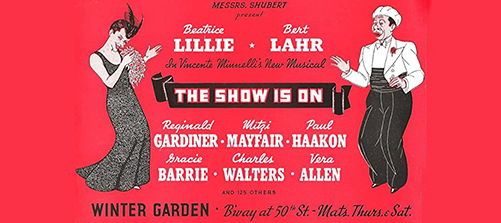
Musical
Musique: George Gershwin • Harold Arlen • Herman Hupfeld • Richard Rodgers • Will Irwin • Paroles: E.Y. Harburg • Herman Hupfeld • Howard Dietz • Ira Gershwin • Lorenz M. Hart • Ted Fetter • Livret: David Freedman • Moss Hart • Production originale: 1 version mentionnée
Dispo:
Genèse:
Résumé:
Création: 25/12/1936 - Winter Garden Theatre (Broadway) - 236 représ.
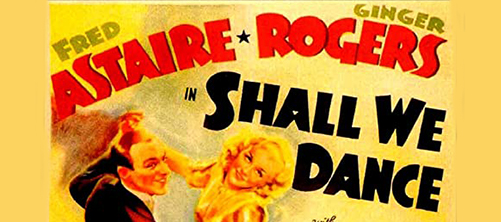
Film
Musique: George Gershwin • Paroles: Ira Gershwin • Livret: Allan Scott • Ernest Pagano • Production originale: 1 version mentionnée
Dispo: Résumé Commentaire Génèse
Shall We Dance, released in 1937, is the seventh of the ten Astaire-Rogers musical comedy films. The idea for the film originated in the studio's desire to exploit the successful formula created by Richard Rodgers and Lorenz Hart with their 1936 Broadway hit On Your Toes. The musical featured an American dancer getting involved with a touring Russian ballet company. In a major coup for RKO, Pandro Berman managed to attract the Gershwins – George Gershwin who wrote the symphonic underscore and Ira Gershwin the lyrics – to score this, their second Hollywood musical after Delicious in 1931.
Genèse: Production While the film – the couple's most expensive to date – benefits from quality comedy specialists, opulent art direction by Carroll Clark under Van Nest Polglase's supervision, and a timeless score which introduces three classic Gershwin songs, the convoluted plot and the curious absence of a romantic partnered duet for Astaire and Rogers – a hallmark of their musicals since The Gay Divorcee (1934) – contributed to their least profitable picture to date. Astaire was no stranger to the Gershwins, having headlined, with his sister Adele, two Gershwin Broadway shows: Lady Be Good! in 1924 and Funny Face in 1927. George Gershwin also accompanied the pair on piano in a set of recordings in 1926. Rogers first came to Hollywood's attention when she appeared in the Gershwins' 1930 stage musical Girl Crazy. Shall We Dance was named at the suggestion of Vincente Minnelli, who was a friend of the Gershwins. Minnelli originally suggested "Shall We Dance?" with a question mark, which disappeared at some point. Reception Shall We Dance earned $1,275,000 in the US and Canada and $893,000 elsewhere, resulting in a profit of $413,000, less than half the previous Astaire-Rogers film. It was neither a box office nor a critical success, and was taken as an indication that the Astaire-Rogers pairing was slipping in its audience appeal.
Résumé: Peter P. Peters (Fred Astaire), an American ballet dancer billed as "Petrov", dances for a ballet company in Paris owned by the bumbling Jeffrey Baird (Edward Everett Horton). Peters secretly wants to blend classical ballet with modern jazz dancing, and when he sees a photo of famous tap dancer Linda Keene (Ginger Rogers), he falls in love with her. He contrives to meet her, but she is less than impressed. They meet again on an ocean liner traveling back to New York, and Linda warms to Petrov. Unknown to them, a plot is launched as a publicity stunt "proving" that they are actually married. Outraged, Linda becomes engaged to the bumbling Jim Montgomery (William Brisbane), much to the chagrin of both Peters and Arthur Miller (Jerome Cowan), her manager, who secretly launches more fake publicity. Peters and Keene, unable to squelch the rumor, decide to actually marry and then immediately get divorced. Linda begins to fall in love with her husband, but then discovers him with another woman, Lady Denise Tarrington (Ketti Gallian), and leaves before he can explain. Later, when she comes to his new show to personally serve him divorce papers, she sees him dancing with dozens of women, all wearing masks with her face on them: Peters has decided that if he cannot dance with Linda, he will dance with images of Linda. Seeing that he truly loves her, she happily joins him onstage.
Création: 7/5/1937 - *** Film (***) - représ.
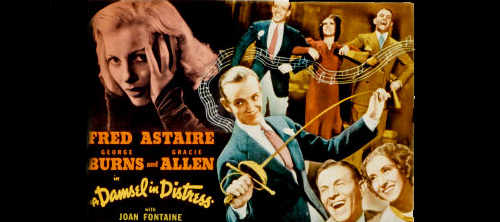
Film
Musique: George Gershwin • Victor Baravalle • Paroles: Livret: Ernest Pagano • P.G. Wodehouse • PJ Wolfson • S.K. Lauren • Production originale: 1 version mentionnée
Dispo: Résumé Commentaire
A Damsel in Distress is a 1937 English-themed Hollywood musical comedy film starring Fred Astaire, Joan Fontaine, George Burns, and Gracie Allen. Loosely based upon the P.G. Wodehouse 1919 novel of the same name, and the 1928 stage play written by Wodehouse and Ian Hay, it has music and lyrics by George and Ira Gershwin, and was directed by George Stevens, the second (and last) Astaire musical directed by Stevens; the first was Swing Time.
Genèse:
Résumé: Everyone on staff at Tottney Castle knows that the lovely Lady Alyce Marshmorton (Joan Fontaine) must marry soon, so a wager is proposed as to the identity of the lucky man. With all the likely candidates already claimed, young footman Albert (Harry Watson) places a bet on a "Mr. X," someone totally out of the blue. Lady Alyce secretly has a romantic interest in an American no one from her family has yet met. She leaves the castle one day to venture into London, where by chance she encounters Jerry Halliday (Fred Astaire). He is an American entertainer, accompanied by press agent George (George Burns) and secretary Gracie (Gracie Allen), but he is not well enough known to be recognized by Lady Alyce. Jerry is incorrectly led to believe that he is the American that Lady Alyce is in love with. He goes to the castle, encouraged by Albert but discouraged by Keggs (Reginald Gardiner), a scheming butler whose money is on another beau. The closest Jerry can get to Lady Alyce is a castle tour, at least until Albert can sneak him upstairs. False impressions abound, as Jerry also fails to recognize Lady Alyce's father (Montagu Love), the lord of the manor. He is slapped in the face in a Tunnel of Love, misunderstanding the young lady's intentions entirely. In the end, however, he and Lady Alyce do find romance. The song "Things Are Looking Up" by George and Ira Gershwin appears in the film.
Création: 19/11/1937 - *** Film (***) - représ.
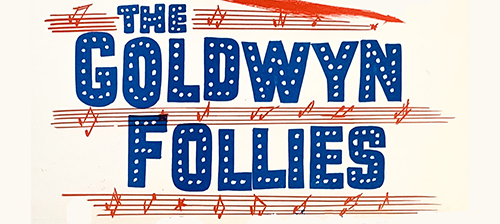
Film
Musique: George Gershwin • Vernon Duke • Paroles: Ira Gershwin • Livret: Production originale: 1 version mentionnée
Dispo: Résumé Commentaire
The Goldwyn Follies is a 1938 Technicolor film written by Ben Hecht, Sid Kuller, Sam Perrin and Arthur Phillips, with music by George Gershwin, Vernon Duke, and Ray Golden, and lyrics by Ira Gershwin and Sid Kuller. Some sources credit Kurt Weill as one of the composers, but this is apparently incorrect. The Goldwyn Follies was the first Technicolor film produced by Samuel Goldwyn.
Genèse:
Résumé: The movie, which features Adolphe Menjou, Vera Zorina, Edgar Bergen (with Charlie McCarthy), Andrea Leeds, Kenny Baker, Ella Logan, Helen Jepson, Bobby Clark and the Ritz Brothers, depicts a movie producer who chooses a simple girl to be "Miss Humanity" and to critically evaluate his movies from the point of view of the ordinary person. The style of the film is very similar to other musicals of its era, including the "Gold Diggers" series and others. The film is an effective satire on Hollywood and has some excellent numbers choreographed by George Balanchine.
Création: 4/2/1938 - *** Film (***) - représ.
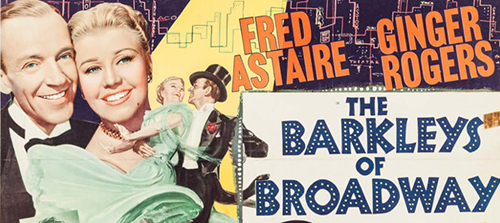
Film
Musique: George Gershwin • Harry Warren • Paroles: Ira Gershwin • Livret: Adolph Green • Betty Comden • Production originale: 1 version mentionnée
Dispo: Résumé Commentaire
Ce film musical en Technicolor de 1949, produit par l'unité Arthur Freed de la Metro-Goldwyn-Mayer, a réuni Fred Astaire et Ginger Rogers après dix ans d'interruption.
Genèse:
Résumé: À la sortie d’une grande première, Josh (Fred Astaire) et Dinah (Ginger Rogers) Barkley prennent part à une grande réception où ils rencontrent Jacques Barredout (Jacques François), dramaturge français émigré aux États-Unis. Jacques Barredout propose à Dinah dont il est amoureux, de devenir "sa" tragédienne dans sa dernière pièce. Il ignore délibérément Josh qui n'est pour lui qu'un amuseur. Après son succès, Dinah revient vers Josh, son amour et ils repartent dans leur domaine, la comédie musicale.
Création: 4/5/1949 - *** Film (***) - représ.
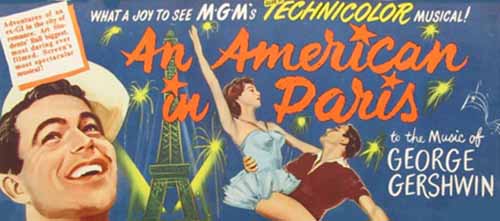
Film
Musique: George Gershwin • Paroles: Ira Gershwin • Livret: Alan Jay Lerner • Production originale: 1 version mentionnée
Dispo: Résumé
"An American in Paris" est une comédie musicale américaine cinématographique inspirée de la composition orchestrale "An American in Paris" de George Gershwin de 1928.
Genèse:
Résumé: À Paris, une riche héritière s'éprend de Jerry Mulligan (Gene Kelly), un jeune peintre américain. Mais celui-ci tombe amoureux de Lise (Leslie Caron), qui est elle-même promise à un autre homme, Henri. Ce film est universellement célèbre pour sa scène finale : Jerry pense qu'il ne pourra jamais être avec Lise et fait un rêve fantastique : apothéose du film. Il rêve qu'il danse avec Lise partout dans les rues de Paris. Le fiancé de la jeune fille et tout un chœur se joignent à eux tout au long d'un ballet magistral qui dure près de dix-huit minutes. La musique du ballet (qui porte le nom du film) est de George Gershwin. Dans les dernières mesures, Henri accepte de renoncer à Lise, qui se précipite dans les bras de Jerry sous la bénédiction d'Henri. Le film s'achève.
Création: 4/10/1951 - *** Film (***) - représ.
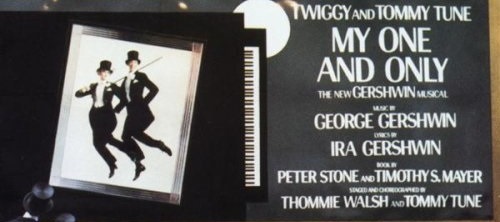
Musical
Musique: George Gershwin • Paroles: Ira Gershwin • Livret: Peter Stone • Timothy S Mayer • Production originale: 2 versions mentionnées
Dispo: Résumé Synopsis Génèse Liste chansons
Genèse: Just prior to out of town tryouts in Boston, the original director, Peter Sellars, was fired, with the musical director and arranger, the book writer, Tim Mayer, and set designer, Adrianne Lobel, dismissed soon after. Tommy Tune "nominally took over the direction with his co-choreographer Thommie Walsh, and Mike Nichols, Tony Walton and...Michael Bennett were brought in to help with the direction, choreography and set design." Productions My One and Only opened on Broadway at the St. James Theatre on May 1, 1983 and closed on March 3, 1985 after 767 performances and 37 previews. The musical was directed and choreographed by Tommy Tune and Thommie Walsh. The cast included Tune, Twiggy, Roscoe Lee Browne, Denny Dillon, Charles "Honi" Coles, and Nana Visitor. Notable replacements during the run included Sandy Duncan, Don Correia, Jeff Calhoun, and Georgia Engel. The musical opened in the UK at the Chichester Festival Theatre and then opened in the West End at the Piccadilly Theatre in February 2002, starring Janie Dee as Edythe Herbert and Tim Flavin as Captain Billy Buck Chandler, with direction by Loveday Ingram and choreography by Craig Revel Horwood. Cabaret singer and Gershwin historian Michael Feinstein served as the musical consultant for the project. An extensive review of the show's creation can be found in his book" Nice Work If You Can Get It" in a chapter entitled My One and Only Tommy Tune Fling. There were several tours, all with Tommy Tune. The first was in 1985 with Sandy Duncan which started at the Kennedy Center in March 1985 and included a six week engagement in Japan. Lucie Arnaz replaced Duncan in this tour. Stephanie Zimbalist starred in the US national tour in 1987.
Résumé: Captain Billy Buck Chandler wants to be the first to make a solo flight across the Atlantic. Edythe Herbert, a champion swimmer, is being blackmailed by her wicked Russian manager who has some compromising photographs of her . This devious baddy known as Prince Nikki (and secretly a spy) will get his come-uppance, thanks to Billy’s airplane engineer, a rather butch lady called Mickey (who turns out to be a secret agent). By then, however, Billy and Edythe have fallen in love, have crashed on a desert island (actually Staten Island!), and have seen off a bootlegging Harlem minister and a tap-dancing philosopher called Mr Magix.
Création: 1/5/1983 - St. James Theatre (Broadway) - représ.
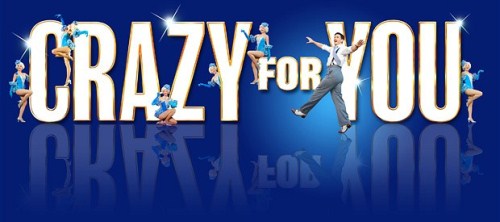
Musical
Musique: George Gershwin • Paroles: Ira Gershwin • Livret: Ken Ludwig • Production originale: 8 versions mentionnées
Dispo: Résumé Synopsis Génèse Liste chansons
Genèse: The Broadway production was directed by Mike Ockrent and choreographed by Susan Stroman. After 10 previews, it opened at the Shubert Theatre on February 19, 1992, and ran for 1,622 performances. The cast included Jodi Benson as Polly, Harry Groener as Bobby Child, Bruce Adler as Bela Zangler, John Hillner as Lank Hawkins, Michele Pawk as Irene Roth, Jane Connell as Mother, Beth Leavel as Tess (Leavel also understudied Benson), Ronn Carroll as Everett Baker, and Stephen Temperley and Amelia White as Eugene and Patricia Fodor. The Manhattan Rhythm Kings played cowboys Mingo, Moose, and Sam, singing in their trademark close harmony. In his review in The New York Times, Frank Rich wrote, "When future historians try to find the exact moment at which Broadway finally rose up to grab the musical back from the British, they just may conclude that the revolution began last night. The shot was fired at the Shubert Theater, where a riotously entertaining show called Crazy for You uncorked the American musical’s classic blend of music, laughter, dancing, sentiment and showmanship with a freshness and confidence rarely seen during the Cats decade . . . Crazy for You scrapes away decades of cabaret and jazz and variety-show interpretations to reclaim the Gershwins’ standards, in all their glorious youth, for the dynamism of the stage." A cast album was released by Angel Records. The West End production, directed by Ockrent, choreographed by Stroman, and starring Ruthie Henshall, Kirby Ward, and Chris Langham, opened at the Prince Edward Theatre on March 3, 1993 and ran for nearly three years. On October 20, 1999, the PBS series Great Performances broadcast a production directed by Matthew Diamond, who was nominated for the Emmy Award for Outstanding Direction of a Variety or Music Program. On October 18, 2009, a showtime challenge, charity gala performance of Crazy for You, directed by Katherine Hare and choreographed by Racky Plews was staged by Eyebrow Productions at the London Palladium. Eyebrow are well known for their unique Showtime Challenges, where all aspects of the show are rehearsed and performed in 48 hours. All proceeds went to Cecily's Fund. In 2011, Regent's Park Open Air Theatre did a revival of Crazy for You as part of the 2011 Summer Season. The production has since moved to the West End, at the Novello Theatre where it is running from October 8, 2011 to July 28, 2012.
Résumé: CRAZY FOR YOU™ is the story of Bobby Child, a well-to-do 1930's playboy, who's dream in life is to dance. And despite the serious efforts of his mother and soon-to-be-ex-fiancee, Bobby achieves his dream! Memorable Gershwin tunes include I Can't Be Bothered Now, Bidin' My Time, I Got Rhythm, Naughty Baby, They Can't Take That Away from Me, But Not for Me, Nice Work if You Can Get It, Embraceable You and Someone to Watch Over Me. It's a high energy comedy which includes mistaken identity, plot twists, fabulous dance numbers and classic Gershwin music.
Création: 19/2/1992 - Shubert Theatre (Broadway) - 1622 représ.
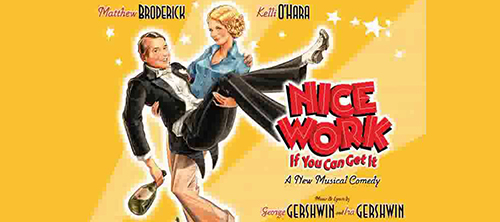
Musical
Musique: George Gershwin • Paroles: Ira Gershwin • Livret: Jo DiPietro • Production originale: 2 versions mentionnées
Dispo: Résumé Génèse Liste chansons
Nice Work If You Can Get It is a musical featuring songs by George and Ira Gershwin, with a book written by Joe DiPietro, and based on material by Guy Bolton and P. G. Wodehouse. Nice Work premiered on Broadway in April 2012.
Genèse: Background The musical was initially produced in 2001 at the Goodspeed Opera House titled They All Laughed!, with the book by Joe DiPietro and direction by Christopher Ashley. The musical received "mixed notices" according to Frank Rizzo, writing in the Hartford Courant.[3] New collaborators and producers then became involved. A workshop was held in November 2007, featuring Harry Connick, Jr. and Erin Dilly. At that time, the show was titled Heaven on Earth. The musical was first scheduled to debut at the Colonial Theatre in Boston, running from December 2008 through January 2009. The production was expected to open on Broadway in Spring 2009, with Harry Connick, Jr. However, in 2008 it was announced that the musical was "officially postponed", due to a change in the producing team; Connick ultimately left the project. Productions Preview performances began on Broadway at the Imperial Theatre on March 29, 2012 with the opening on April 24, 2012. Directed and choreographed by Kathleen Marshall, the cast starred Matthew Broderick (Jimmy Winter) and Kelli O'Hara (Billie Bendix). The production closed on June 15, 2013, after 27 previews and 478 regular performances. A US national tour started on September 2, 2014 at the Music Hall at Fair Park in Dallas, Texas, and ran, with an extended break for the winter holidays, until March 22, 2015. It finished at the Segerstrom Center for the Arts in Costa Mesa, California. The Australian premiere, a non-replica production directed by Roger Hodgman for The Production Company, played at the State Theatre, Arts Centre Melbourne from August 15 to 23, 2015. It featured Rohan Browne, Esther Hannaford, Christie Whelan-Browne, John Wood, Gina Riley, George Kapiniaris, and Nicki Wendt. The UK premiere ran at Upstairs at The Gatehouse in London from 12 December 2018 to 27 January 2019. It was directed by John Plews, with choreography by Grant Murphy, musical supervision by Charlie Ingles, musical direction by Chris Poon, design by Pollyanna Elston, sound design by Nico Menghini (assisted by Alistair Warr & Rachel Darwood), lighting design by Sam Waddington (assisted by Bethany Gupwell), costume supervision by Nadine Froehlich, wigs by Jessica Plews, and produced by Katie Plews for Ovation Productions.
Résumé: Act I It's 1927, in the midst of a riotous bachelor party for the oft-married Jimmy Winter ("Sweet and Lowdown"). Outside, a trio of bootleggers – Cookie, Billie and Duke – are trying to figure out where to hide the 400 cases of gin they have stashed on their boat. As a stranger approaches, Duke and Cookie rush off. A drunken Jimmy staggers and comes across the pants-wearing Billie and is immediately smitten. He explains his plight – he must marry someone respectable or his mother will disinherit him, so he's marrying someone he doesn't truly love. Billie isn't all that interested in his tale of woe, until he reveals that he has a huge Long Island beach house that he never uses, so she swipes his wallet to discover the address. Jimmy assumes Billie is falling for him, but Billie insists that love is for suckers. Jimmy vehemently disagrees ("Nice Work If You Can Get It"). Jimmy passes out, and Billie focuses on this interesting man unconscious on the ground before her ("Nice Work If You Can Get It - Reprise"). Cookie and Duke rush back on, and Billie tells them that she found a place to store their bootleg – a Long Island beach house. A police whistle pierces the air, and the bootleggers scatter. Senator Max Evergreen and Chief Berry enter, along with Duchess Estonia Dulworth, who has brought along her Vice Squad and vows to rid society of its greatest evil ("Demon Rum"). The next morning, Billie, Cookie and Duke have stored their 400 cases of gin in the cellar of Jimmy's ritzy beach house. Eileen Evergreen, the finest interpreter of modern dance in the world, enters with Jimmy. They were married that morning, and they are on their honeymoon, though Eileen has yet to allow Jimmy to touch her. Cookie, disguised as a butler, enters and they naturally assume he's their servant. They send him off, and Eileen tells Jimmy that she's ready for the honeymoon shenanigans to begin – as soon as she takes a bath. She exits into the house as Billie enters, stunned to see Jimmy. Jimmy has no memory of meeting her last night, and as Jimmy flirts with her, Billie confesses that she's never been kissed. Strictly for educational purposes, Jimmy kisses Billie, and she realizes what she's been missing ("Someone to Watch Over Me"). Four and a half hours later, Eileen is still bathing ("Delishious"). In the ritzy living room, Cookie and Billie devise a plan for Billie to distract Jimmy from the 400 cases of gin in his cellar. Billie runs off as Jimmy enters, followed by a gaggle of chorus girls who invite him for a group swim, which Jimmy almost accepts ("I've Got to be There"). Eileen enters with a flourish, and just as she is about to let Jimmy touch her, he receives a telegram revealing that his last wife has refused to sign the annulment, and an irate Eileen storms off to get her father. That night in Jimmy's ritzy bedroom, Billie breaks in and tries to seduce him, badly ("Treat Me Rough"). Chief Berry, who has been pursuing Billie, barges in to arrest her. But Jimmy convinces him that Billie is actually his newest wife ("Let's Call the Whole Thing Off") and Billie and Jimmy are forced to spend the whole night together in his bedroom. The next morning, Jeannie, a happy-go-lucky chorus girl, comes upon Duke, a lug from New Jersey, and mistakes him for an actual English Duke. Duke, who is perpetually nervous around women, tries to escape, but Jeannie does everything in her power to get him to notice her ("Do it Again"). In the ritzy living room, Jimmy and Billie realize that they are hopelessly in love ("'S Wonderful") But Eileen returns with her father – the ultra-conservative Senator Evergreen – and her aunt – the Duchess Estonia Dulworth – to demand that Jimmy and Eileen have a legal wedding. Jimmy has no choice but to marry Eileen, and Billie pretends to be a cockney maid so she can stick around and guard the bootleg. As Eileen beelines towards the cellar to get the wedding china, Jimmy and Cookie frantically distract the wedding party away from the basement ("Fascinating Rhythm") as the curtain falls. Act II On the ritzy terrace, the Vice Squad and Chorus Girls revel ("Lady Be Good"). Billie enters and realizes she'll never be as happy as the dancing revelers around her ("But Not For Me"). Cookie and Duke enter and, since they're all now disguised as servants, they plot how they can get the impending wedding luncheon over and done with as quickly as possible. The Duchess barrels on to instruct Cookie in the finer points of luncheon preparation. She insists on hiring a string quartet for entertainment, but Cookie has other ideas ("By Strauss" / "Sweet and Lowdown - Reprise"). As Billie sets the ritzy luncheon table, Jimmy makes one last attempt to appease her ("Do, Do, Do"). But Billie will have none of it. As the luncheon begins, Cookie and Duke frantically serve the luncheon guests, and the Duchess continues to annoy Cookie, who spikes her lemonade with Gin. Billie entertains them all with a cockney song ("Hangin' Around With You") which mainly serves as an excuse to keep pouring hot soup on Jimmy's lap. But Billie accidentally pours some steaming soup onto Eileen, who immediately fires her. The Duchess, now happily drunk, defends Billie and reveals a deep secret as she grabs onto Cookie, climbs on the luncheon table and swings from a chandelier ("Looking for a Boy"). After he drags off the Duchess, an angry Jimmy calls Billie a common criminal, and they realize that they can never be together. Jimmy goes to prepare for his wedding, as Jeannie enters looking for Duke, who Billie accidentally reveals isn't a real duke. Jeannie is furious, so Duke tries to win her over with a poem ("Blah Blah Blah"), but Jeannie rushes away. In the ritzy bedroom, Cookie is dressing Jimmy for his wedding as Billie enters to return his wallet. Jimmy and Billie both realize that this is the last time they'll ever see each other ("Will You Remember Me?"). The Chorus Girls and Vice Squad set up the wedding ("I've Got To Be There - Reprise"). As Senator Evergreen presides, Eileen makes her very grand entrance ("I've Got a Crush on You"). But just before vows are exchanged, Cookie and Duke rush in, pretending to be Prohibition Agents, though Chief Berry quickly enters and reveals their true identities. As they're arrested, Jeannie rushes in and proclaims her love for Duke, then the now sober Duchess proclaims her love for Cookie. Still, Senator Evergreen insists the bootleggers must be arrested, but Jimmy's mother, Millicent, makes an appearance, revealing the true nature of her son's heritage – Senator Evergreen is Jimmy's father. The senator proclaims the day a joyous one and all are free to pursue their new and surprising loves. Jimmy realizes that Billie has rushed to the boathouse to sail away forever, and he rushes to swear his devotion to her. Millicent follows and reveals that she happens to be the biggest rum-runner on Long Island, and she'd like Billie to marry her son and take over her business. Billie happily accepts ("Someone to Watch Over Me - Reprise"). And on the ritzy terrace under a starry night, love has blossomed, the bootleg is opened and the company celebrates their new found joy ("They All Laughed!").
Création: 24/4/2012 - Imperial Theatre (Broadway) - 478 représ.
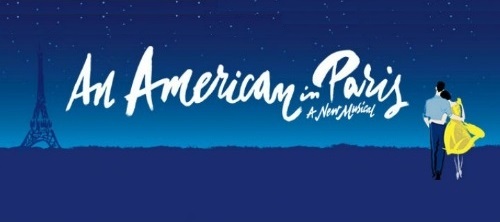
Musical
Musique: George Gershwin • Paroles: Ira Gershwin • Livret: Craig Lucas • Production originale: 3 versions mentionnées
Dispo: Résumé Génèse Liste chansons
Vidéos:
Ce n’est pas tous les jours que l’on assiste à la première mondiale d’une comédie musicale…
Genèse: Contrairement à la majorité des cas, An American in Paris n'est pas une pièce de Broadway qui fut adaptée au cinéma, pour toucher un public plus large. Il manquait donc à la scène ce fleuron du genre. Jean-Luc Choplin, associé aux producteurs Van Kaplan et Stuart Oken de Broadway, comblent ainsi cette attente. Le succès de Rhapsody in Blue en 1924, permet à George Gershwin de voyager en Europe et de rencontrer lors d'un séjour à Paris nombre de compositeurs qu'il admire. Stravinsky, Ravel, Poulenc, Milhaud… témoignent à l'américain reconnaissance et encouragement. Un Américain à Paris, composé en 1928, est un poème symphonique d'une vingtaine de minutes salué par le critique Isaac Goldberg comme étant "L'après-midi d'un faune américain". En 1950, le producteur Arthur Freed veut illustrer les compositions de Gershwin et en premier lieu Un Américain. Comme il le fera avec Chantons sous la pluie, il met bout à bout un ensemble de chansons existantes sur lesquelles il brode une histoire. Soit celle d'un GI américain, Jerry, peintre à Montmartre, débordant de joie de vivre et de bonne humeur. Il rencontre Lise, une jeune vendeuse mais Lise est aimé d’Henri un chanteur populaire. Les sentiments (l'amour, la déception, la joie et le blues) culminent lors d'une scène de ballet qui verra le couple s'unir sur une des plus célèbres chorégraphies de l'histoire de la comédie musicale hollywoodienne. Réalisé par Vincente Minnelli (qui sera l’un des spécialistes du genre avec Tous en scène, Brigadoon ou Gigi), le film sera récompensé par six oscars. Et Gene Kelly reçoit à cette occasion un oscar d'honneur pour sa contribution exceptionnelle à l'art de la chorégraphie cinématographique. Incorporating songs from George and Ira Gershwin, including "I Got Rhythm", "Liza", "'S Wonderful", "But Not For Me", "Stairway to Paradise", as well as orchestral music including "Concerto in F", "2nd Prelude", "2nd Rhapsody", "Cuban Overture", and the title song, An American in Paris features a book by Craig Lucas.
Résumé: Après la libération, désireux de reprendre sa vie et de tirer un trait sur les violences de la Seconde Guerre mondiale, le vétéran Jerry Mulligan s’installe à Paris et tente de se faire un nom comme artiste peintre. Il trouve un soutien en la personne de Milo Davenport, une riche américaine au passé trouble. L’existence de Jerry se complique lorsqu’il tombe amoureux de Lise, jeune vendeuse parisienne qui porte aussi sa part de secrets, car son ami Adam – un compositeur juif américain, et Henri - un aristocrate parisien - se disputent également son amour. Cette situation sans issue ne trouve de dénouement que dans le miracle de la danse, sur les musiques et lyrics parmi les plus beaux jamais composés. Ce récit culte de jeunesse et d’errance dans le Paris d’Après-Guerre est ici repensé pour la scène du 21e siècle.
Création: 10/12/2014 - Théâtre du Châtelet (Paris) - représ.
Oeuvres de George Gershwin
Oeuvres de Ira Gershwin
C) Quelques oeuvres d'Ira Gershwin

Musical
Musique: Paul Lannin • Vincent Youmans • Paroles: Ira Gershwin • Livret: Fred Jackson • Production originale: 1 version mentionnée
Dispo: Résumé Commentaire Liste chansons
"Two Little Girls in Blue" marqua les débuts de Vincent Youmans à Broadway. Son premier spectacle destiné à Broadway fut Piccadilly to Broadway, qui ferma en tournée l'année précédente et comprenait des paroles d'Arthur Francis (alias Ira Gershwin). En réalité, Two Little Girls in Blue fut, à toutes fins utiles, les débuts de Ira Gershwin à Broadway. Il avait déjà écrit quelques paroles occasionnelles pour des spectacles de Broadway ou en route vers Broadway, mais Two Little Girls in Blue fut la première fois qu’un musical de Broadway présentait un livret entièrement écrit par lui.
Genèse:
Résumé: Les filles mentionnées dans le titre du spectacle sont les jumelles Dolly et Polly Sartoris (interprétées par les sœurs Fairbanks, Madeline et Marion). Bloquées à New York, elles sont déterminées à rejoindre l’Inde afin de réclamer un héritage. Pour ce faire, elles réservent un billet sous un seul nom à bord du S.S. Empress, veillent à ne jamais être vues ensemble et apparaissent tour à tour sous la même identité. Rapidement, elles trouvent l’amour en mer : Dolly avec Jerry Lloyd (Fred Santley) et Polly avec Bobby Barker (Oscar Shaw). Mais, bien sûr, aucun des deux jeunes hommes ne sait qu’il courtise l’une des jumelles et tous deux finissent par se croire rivaux pour la même femme. Pour compliquer encore les choses, deux voleurs de bijoux, poursuivis par un détective de Scotland Yard, se trouvent également à bord.
Création: 3/5/1921 - George M. Cohan's Theatre (Broadway) - 135 représ.

Musical
Musique: George Gershwin • Paroles: Desmond Carter • Ira Gershwin • Livret: George Grossmith • Guy Bolton • Production originale: 1 version mentionnée
Dispo: Résumé Génèse Liste chansons
Primrose is a musical in three acts with a book by Guy Bolton and George Grossmith Jr., lyrics by Desmond Carter and Ira Gershwin, and music by George Gershwin. It centers on a writer whose story-within-a-story forms the basis of the plot. It was written expressly for the London stage, where it ran for 255 performances in 1924 and 1925. George Gershwin, at 25 years old, was an established songwriter by 1924 when Grossmith and his producing partners, J. A. E. Malone and Edward Laurillard, hired him to produce the score for Primrose for them in London. The musical is the first in which Gershwin wrote some of the orchestrations himself. The year was one of the busiest for Gershwin, as it also included his Rhapsody in Blue and two other musicals. Gershwin's score, and the book by Bolton are old-fashioned for their time, with more in common with the frothy Edwardian musical comedies than with the later Gershwin musicals.
Genèse: Primrose was produced by Grossmith and J. A. E. Malone, who wanted to follow up on their earlier successes composed by Jerome Kern.[2] It opened at the Winter Garden Theatre in London on 11 September 1924 only two months before the Gershwins’ Lady, Be Good! debuted on Broadway. The cast featured comedian Leslie Henson and also included Claude Hulbert, Heather Thatcher and opera baritone Percy Heming. The director was Charles A. Maynard, and the choreographer was Laddie Cliff.[5][6] Extensive excerpts from the score were recorded with original 1924 cast members conducted by Ansell, and have been re-released on CD. P. G. Wodehouse rewrote the lyric of 'When Toby is out of Town' as 'The Twenties are Here to Stay', interpolated into a 1960 revival of Gershwin's Oh, Kay! In their joint memoir Bring on the Girls!, Wodehouse and Bolton relate a story about Grossmith holding auditions for Primrose, where he made a routine request of Sylvia Hawkes, a beautiful young dancer, who later married a series of famous men: "Must I sing, Mr Grossmith?" "Yes, Sylvia, you must. All of you have to sing if you want jobs as showgirls in Primrose. The Gershwin score demands it." "Oh very well," she replied petulantly, and, going down to the floats she handed over a piece of music to the pianist in the pit. The piano struck a chord. "God save our gracious King, Long live our noble King, God save the King." Grossmith, a strict observer of ritual, rose and stood at attention. His minions rose and stood at attention. Guy, on his way to announce his arrival, stood at attention. As the anthem came to the normal stopping point, George started to sit down, but there is more, much more of the fine old chorale than is generally known. James Carey is credited with a three-stanza version; in another version John Bull... has expressed the same sentiment in his own way; while James Oswald... also got into the act. A printing is extant giving them all. Sylvia Hawkes sang them all. The pianist stopped playing, but that didn't stop Sylvia. They wanted her to sing, did they? Well, sing she would. Of course no one dared to call a halt. The national anthem is sacrosanct – especially if you're an actor-manager clinging to the hope of a belated knighthood. An Australian production with Maude Fane and Alfred Frith opened in Melbourne, at His Majesty's Theatre in April 1925, before touring nationally. It was produced by J. C. Williamson's company. The show was not produced on Broadway, where it would have competed with Lady, Be Good!. The American première of Primrose did not take place until 1987, when an unstaged concert production at the Coolidge Auditorium of the Library of Congress was given, without dialogue, together with another Gershwin score, Pardon My English (1933), both conducted by John McGlinn.[10] Soloists included Rebecca Luker and Kim Criswell. The next performance in North America was in 2003, when Musicals Tonight! presented a series of staged concerts at the 14th Street YMCA in New York City's Greenwich Village, with dialogue, but accompanied only by piano, directed by Thomas Mills. Ohio Light Opera mounted the first fully staged American production of the show in 2017.
Résumé: Primrose consists of three interconnected love stories about Freddie and May, Hilary and Joan, and Toby and Pinkie. Freddie is reluctantly engaged to his cousin Joan, but falls in love with amateur golfer May Rooker. Joan, a naive, pretty young socialite, loves dashing Hilary Vane, a successful author of romantic yarns who lives on a houseboat. Hilary is writing a story whose heroine, Miss Primrose, is at a similar impasse. Hilary returns Joan's love, but Freddie and Joan are under the thumb of Sir Barnaby Falls – Joan's guardian and Freddie's uncle – who, for financial reasons, refuses consent to their marrying anyone except each other. The romance of aristocratic Toby Mopham and the vulgar but ambitious beautician Pinkie Peach is impeded by Toby's second thoughts after rashly proposing; he enlists Hilary's to pretend to woo Pinkie so that Toby can catch them in flagrante and break off the engagement. However, Joan also catches Hilary wooing Pinkie. During an eventful dance sequence, Toby overcomes his reluctance to marry, Sir Barnaby gives way, and all three couples are free to marry.
Création: 11/9/1924 - Winter Garden Theatre (Londres) - représ.

Musical
Musique: George Gershwin • Paroles: Ira Gershwin • Livret: Fred Thompson • Guy Bolton • Production originale: 6 versions mentionnées
Dispo: Résumé Commentaire Génèse Liste chansons
A tous points de vue, Lady, Be Good! a placé les frères George et Ira Gershwin ainsi que les frère et sœur Fred et Adele Astaire dans le panthéon des immortels du théâtre. Ce fut la première collaboration des frères Gershwin à Broadway.
Genèse: Création à Broadway (1924) Lady, Be Good est créé à Broadway au Liberty Theatre le 1er décembre 1924 et ferme le 12 septembre 1925 après 330 représentations. Le musical a été mise en scène par Felix Edwardes et une scénographie de Norman Bel Geddes. Il avait pour vedette les frère et sœur Fred et Adele Astaire. Création à Londres (1926) Le musical a ouvert dans le West End à l'Empire Theatre le 14 avril 1926, avec à nouveau Fred et Adele Astaire. Cela a aussi été un beau succès avec 326 représentations. Les chansons qui ont été les plus remarquées à Londres furent Oh, Lady be Good! et Fascinating Rhythm. Revivals La version de concert de The Encores! de Lady, Be Good s’est jouée du 4 au 8 février 2015. Dirigée par Mark Brokaw et chorégraphiée par Randy Skinner, la distribution met en vedette Tommy Tune et Douglas Sills, avec Danny Gardner et Patti Murin comme acteurs frère et sœur.
Résumé: Acte I: Quartier de Beacon Hill (Rhode Island) Expulsés dans la journée de leur vieille propriété familiale, Dick Trevor et sa sœur Susie se retrouvent le soir même à une fête organisée par la riche Joséphine 'Jo' Vanderwater. Ils y retrouvent notamment leur avocat, 'Watty' Warkins, ainsi que le musicien Jeff White. Il s'avère que Jo a "commandité" l'expulsion, espérant de cette façon "récupérer" Dick dont elle est amoureuse. Mais Shirley, l'amie de Dick, ne l'entend pas ainsi, ni Susie. Watty propose alors à cette dernière une combine lucrative, en se faisant passer pour la veuve de feu Jack Robinson, seul héritier de l'Hôtel du même nom ; de son côté, Dick annonce ses fiançailles avec Jo... Acte II: Trois jours plus tard à Eastern Harbor (Connecticut) Watty et la "veuve" rencontrent, à l'Hôtel Robinson, les membres du Conseil d'Administration. Dick se présente également, ignorant tout de la combine, et s'étonnant de la présence de sa sœur. Arrive aussi à l'hôtel un vagabond, dont Susie est tombée amoureuse à l'Acte I. Mais celui-ci est en réalité Jack Robinson que l'on croyait mort. Il "reconnaît" Susie comme son épouse, au moment où elle et Watty allaient être arrêtés. Plus tard, les protagonistes se retrouvent dans un Yacht Club, à une nouvelle fête où tout s'arrange, avec notamment des projets de mariages…
Création: 1/12/1924 - Liberty Theatre (Broadway) - 330 représ.

Musical
Musique: George Gershwin • Paroles: B.G. DeSylva • Ira Gershwin • Livret: Fred Thompson • William K. Wells • Production originale: 2 versions mentionnées
Dispo: Résumé Génèse Liste chansons
Genèse: Une comédie musicale négligée de 1925 qui tourne autour des enchevêtrements romantiques de trois couples, TELL ME MORE présente une partition remplie des sensibilités Jazz des frères Gershwin. 1925 a été une année chargée pour George et Ira, avec les premières de deux autres comédies musicales de Gershwin à Broadway et les débuts du CONCERTO IN F de George. L’absence de stars du calibre de Fred et Adele Astaire a peut-être limité le succès de TELL ME MORE à Broadway, mais la série a connu un grand succès à Londres, avec peu de changements structurels. Restauré sous les auspices des Trusts Ira et Leonore Gershwin et de la Bibliothèque du Congrès, TELL ME MORE a fait ses débuts en 2001 lorsqu’il a été publié sur le label New World Records.
Résumé: Lors d’un bal masqué à Manhattan, Kenneth Dennison, fils d’une des plus belles familles de New York, se tient dans une boîte surplombant la piste de danse, regardant une jeune fille vêtue de Pierrette. Il se demande comment l’approcher au mieux, mais il n’a pas à se demander longtemps, pour quelques instants plus tard, cette même Pierrette, qui a l’intention de visiter une fête dans la boîte attenante, ouvre la porte de Kenneth par erreur. Il se présente rapidement et avoue son engouement, et la fille, Peggy, flirte prudemment. Elle se démasque, et l’ambiance devient plus romantique, mais Peggy s’échappe, laissant Kenneth se demander quand ils se reverront. Il s'avère que Peggy est une ouvrière, une vendeuse à la Maison Elise, un établissement de meunerie intelligent sur la Cinquième Avenue. Après une brève nuit de sommeil, elle arrive au magasin le lendemain matin à temps pour assister aux arrivées habituelles: ses collègues vendeuses, Monty, le tailleur et enfin, son ancienne compagne d’école, Jane Wallace, qui vient faire un peu de shopping. Peg avoue à Jane combien ça a été dur pour elle depuis que son père est mort et l’a laissée sans le sou. Jane se demande si le frère de Peg, Billy, pourrait l’aider, mais hélas, Peg et Billy ont eu une dispute stupide après les funérailles et n’ont pas parlé depuis des mois. Gentiment, Jane invite Peggy à sa résidence d’été à Viewport, mais Peggy est trop fière pour accepter la charité. Kenneth entre dans le magasin, accompagné de son pote Billy. Billy supplie Kenneth de rencontrer sa sœur Margaret, mais Kenneth ne veut penser à personne d’autre que sa Pierrette — et son seul indice sur sa localisation est le masque qu’elle a laissé derrière elle, marqué « Propriété de la Maison Elise ». Alors que Billy erre, Kenneth espionne Peggy de l’autre côté de la pièce, et se réjouit que sa recherche se soit terminée si rapidement. Hélas, il doit aller à Viewport demain pour rendre visite à ses proches, mais les tourtereaux promettent qu’une fois Kenneth de retour, ils seront inséparables. Ce n’est pas le seul rendez-vous à la Maison Elise. Monty et Jane ont continué à se fréquenter pendant des mois, mais toujours en cachette. (Son père est un financier éminent, et la nouvelle que sa fille a succombé à un pauvre tailleur pourrait être trop dur pour son coeur.) Apprenant que Jane part pour Viewport, Monty prend son courage à deux mains et propose le mariage. Jane accepte, laissant les deux pour raconter la douleur que l’amour leur a causé. Dans une pièce voisine, Bonnie, une autre vendeuse, rencontre Billy. Il affecte l’air d’un cow-boy robuste afin de l’impressionner; elle est sceptique, mais heureuse de jouer le jeu. Et puis Jane revient avec une idée: Peg se rendra à Viewport avec elle et laissera Monty venir, se faisant passer pour son frère Billy. Comme ça, Jane et Monty pourront être ensemble, et sa famille n’en saura rien. Sentant que son amie a besoin de son aide (et conscient que Kenneth sera ainsi à Viewport), Peg est d’accord. Toutes les vendeuse et la clientèle de la Maison Elise apparaissent sur la scène pour célébrer l’optimisme des jeunes amoureux. Leur joie n’est que brièvement ébranlée par l’arrivée de la mère de Jane et un malheureux faux pas de Monty. Une semaine plus tard, le soleil brille sur le très à la mode Viewport. Jane se retrouve totalement dans son élément, tandis que Monty, très loin de son élément, gagne néanmoins sur la foule en racontant des histoires sur sa maison ancestrale. Peg et Kenneth se rapprochent, et même les pensées de Billy et Bonnie se transforment en romance. Mais quand Bonnie, toujours pipelette, raconte à Billy que Peggy est à Viewport avec un frère qui n’est pas vraiment son frère, Billy en tire la conclusion évidente. Toujours ami loyal, il informe Kenneth de la tromperie de sa Pierrette. (Billy est tout à fait satisfait de briser le couple; après tout, il est toujours engagé à réparer Kenneth avec sa sœur Margaret). Ken affronte Peg, mais elle est trop blessée par l’accusation pour lui dire la vérité. Les amants se disputent, et soudain, avec l’arrivée imminente du père de Jane, les trois relations semblent en danger. Les malentendus sont résolus quelques heures plus tard dans le jardin de l’hôtel où Bonnie a accepté un emploi de danseuse excentrique et Monty travaille comme serveur pour payer sa facture d’hôtel. Alors que Kenneth se lamente de son cœur brisé, Peg le prend en pitié et révèle les raisons de sa tromperie. La mère de Jane affirme sa position à la tête de la maison Wallace et bénit les fiançailles de sa fille avec Monty. Et alors que les trois couples célèbrent leur mariage imminent, Peg et Billy se rencontrent pour la première fois depuis des mois — « Billy! » «Margaret!» — et frère et sœur, eux aussi, sont réunis.
Création: 13/4/1925 - Gaiety Theatre (Broadway) - 100 représ.

Musical
Musique: George Gershwin • Paroles: Ira Gershwin • Livret: Fred Thompson • Guy Bolton • Production originale: 3 versions mentionnées
Dispo: Résumé Génèse Liste chansons
Tip-Toes de George et Ira Gershwin n’a pas été le succès espéré après le triomphe de Lady Be Good (), mais il s'est joué presque six mois à Broadway et a fait des bénéfices, et la production londonienne s'est jouée pendant presque la même durée.
Genèse: Création à Broadway (1925) Tip-Toes a été produit par Alex A. Aarons et Vinton Freedley pour se moquer du boom immobilier de l'époque en Floride, qui était alors à son apogée. Ils ont réuni l’équipe créative de Lady Be Good (), qui avait été un succès l’année précédente avec Fred et Adele Astaire. La production a ouvert à Broadway au Liberty Theatre le 28 décembre 1925 et a tenu l'affiche 192 représentations. Ce ne fut pas du toutle succès espéré, surtout si on le compare à Lady Be Good () sans être un flop, même un échec. Il a été mis en scène par John Harwood. La distribution comprenait Queenie Smith comme Tip-Toes, Allen Kearns comme Steve Burton, Jeanette MacDonald comme Sylvia Metcalf, Andrew Tombes comme Al, et Harry Watson Jr. comme Hen. Création à Londres (1926) Une production dans le West End mettant en vedette Dorothy Dickson, Laddie Cliff, Allan Kearns, John Kirby, Vera Bryer, Peggy Beaty et Evan Thomas ouvre au Winter Garden Theatre le 31 août 1926 où elle se joue pour 182 représentations. Adaptation au cinema (1927) En 1927, le spectacle a été adapté au cinéma, l’un des derniers films muets, mettant en vedette Dorothy Gish comme Tip-Toes (orthographié Tiptoes dans le film) et Will Rogers comme Hen.
Résumé: Acte I Il y a un boom immobilier en Floride en 1925. À la gare de Palm Beach, Rollo Fish Metcalf est surpris d'apprendre que sa femme, Sylvia, désire organiser une fête pour son frère millionnaire, Steve, qui vient lui rendre visite. Il faut dire que Steve va hériter de l’usine familiale. Pour cette raison, Rollo accepte d’attendre les amuseurs vaudevilliens, les "Komical Kayes" (Tip-Toes, son frère Al et Oncle Hen), qui arrivent pour animer la fête de Steve. Mais il s’avère que Rollo a eu jadis un flirt avec Tip-Toes Kaye - qui n’a pas du tout été heureuse de découvrir qu’il était marié - et Sylvia a vu une photo incriminante du couple, permettant de reconnaître la jeune fille… Quand Rollo voit que Tip-Toes est l’une des interprètes de Vaudeville, il paie la troupe pour qu'ils partent. Mais les Kayes sont très pauvres. A un tel point que Tip-Toes a dû voyager dans les valises pour éviter de payer un billet de train. Ils décident de rester à Palm Beach afin de trouver un millionnaire pour que Tip-Toes puisse se marier et devenir riche (ils sont socialement ambitieux). Tip-Toes tombe sur Steve à la gare… Sylvia veut que son frère Steve paraisse plus sophistiqué. Alors elle lui présente deux jeunes filles, Binnie et Denise, qui lui donneront des leçons de danse, d’élocution, de musique, de golf et de bridge. Pendant ce temps, Tip-Toes (grâce à l'argent de Rollo elle pu s'acheter une robe et elle se fait passer pour une fille riche, "Roberta Van Renssalaer") joue un jeu au Palm Beach Surf Club qui la conduit à être embrassée par Steve, dont elle se souvient de la gare. Les deux sont immédiatement et puissamment attirés l’un à l’autre. Le frère de Tip-Toes, Al, rencontre Binnie et Denise, et ils décident tous d’aller au Blues Café. Al et oncle Hen se disputent après que Tip-Toes leur ait dit qu’elle ne voulait pas tromper Steve maintenant qu’elle en était vraiment tombée amoureuse. Tip-Toes est presque écrasée par une voiture et bien qu’elle ne soit pas gravement blessée, elle développe une amnésie et pense qu’elle est vraiment Roberta Van Renssalaer. Al et oncle Hen sont contents. Acte II Tout le monde se prépare pour la fête sur le yacht de Steve le lendemain soir. "Roberta" et Steve sont très heureux de s'êtrte trouvés l'un l’autre. Cependant, comme elle se croit riche suite à l'amnésie, elle dépense plus d’argent qu'en possèdent Al et oncle Hen. Afin de protéger son secret, Rollo dévoile la véritable identité de Tip-Toes à Steve qui déprime. Il confronte Tip-Toes, qui se souvient maintenant qui elle est, mais elle lui dit qu’elle l’aime vraiment et que ce n’est en rien lié à sa fortune. Steve lui révèle alors qu’il est en faillite. Il lui dit de s’en prendre à l’un des autres millionnaires à la fête. Tip-Toes reste à bord du yacht toute la soirée, et quand Steve revient, elle lui confirme qu’elle l’aime, même ruiné, et restera à bord toute la nuit "sans chaperon". Il est persuadé qu’elle dit la vérité. De retour à l’hôtel le lendemain, Tip-Toes paie la note d’hôtel de sa famille en exécutant une de ses danses pour les invités. Steve la demande en mariage et lui offre une bague de fiançailles. Elle est ravie, même si elle suppose que cette bague est fausse puisque Steve n’a plus d’argent. Mais il s’avère que c’est réel, parce que Steve est toujours millionnaire.
Création: 28/12/1925 - Liberty Theatre (Broadway) - 192 représ.

Musical
Musique: George Gershwin • Paroles: Ira Gershwin • Livret: Guy Bolton • P.G. Wodehouse • Production originale: 4 versions mentionnées
Dispo: Résumé Génèse Isnpiration Liste chansons
Oh, Kay! est un musical avec une musique de George Gershwin, des paroles d'Ira Gershwin et un livret de Guy Bolton et PG Wodehouse. L'intrigue tourne autour des aventures du duc de Durham et de sa sœur, Lady Kay, contrebandiers anglais en pleine prohibition américaine. Kay tombe amoureuse d'un homme qui semble indisponible. Le spectacle est connu pour sa chanson Someone to Watch Over Me.
Genèse: Création et Try-Out Les producteurs Alex A. Aarons et Vinton Freedly ont imaginé Oh, Kay! comme un spectacle qui aurait le style du Princess Theatre, avec un cadre contemporain, des décors simples et une histoire farcique. Gertrude Lawrence, qui a0vait joué dans les revues d'André Charlot de 1924 et 1925, a été choisie comme vedette avant que les chansons ou l’histoire aient été écrites. Conformément au processus créatif typique des premiers musicales américains, George et Ira Gershwin ont écrit la partition de Oh, Kay! avant que les librettistes, Bolton et Wodehouse, ne commencent à travailler sur le livret. Lorsque le livret a été achevé, huit chansons de la partition des Gershwins ont été coupées parce qu’elles ne pouvaient pas être facilement insérés dans le livret. Les représentations des Try-Out à Philadelphie ont duré plus de trois heures, et les producteurs ont donc coupé le prologue (mettant en valeur l'actrice vedette), perdant ainsi les 4 premières chansons, ainsi que Finaletto dans l'acte II. Cela a mis en évidence les éléments drôles de l’intrigue aux dépens des moments plus romantiques, puisque le personnage titre n’apparaît plus qu’après 40 minutes du spectacle. L’histoire a bien saisi l’esprit des Années Folles, mettant en vedette des décors et des personnages familiers au public du théâtre: un manoir décadent de Long Island et des trafiquants notoires (mais comiques). Pendant les répétitions, George Gershwin a acheté une poupée de chiffon dans un magasin de jouets de Philadelphie. La ballade Someone to Watch Over Me a été mise en scène avec Lawrence seule sur scène, serrant la poupée et chantant pour elle. C’était la chanson à succès de la série et est devenu un standard de Gershwin. Création à Broadway (1926) puis Londres (1927) Oh, Kay! a été créé le 8 novembre 1926 à l'Imperial Theatre de Broadway et joué 256 représentations. À Londres, il fut créé au His Majesty’s Theatre à partir du 21 septembre 1927 pour 213 représentations. Revivals Il fut repris au Century Theatre en 1928. Il a été rejoué en 1990 jouée au Richard Rodgers Theatre et au Lunt-Fontanne Theatre avec une distribution entièrement noire. En 1997, une version de concert de Discovering Lost Musicals est jouée au Barbican Theatre de Londres, en utilisant le scénario original (avec Louise Gold dans le rôle-titre). Il y a eu d’autres productions britanniques, dont une production de 1984 à Chichester, dirigée par Ian Judge et mettant en vedette Jane Carr dans le rôle de Kay et Michael Siberry dans celui de Jimmy. Jane How, Edward Hibbert et Gareth Valentine jouaient également dans cette production. Adaptations cinématographiques Oh, Kay! a été adapté en un film muet du même nom en 1928 mais jamais en film sonore. Un enregistrement du musicale fait en 1995, avec Dawn Upshaw, a restauré les chansons The Moon Is On the Sea, When Our Ship Comes Sailing In et Ain’t It Romantic, coupées de la production originale, et a replacé Someone to Watch Over Me à son endroit original, au début de l’acte I.
Résumé: Le fringant Jimmy Winter (Shaw) est un millionnaire qui possède un manoir riverain sur Long Island. Il est la plupart du temps absent car il a une vie romantique bien remplie qui le conduit à l’autel avec sa deuxième épouse, une fille snob de la société Constance Appleton (Sascha Beaumont). Un Lord britannique désargenté, connu sous le nom de The Duke (Gerald Oliver Smith), est devenu contrebandier d'alcool pour afin de se refaire une fortune grâce au dollar facile. Il utilise son yacht pour livrer l'alcool qu'il stocke dans la cave de Jimmy. Lorsque Jimmy rentre chez lui, plus tôt que prévu, avec sa nouvelle épouse, il hésite à faire appel à la justice parce qu’il est tombé amoureux de la sœur de Duke, Lady Kay (Lawrence), qui, avec le faux majordome de Duke, « Shorty » McGee (Victor Moore), fait partie de la bande de contrebandiers. Pendant ce temps, Jimmy découvre qu’il n’est pas légalement marié à Constance parce qu’il n’a jamais officiellement divorcé de sa précédente femme. Constance se défile alors, de vrais et faux agents des Impôts entrent et sortent de l’action, et tout finit bien par un mariage de Kay et Jimmy.
Création: 8/11/1926 - Imperial Theatre (Broadway) - 256 représ.

Musical
Musique: George Gershwin • Paroles: Ira Gershwin • Livret: Fred Thompson • Paul Gerard Smith • Production originale: 2 versions mentionnées
Dispo: Résumé Commentaire Génèse Liste chansons
Quand il a ouvert sur Broadway le 22 novembre 1927, Funny Face fut le spectacle qui a inauguré l'Alvin Theatre tout nouvellement construit. Il a mis en vedette Fred Astaire et sa sœur Adele Astaire. C’est dans ce spectacle que Fred Astaire a dansé pour la première fois en tenue du soir et avec un haut-de-forme. Ce succès de George et Ira Gershwin est un autre de ces musicals des années '20 empli d'une ribambelle de stars, de rebondissements nombreux et improbables et de danses … Le tout baigné dans une musique de l’époque. Peu de gens voyant cette production lisse et soignée à Broadway, peuvent imaginer qu'elle a traversé l'enfer pendant les Try-Out.
Genèse: Création et Try-Out Initialement appelé Smarty, le musical a ouvert en Try-Out à Philadelphie le 11 octobre 1927 et à reçu de très mauvaises critiques. Cela a rendu obligatoire une réécriture en profondeur de l'œuvre et au remplacement de Robert Benchley qui avait contribué au livret de Philadelphie. L'ouverture à Broadway a été postposée. Et les Try-Out vont s'enchaîner alors que les réécritures et les changements se poursuivent jour après jour. Le spectacle est présenté à Washington à partir du 31 octobre, à Atlantic City à ârtir du 7 novembre puis à Wilmington à partir du 14 novembre. Création à Broadway (1927) Le spectacle atteint Broadway le 22 novembre 1927 à l'Alvin Theatre. Il a change de nom et s'appelle maintenant Funny Face. Grâce à tous ces changements judicieux, le spectacle est devenu un succès majeur de Broadway de 244 représentations. Création à Londres (1928) A la fin de la série à Broadway, toute la troupe a transféré le spectacle à Londres au Princes Theatre dès le 8 novembre 1928, se jouant jusqu’au 29 janvier 1929. Après un court UK-Tour, le musical rouvrit ses portes au Winter Garden Theatre de Londres le 11 mars 1929, où elle se déroula jusqu’en juin 1929, soit un total de 263 représentations à Londres. Un vrai succès!
Résumé: Jimmy Reeve est le tuteur légal de trois jolies sœurs: Dora, June et Frankie. Il garde leurs biens précieux dans son coffre. Le collier de perles de June y est enfermé, tout comme le journal de Frankie confisqué par Jimmy. Mais ce journal contient des choses très compromettantes pour Frankie et elle convainc l’aviateur Peter Thurston de le voler dans le coffre. Mais comme les bijoux et le journal se trouvent dans des enveloppes identiques, il se trompe et vole les perles à la place, déclenchant une poursuite joyeuse qui emmène tout le monde à la jetée d’Atlantic City. Et pour rendre les choses encore plus compliquées, deux cambrioleurs maladroits, Herbert et Dugsie, tentent également de pénétrer dans le coffre-fort et sont emportés dans la poursuite.
Création: 22/11/1927 - Neil Simon Theatre (Broadway) - représ.

Musical
Musique: George Gershwin • Sigmund Romberg • Paroles: Ira Gershwin • P. G. Wodehouse • Livret: Guy Bolton • William Anthony McGuire • Production originale: Florenz Ziegfeld • 2 versions mentionnées
Dispo: Résumé Commentaire Génèse Liste chansons
L’histoire est celle d’une princesse d’un pays lointain qui vient en Amérique et tombe amoureuse d’un lieutenant de West Point. Il a été produit pour la première fois à Broadway en 1928 au New Amsterdam Theatre et adapté en 1937 au cinéma avec des chansons de Cole Porter.
Genèse: Création Deux mois après Funny Face, dont le succès est moindre qu’espéré, Ziegfeld décide de produire un nouveau musical, Rosalie (du nom de sa mère). Il a embauché son auteur préféré William Anthony McGuire pour rédiger le livret. McGuire a basé son histoire sur des faits réels: le tour du monde accompli par la reine Marie de Roumanie, la princesse Ileana et le prince Nicolas, s'arrêtant à West Point, mais aussi sur l’exploit du vol transatlantique de Charles Lindbergh. Le compositeur choisi par Ziegfeld est Sigmund Romberg. Mais ce dernier, en fonction des délais très courts imposés par le production, prévient qu’il ne parviendra pas à livrer toutes les chansons s’il reste le seul compositeur… Rien n’impressionnant Ziegfeld, ce dernier contacte le jeune George Gershwin qui accepte car, selon ses dires, «j’admire tellement Marilyn Miller (actrice principale et amante de Ziegfeld) et Jack Donahue que j’aimerais tant composer pour eux». Mais Gershwin est déjà sur un autre projet qui se décale et il va devoir revenir sur sa promesse. Ziegfeld va être direct et convainquant en lui envoyant un télégramme très clair: «Après ta promesse et vu les circonstances, Georges, ne penses-tu pas que tu pourrais composer trois ou quatre chanson pour le musical avec Marilyn Miller et Jack Donahue, que nous pourrions spécialement annoncer. Marilyn est si impatiente d’avoir une musique de toi à chanter et à danser, comme tu m’avais promis de le faire.» Gershwin a accepté de participer au spectacle. Loin des trois ou quatre chansons demandées par Ziegfeld, George et Ira en ont préparé au moins 17 et peut-être 3 ou 4 autres de plus – pas toutes utilisées, naturellement. Pour au moins huit d’entre elles, Gershwin a retravaillé des airs antérieurs, remontant jusqu’à «When the Mites Go By» (paroles, Clifford Grey) d’un musical non produit, Flying Island (1922), pour devenir le chœur «When Cadets Parade»; et «Wait a Bit, Susie» de Primrose (1924), avec de nouvelles paroles pour une chanson pour Dick et Rosalie, «Beautiful Gypsy». Il a aussi recyclé ou adapté des chansons de Lady, Be Good! («The Man I Love»), Oh, Kay! («Show Me the Town ») et Strike Up the Band («Yankee Doodle Rhythm»), ainsi que quatre chansons initialement destinées à Funny Face: «Dance Alone with You» (devenant «Ev’rybody Knows I Love Someone»), «When the Right One Comes Along» (devenant «Say So!»), «How long has this been going on?» et «Setting-Up Exercices». George Gershwin et Romberg n’ont co-composé que sur une seule chanson «Under the Furlough Moon». Par contre Ira Gershwin et Wodehouse ont co-écrit de nombreuses paroles de chansons. Try-out à Boston Lors des try-out à Boston au Colonial Theater, le 8 décembre 1927, Ziegfeld annonçait au public présent d’être «judicieux avec vos applaudissements car ils nous permettront de mieux savoir ce qu’il s’agit de couper avant d’arriver à Broadway». Mais le public a applaudi toutes les chansons avec enthousiasme. Une demi-heure de spectacle sera cependant supprimée. Création à Broadway Le musical a été créée à Broadway au New Amsterdam Theatre le 10 janvier 1928 et s’est joué durant 335 représentations. Mise en scène par William Anthony McGuire, la distribution met en vedette Marilyn Miller dans le rôle de la princesse, Frank Morgan dans celui de son père, le roi Cyril, Bobbe Arnst (Mary), Margaret Dale (la reine) et Jack Donahue. Le scénographe, Joseph Urban, et le costumier, John Harkrider, «ont conçu des tableaux de scène élaborés allant d’une place publique... à une salle de bal de West Point ou à une discothèque parisienne.» Michel Fokine chorégraphie le ballet du deuxième acte où il dispose d’un chœur de ballet de 64 danseurs!!! La presse est enthousiaste même si certains sont un peu ironiques comme Alexander Woolcott dasn World: «There comes a time once in every two or three years when the vast stage of that playhouse [the New Amsterdam] begins to show signs of a deep and familiar agitation. Down in the orchestra pit the violins chitter with excitement and the brasses blare. The spotlights turn white with expectation. Fifty beautiful girls in simple peasant costumes of satin and chiffon rush pellmell onto the stage, all squealing simple peasant outcries of “Here she comes!” Fifty hussars in a fatigue uniform of ivory white and tomato bisque march on in column [s/c] of fours and kneel to express an emotion too strong for words. The lights swing to the gateway at the back and settle there. The house holds its breath. And on walks Marilyn Miller.» Autres productions Malgré son succès originel, le musical Rosalie, à l'exception de quelques représentations dans de petites compagnies, n'a jamais été jouée à nouveau. Adaptation au cinéma En 1930, la MGM a engagé Wodehouse pour adapter Rosalie au cinéma pour le réalisateur Marion Davies, mais le projet est finalement abandonné, en partie à cause de l’intérêt déclinant pour les musicals, mais aussi peut-être à cause de l’indifférence de Davies pour l’œuvre. En 1936, après que le retour des films musicaux à la mode, le studio a de nouveau souscrit aux services de Wodehouse pour préparer une adaptation cinématographique. Le premier auteur, William McGuire, maintenant producteur du film, finira par réécrire lui-même le scénario. La MGM a commandé une nouvelle partition à Cole Porter, ce qui semble totalement inexplicable: mettre des chansons de Gershwin à la poubelle! Réalisé par W. S. Van Dyke, Rosalie (1937) met en vedette Nelson Eddy et Eleanor Powell avec Frank Morgan recréant son rôle de Broadway, et Ray Bolger dans le rôle de Donahue. L’histoire est restée très proche de la version de Broadway, reprenant une partie du dialogue original.
Résumé: Acte I Le musical ouvre sur une grande place devant le palais royal dans le pays fictif de Romanza. La foule se rassemble pour attendre l'arrivée d’un héros, le lieutenant aviateur Richard (Dick) Fay, un cadet de West Point («Here They Are»), qui vient rendre visite à une fille qu'il a rencontrée à Paris. Parmi la foule se trouvent deux Américains, l'ancien champion de boxe Michael O'Brien et sa fille, Mary qui attend elle son petit ami Bill, également cadet de West Point et ami proche de Dick. Mary est persuadée que Bill escortait le lieutenant Dick Fay lors de son vol héroïque («Show Me The Town»). Le Royaume de Romanza a pour roi Cyril de Romanza, un coureur de jupons. Son royaume est en grandes difficultés financières. Il tente lors d'une visite aux États-Unis d’obtenir un prêt pour son pays et sa femme projette de marier leur fille, la Princesse Rosalie avec le capitaine Carl Rabisco, fils du riche prince Rabisco et ami de la famille royale. Mais personne ne sait que notre héros aviateur, Dick, vient en fait rejoindre Rosalie, dont il ne connaît pas lui-même la condition de Princesse de Romanza! Lorsque Dick et Rosalie se rencontrent, ils se rendent compte qu'ils sont amoureux («Say So!»), mais quand Dick découvre qu'elle est une Princesse, il entre dans une terrible colère. Tout ce petit monde se rend aux États-Unis. Pendant ce voyage en mer sur le SS Isle de France, Rosalie et Bill se lient d’amitié («Let Me Be a Friend to You»). Dick a entre-temps été promu capitaine («West Point Bugle»). Sur la terrasse de West Point, les cadets saluent la fête royale («West Point March»). Dick et Rosalie ont dépassé le malentendu lié à la condition de Princesse de Rosalie et vivent un parfait amour («Oh Gee!-Oh Joy!»). Mais lorsque Dick rencontre la reine, les choses se passent très mal. Rosalie accepte les ordres de sa m ère d'épouser le capitaine Carl afin d’éviter toute condamnation («Kingdom of Dreams»). Afin d’éviter tout risque inutile, pendant la préparation du mariage entre Carl et Rosalie, la reine décide que Rosalie restera sur le bateau pendant le reste de leur séjour à West Point. Acte II Lors d'un bal à West Point («Opening Valse»), l’autre couple-vedette de ce musical, Mary et Bill, se chamaille à propos de la musique américaine («New York Serenade») que Mary adore. Pendant ce temps, le roi Cyril de Romanza en profite pour flirter avec différentes femmes («The King Can Do No Wrong»). Mary et Bill règlent leur désaccord sur la musique («Ev'rybody Knows I Love Somebody»). Rosalie, aidée de Bill, quitte sa retraite forcée sur le bateau et rejoint la salle de bal, déguisée en cadet («Follow the Drum»). Tous ses événements poussent Mary, isolée, à réfléchir sur la nature et la véracité des sentiments qu’elle a pour Bill («How Long Has This Been Going On?»). Rosalie, toujours en cadet, se réfugie dans la chambre de Bill. Dick et Rosalie se rendent compte que tant que Rosalie aura des obligations royales, leur relation sera impossible. Bill va leur donner un conseil pour le moins audacieux: retourner tous les deux à Romanza et tenter de lancer une révolution pour forcer le roi Cyril à abdiquer, ce qui libérerait Rosalie de facto de ses fonctions royales. La révolution échoue et les deux sont exilés à Paris. Au « Ex-Kings’ Club » à Paris, d’anciens monarques européens se rassemblent ( «At the Ex-Kings’ Club» ou «Tho’ Today We Are Flunkeys Simply»). Rosalie et un corps de ballet se produisent et divertissent l’assemblée («The ballet of flowers»). Coup de théâtre : le Roi Cyril annonce avec joie son abdication et autorise les fiançailles de Dick et Rosalie (« Finale »).
Création: 10/1/1928 - New Amsterdam Theatre (Broadway) - 335 représ.
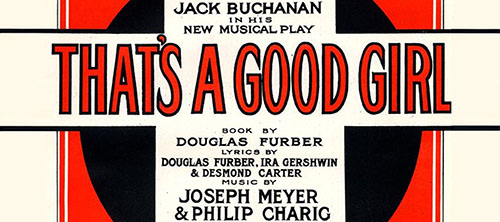
Musical
Musique: Charles Prentice • Joseph Meyer • Phil Charig • Paroles: Desmond Carter • Douglas Furber • Ira Gershwin • Livret: Douglas Furber • Production originale: 2 versions mentionnées
Dispo: Résumé Commentaire Liste chansons
Genèse:
Résumé: Bill Barrow, habitué à mener la grande vie, se cache en permanence des créanciers. Maintenant, il est poursuivi par une femme détective, Joy Dean, et son ami Timothy, mais cette fois-ci pas pour ses dettes, mais parce qu’un oncle riche lui a laissé une fortune à partager avec une cousine, Moya Malone. L’héritage est administré par tante Helen, qui tient à ce que Bill lui rende visite en compagnie d’un ami sensible, bien né, capable d’éloigner les chasseurs de fortune et les chercheurs d’or. Il emmène avec lui Francis Moray, baryton en chef à l’opéra, et fiancé de Sunya Berata, la diva très capricieuse de l’opéra. Leur visite à la tante dans le sud de la France, la poursuite d’une diva jalouse, et la romance qui se développe entre Moya et Francis mènent à des situations hilarantes qui parviennent à impliquer une troupe de huit Tiller Girls et les chœurs d’opéra de « Cavalleria Rusticana » et « I Pagliacci ».
Création: 5/6/1928 - Hippodrome (The) (Londres) - 365 représ.

Musical
Musique: George Gershwin • Paroles: Ira Gershwin • Livret: Frederick A. Thompson • Vincent Lawrence • Production originale: 1 version mentionnée
Dispo: Génèse Liste chansons
Treasure Girl a tenté de recréer la magie de Oh, Kay! (), le hit des Gershwins en 1926 avec Gertrude Lawrence, mais le nouveau musical n’a pas été à la hauteur… Lawrence jouait une jeune femme gâtée participant à une chasse au trésor, et ce musical ne lui a pas donné beaucoup de moments pour montrer sa personnalité pétillante qui avait fait d'elle une star de Broadway. L'œuvre contient des chansons parmi les plus sous-estimées de Gershwin, dont le classique I’ve Got a Crush on You et le duo attrayant I Don’t Think I’ll Fall in Love Today. Une chanson oubliée de Treasure Girl, What Causes That? est devenue un tube pour Harry Groener et Bruce Adler dans My one and only () en 1983.
Genèse: Treasure Girl était le musical de la saison que tout le monde attendait… Les chansons étaient de George et Ira Gershwin, la first lady était la star Gertrude Lawrence, les chorégraphies étaient de Bobby Connolly, et les producteurs Alex. A. Aarons et Vinton Freedley n'ont reculé devant rien pour proposer une production somptueuse avec un décor de Joseph Urban et des costumes de Kiviette. Alfred Newman dirigeait l’orchestre, les célèbres pianistes Victor Arden et Phil Ohman étaient là pour un numéro de spécialité, et la troupe comprenait une impressionante galerie de personnalités de Broadway, dont Clifton Webb, Mary Hay, Walter Catlett et Paul Frawley. Les chansons comprenaient un des futurs grands classiques de Gershwin, I’ve Got a Crush on You mais comprenanit de nombreuses autres très belles chansons don’t Oh, So Nice!, I Don’t Think I’ll Fall in Love Today, K-ra-zy for You, Where is the Boy? Here the Girl!, Feeling I’m Falling, What Are We Here For? et What causes that?. Pourtant, le spectacle n'a tenu que deux mois à Broadway. Que s’est-il passé? Le problème majeur est le livret de Fred Thompson et Vincent Lawrence. Leur histoire était assez prometteuse: lors d’une fête costumée à Long Island, ambiance pirates, les invités sont invités à jouer à un jeu passionnant: leur hôte a caché un trésor de 100.000$ en espèces sur une île déserte à proximité. Parmi les invités, on trouve Ann Wainwright, jouée par Gertrude Lawrence, dont les auteurs ont fait un femme avare et désagréable qui se soucie seulement de l’argent. C'est drôle évidemment mais les critiques et le public étaient déçus de retrouver Lawrence, le chouchou de Broadway, dans un rôle aussi aigre, et apparemment peu a été fait pour adoucir le personnage pendant les trois semaines de Try-Out à Philadelphie.
Résumé:
Création: 8/11/1928 - Neil Simon Theatre (Broadway) - 68 représ.

Musical
Musique: George Gershwin • Paroles: Gus Kahn • Ira Gershwin • Livret: William Anthony McGuire • Production originale: Florenz Ziegfeld • 1 version mentionnée
Dispo: Résumé Commentaire Génèse Liste chansons
Les Gershwins travaillaient dur sur un musical appelé East is West lorsque le producteur Florenz Ziegfeld a brusquement annulé le projet et l’a remplacé par cette adaptation du roman de J. P. McEvoy Show Girl. Ils ont eu besoin de l’aide de Gus Kahn comme parolier, parce que George et Ira étaient confrontés à des délais de création excessivement courts mais aussi à un livret terriblement incomplet. Le point culminant de Show Girl s’est produit lors des try-out à Boston quand Al Jolson assis dans le public a chanté avec Ruby Keeler – la first lady du show et sa nouvelle épouse – la chanson Liza. Il a continué à faire cela tous les soirs durant les premières semaines du spectacle de New York. L’échec financier de Show Girl a conduit Ziegfeld à cesser de payer les droits des Gershwin; ils se sont plaints et Ziegfeld a contre-attaqué en affirmant que George et Ira n’avaient pas livré un spectacle à succès. Le krach boursier à venir mettrait en grande partie fin à la carrière de The Great Ziegfeld.
Genèse: Selon Variety, Ziegfeld a jeté 150.000 $ dans la production de Show Girl, mais ce spectacle infaillible n’a pourtant pas été un succès et a quitté l’affiche en trois mois, malgré les rumeurs qu’avant son ouverture il avait déjà 20 semaines de représentations sold-out. Et pourtant, il y a avait les somptueux décors de Joseph Urban et costumes de John W. Harkrider, la musique était signée George Gershwin, les paroles ont été écrites conjointement par Ira Gershwin et Gus Kahn, les danses ont été conçues par Bobby Connolly et le livret était de William Anthony McGuire, qui avait écrit ceux des hits de Ziegfeld The Three Musketeers () et Whoopee! (). Et la star du show était la nouvelle Mme Al Jolson, autrement connue sous le nom de Ruby Keeler et Ruby Keeler Jolson (elle et Jolson s’étaient mariés près d’un an plus tôt, en septembre 1928, et divorceront en 1940). Elle avait laissé une impression favorable auprès des critiques et du public dans ses quatre apparitions antérieures à Broadway dans les chœurs ou même en vedette, et souvent en tant que danseuse principale («The Rise of Rosie O’Reilly», «Bye Bye», «Bonnie», «Lucky», et «Sidewalks of New York»), et Ziegfeld a voulu avec ce musical faire d’elle la prochaine reine de la comédie musicale à Broadway. Mais cela n’a pas tout à fait fonctionné de cette façon: les avis étaient mitigés à froids et elle a quitté le spectacle trois semaines après son ouverture (pour des raisons médicales non précisées…). Elle n’est revenue à Broadway que quarante-deux ans plus tard quand elle a triomphé en 1971 dans le revival à succès de No, No, Nanette de Vincent Youmans. Le cast de Show Girl comprenait également les populaires Lou Clayton, Eddie Jackson, et Jimmie Durante – ils triomphaient avec leurs numéros comiques dans les night-clubs – mais on tretoruvait aussi dans la distribution Nick Lucas, Eddie Foy Jr., Frank McHugh, Harriet Hoctor, Barbara Newberry, Joseph Macaulay et Doris Carson. Outre l’orchestre dans la fosse, on retrouvait sur scène rien de moins que Duke Ellington et son Cotton Club Orchestra. Et pour couronner le tout, la pièce orchestrale de Gershwin An American in Paris a été transformée en un somptueux ballet (ici intitulé American in Paris—Blues Ballet). Mais tout cet amoncellement très impressionnant n’a jamais décollé et a disparu en trois mois. Il a ouvert le 2 juillet, et quand Keeler s’est retirée de la production le 27 juillet, le musical a perdu la vedette sur lequel toute la publicité du show avait été construite. Le New York Times avait rapporté qu’en raison de problèmes de santé, Keeler serait remplacé par Dorothy Stone (qui avait assisté au show depuis le public pour la soirée d’ouverture quelques semaines plus tôt), mais resterait dans la production jusqu’à ce que Stone soit prête à assumer le rôle. Cependant, un article du 30 juillet dans le New York Daily News indiquait que Keeler s’était effondrée dans sa loge avant le spectacle du samedi soir, le 27 juillet, et qu’elle avait été admise à l’hôpital pour une opération «nécessaire pour lui sauver la vie». Doris Carson, qui était aussi l’understudy de Keeler, jouerait le rôle jusqu’à ce que Stone soit prête à intervenir. Le 2 août, le Times a déclaré que l’opération de Keeler avait eu lieu le 1er août, le jour même où Stone était arrivée à New York pour commencer les répétitions. Les critiques étaient assez bonnes, mais les lecteurs exigeants pouvaient lire entre les lignes et déduire que Show Girl n’était pas le spectacle de l’année et n’allait pas rejoindre les blockbusters appréciés de Ziegfeld: Sally (), Kid Boots (), Rio Rita (), Show Boat (), Rosalie (), The Three Musketeers () et Whoopee! (). Les critiques ont été particulièrement déçus par la partition la moins impressionnante de Gershwin, bien que les morceaux Liza et Do What You Do! aient été mentionnés favorablement. Mais aucune des chansons n’a jamais été un succès, et il était révélateur que les cinq chansons du spectacle pour Durante, Clayton et Jackson n’étaient pas de Gershwin mais de … Durante. En outre, Time a rapporté que la partition comprenait en plus deux autres chansons de Durante, qui n’étaient même pas répertoriées dans les programmes de Show Girl: Shades, Yellow Shades for the Window et Who Will Be with You When I’m Far Away?. Le spectacle a subi une révision drastique après l’ouverture. Cinq numéros ont été supprimés: le numéro des Albertina Rasch Dancers, How Could I Forget? (tous deux faisant partie du segment Magnolias), Lolita, My Love, Spain et Follow the Minstrel Band et quand Lucas a quitté le spectacle, son numéro a été coupé. Mississippi Dry a été ajouté pour la scène Magnolias où il a été interprété par Duke Ellington et Son Cotton Club Orchestra et les Jubilee Singers (qui a rejoint la distribution lorsque la chanson a été rajoutée). Comme indiqué, Keeler a quitté la série après environ trois semaines, tout comme Lucas.
Résumé: L’intrigue tournait autour de Dixie Dugan (Keeler), qui ne rêvait que d’une chose: être une star de la scène. L’histoire commençait par une scène d’une comédie musicale récente (imaginaire) de Ziegfeld appelée Magnolias, qui se déroule dans le Vieux Sud de la Virginie en 1863 où l’on découvre Durante dans un rôle blackface, Sombre Eyes. À partir de là, nous suivons les progrès de Dixie depuis le New Jersey, Brooklyn et Manhattan (y compris un arrêt au Club Caprice) jusqu’à la magnifique scène du Théâtre Ziegfeld et la production des Follies où elle devient une star (c’est pendant les séquences de Follies que l’on retrouve un ballet sur An American in Paris de Gerhwin et un numéro de Minstrel). En parallèle, quand Dixie n’est pas occupée à percer dans le show-business, elle est poursuivie par un trio d’hommes, dont Jimmy Doyle (McHugh), qui finira par gagner sa main.
Création: 2/7/1929 - Ziegfield Theatre (Broadway) - 111 représ.

Musical
Musique: George Gershwin • Paroles: Ira Gershwin • Livret: Morrie Ryskind • Production originale: 1 version mentionnée
Dispo: Résumé Génèse Liste chansons
Strike Up the Band is a 1927 musical with a book by Morrie Ryskind, lyrics by Ira Gershwin and music by George Gershwin. It ran in Philadelphia that year, unsuccessfully, and on Broadway in 1930 after the original book by George S. Kaufman was revised. The story satirizes America's taste for war: America declares war on Switzerland over a trivial trade issue.
Genèse: Strike Up the Band is a 1927 musical with a book by Morrie Ryskind, lyrics by Ira Gershwin and music by George Gershwin. It ran in Philadelphia that year, unsuccessfully, and on Broadway in 1930 after the original book by George S. Kaufman was revised. The original book by George S. Kaufman centered on Horace J. Fletcher, a Babbitt-like cheese tycoon who tries to maintain his monopoly on the American market by convincing the United States government to declare war on Switzerland. The story ended darkly. The 1930 plot by Ryskind, softened the political overtones, increased the emphasis on romance and added a happy ending. It relegated the war plot to a dream sequence. The incident that incites war concerned chocolate instead of cheese. During its original 1927 pre-Broadway tryouts, the political satire closed in Philadelphia, fulfilling original librettist's George S. Kaufman's definition of satire as "what closes on Saturday night." The original is heavily influenced by Gilbert and Sullivan. The Gershwins revised the story with Ryskind for the 1930 Broadway run; they also removed the song The Man I Love, now a Gershwin standard, from the show. They added a dozen new songs and rewrote the lyrics or even changed the melodies of many of the 1927 songs. The new score is less Gilbert-and-Sullivan and more swing-influenced. Directed by Alexander Leftwich and choreographed by George Hale, the revised production opened on Broadway at the Times Square Theatre on January 14, 1930 and closed on June 28, 1930 after a moderately successful run of 191 performances. The Gershwins' first fully integrated score for a book musical was influenced by the operettas of Gilbert and Sullivan.
Résumé: Horace J. Fletcher is a manufacturer of chocolates who is aggrieved that Washington has refused to raise the tariff on Swiss chocolates. A doctor gives him a sedative to help him sleep and this he does but the sedative also induces dreams. In his dream he sees himself at the head of an American Army that foes to war with Switzerland over the issue of chocolates. The war was funded by Fletcher who becomes a national hero, but not for long. The American newspapers uncover the unsavoury fact that Fletcher's chocolates use Grade B milk - a fact that shocks the whole nation. Fletcher's daughter Joan has a fiancé, Jim Townshend . Jim is suspicious of Fletcher, and has been from the first time they met. He threatens to expose Fletcher which causes the latter to become an ardent pacifist. This about face comes too late, however, to stop America going to war against Switzerland. The Swiss hotel-keepers are delighted. They are able to raise the prices of their rooms as the American soldiers need lodgings. The war is somewhat phoney as there is never any engagement. The Americans sit in their hotels knitting socks and sweaters for the folks back home. Accidentally, the enemy's secret call to arms is discovered - a yodel - and the American troops are able to corner and rout the Swiss army.
Création: 14/1/1930 - Times Square Theater (Broadway) - 191 représ.

Musical
Musique: George Gershwin • Paroles: Ira Gershwin • Livret: Guy Bolton • John McGowan • Production originale: 8 versions mentionnées
Dispo: Résumé Synopsis Commentaire Génèse Liste chansons
"Girl Crazy" was written during the Depression, partly in an attempt to lighten the spirits of its audiences. Although the plot is frothy, the musical score is exquisite and features such enduring and beloved standards as "Embraceable You" and "I've Got Rhythm."
Genèse: The musical opened at the Alvin Theatre on October 14, 1930 and closed on June 6, 1931 after 272 performances. It was directed by Alexander Leftwich, with choreography by George Hale and sets by Donald Oenslager. This musical made a star of Ginger Rogers, who, with Allen Kearns, sang "Could You Use Me?" and "Embraceable You" and, with Willie Howard, "But Not for Me". Ethel Merman, in her Broadway debut sang "I Got Rhythm", "Sam and Delilah", and "Boy! What Love Has Done To Me!" and "became an overnight sensation...that launched her fifty year career." Also of note is the opening night pit orchestra, which was composed of many well-known jazz musicians, including Benny Goodman, Gene Krupa, Glenn Miller and Jimmy Dorsey. "The score was one of the Gershwins' best" according to theatre writer Ken Bloom. In 1992 it was produced with a new title as the stage musical Crazy for You. The show was heavily revised, with a completely new plot, and songs from other Gershwin shows added. "Musicals Tonight!", New York City, presented a staged concert in September 2001. An abridged version of Girl Crazy was presented at the Kennedy Center in Washington, DC October 2–5, 2008 as part of their Broadway: Three Generations production. Max von Essen played Danny, Jenn Colella played Molly, and Randy Graff played Kate, directed by Lonny Price. The New York City Center Encores! staged concert was held in November 2009. Directed by Jerry Zaks, it starred Ana Gasteyer, Marc Kudisch, Becki Newton, and Wayne Knight.
Résumé: According to his father, Danny Churchill Jr. too focused on girls and parties. Thus, Danny’s father ships him off to a mostly male town in Arizona with the goal of getting Danny’s attention focused on more serious matters. However, soon after arriving, Danny falls in love with the local postmistress, Molly Gray. He wins Molly’s affections – but can he beat off a New York rival?
Création: 29/9/1930 - Shubert Theatre (Philadelphia) - 272 représ.

Musical
Musique: George Gershwin • Paroles: Ira Gershwin • Livret: George S. Kaufman • Morrie Ryskind • Production originale: 4 versions mentionnées
Dispo: Résumé Commentaire Génèse Liste chansons
Of Thee I Sing is a musical with a score by George Gershwin, lyrics by Ira Gershwin and a book by George S. Kaufman and Morrie Ryskind. The musical lampoons American politics; the story concerns John P. Wintergreen, who runs for President of the United States on the "love" platform. When he falls in love with the sensible Mary Turner instead of Diana Devereaux, the beautiful pageant winner selected for him, he gets into political hot water. The original Broadway production, directed by Kaufman, opened in 1931 and ran for 441 performances, gaining critical and box office success. It has been revived twice on Broadway and in concert stagings in the U.S. and in London. In 1932, Of Thee I Sing was the first musical to win the Pulitzer Prize for Drama.
Genèse: The Gershwins and George S. Kaufman had collaborated on a satirical musical in 1927 entitled Strike up the Band, which played in Philadelphia. The show concerned a cheese manufacturer who sponsors a war against Switzerland because it will be named after him. A version of Strike Up the Band, with the book altered by Morrie Ryskind, played on Broadway in early 1930. Much of the satire was replaced in the new version by silliness, leading Ryskind to recall, "What I had to do, in a sense, was to rewrite War and Peace for the Three Stooges." Later that year, Kaufman and Ryskind conceived a new musical focusing on satire about rival political parties battling over a new national anthem. The Gershwin brothers agreed to write the score, although they were scheduled to be in Hollywood writing songs for the film Delicious. Kaufman and Ryskind soon realized that their concept did not provide sufficient plot for a musical. They crafted a libretto inspired by the timeless battle of political idealism with corruption and incompetency, creating the first American musical with a consistently satiric tone. The writers and the cast were unsure of what the public's reception would be, prompting Kaufman's now-famous statement, "Satire is what closes on Saturday night." Productions The original Broadway production, directed by Kaufman, opened at the Music Box Theatre on December 26, 1931 and ran for 441 performances. The cast included William Gaxton as John P. Wintergreen, Lois Moran as Mary Turner, Grace Brinkley as Diana Devereaux, Victor Moore as Alexander Throttlebottom and George Murphy as Sam Jenkins. It was produced by Sam H. Harris. Sets were designed by Jo Mielziner, costumes by Carles LeMaire, and dances staged by Georgie Hale. It was Gaxton and Moore's first comedic pairing; they would collaborate on six more Broadway musicals, including Anything Goes. The orchestrations were by Robert Russell Bennett, William Daly (including the "Overture"), and Gershwin ("Hello, Good Morning"). Of Thee I Sing was the longest-running Gershwin show during George Gershwin's lifetime. There were Broadway revivals in 1933 at the Imperial Theatre and in 1952 at the Ziegfeld Theatre, both directed by Kaufman. A concert production of Of Thee I Sing was mounted by Ian Marshall Fisher's Lost Musicals series at the Barbican Centre in London in August 1996. Fisher's series examines the Gershwins' lesser known works (as well as others) and has been based at London's Royal Opera House and Sadler's Wells. The musical was presented in May 2006 as part of the New York City Center Encores! staged concert series. Directed by John Rando and choreographed by Randy Skinner, the cast starred Victor Garber as John P. Wintergreen, Jefferson Mays as Vice President, Alexander Throttlebottom, and Jennifer Laura Thompson as First Lady. The latest revival was in July 2015 at the Royal Festival Hall, London by producer Ollie Rosenblatt as a full musical with orchestra. Diana Devereaux was played by Hannah Waddingham, Wintergreen by Hadley Fraser and Throttlebottom by Tom Edden. The Royal Philharmonic Concert Orchestra provided the new musical setting for the piece. In September 2015 the Sqabbalogic theatre company and Sydney Philharmonia Choirs presented the musical in the Concert Hall, Sydney Opera House.
Résumé:
Acte I
In the U.S. in the 1930s, a campaign parade is taking place to support Wintergreen for President. John P. Wintergreen has been nominated for President and Alexander Throttlebottom has been nominated for Vice President, but he is of such little importance no one can remember who he is. Politicians meet in a hotel room to devise a campaign platform, and when they ask the chambermaid what she cares about, she first says "money," then "love" when pressed further. The men decide that Wintergreen's platform will be "love;" they'll have a pageant to select the most beautiful girl in the United States, and Wintergreen will fall in love and marry her. The pageant begins in Atlantic City, New Jersey, and the contestants wonder, Who is the Lucky Girl to Be? The photographers assure them that even if they do not win, they will surely be loved (The Dimple on My Knee). Wintergreen is getting nervous about marrying a girl he doesn't know. While the girls are at the final judging, he confides in Mary Turner, the sensible young woman running the pageant. He does not want to marry a girl just because she's beautiful; he wants a wife who will make a good home for him and his future children. Mary shares her corn muffin with him. Wintergreen tells Mary that he'd rather marry her than any of the girls in the contest. He kisses her, and she agrees to marry him. The judges of the pageant announce that Diana Devereaux, a beautiful southern girl, has won the contest, but Wintergreen declares that he loves Mary Turner. When he gives some of Mary's extraordinary corn muffins to the judges, they agree that John and Mary are meant to wed (Because, Because). Outside Madison Square Garden in New York City, at a rally for Wintergreen, the campaigners declare that Love is Sweeping the Country. Inside, where politicians are speaking in favor of Wintergreen, a wrestling match is going on just below the speakers' platform as Alexander Throttlebottom tries to explain to the organizers that he's the candidate for Vice-President. Wintergreen proposes to Mary onstage, as he has in forty-seven states before. She accepts again, and Wintergreen sings the campaign song to her, Of Thee I Sing. On election night, Wintergreen wins by a landslide. Inauguration day arrives, which is also Wintergreen's wedding day. As his inaugural address, Wintergreen bids goodbye to the girls he used to know (Here's a Kiss for Cinderella). The Chief Justice presides over the wedding ceremony, and just after he has pronounced John and Mary man and wife, Diana Devereaux interrupts the proceedings. She is serving Wintergreen with a summons for breach of promise. She insists she is the one he should have married (I Was the Most Beautiful Blossom). The Supreme Court rules that Mary's corn muffins are more important than justice in this matter, and Diana angrily leaves to tell her story across the nation. Wintergreen leads the Supreme Court and spectators in a chorus of Of Thee I Sing.Acte II
John and Mary settle down to business in the White House. Her "desk," back-to-back with his, is a fully loaded tea-table. Their secretaries greet each other "Hello, Good Morning." Alexander Throttlebottom, now Vice-President, sneaks into the White House with a tour group. When a guide tells him that the Vice-President's job is to preside over the U. S. Senate, Throttlebottom eagerly dashes off to the Capitol. Wintergreen's fellow party members inform him that Diana Devereaux is gaining support across the nation. Wintergreen holds a press conference and tells the reporters that his love for Mary is the only thing that matters (Who Cares?). The French ambassador unexpectedly arrives (Garçon, S'il Vous Plaît). He has a surprise for Mr. Wintergreen: Diana is "'The Illegitimate Daughter' of the illegitimate son of the illegitimate nephew of Napoleon." He insists that Wintergreen annul his marriage and marry Diana to right his grievous offense against France. Everyone agrees that Wintergreen should be impeached for breach of promise (We'll Impeach Him), but John and Mary do not care, since they have each other (Who Cares?" (Reprise)). Throttlebottom has found the Senate, and the party members inform him that he will soon be President. He is very excited and goes into the Senate Chamber to preside, beginning by taking "The Roll Call." The resolution on the impeachment of the President is brought up, and the French Ambassador and Diana mournfully insist that she was Jilted. Mary saves the day when she announces that she is pregnant (Who Could Ask For Anything More?). The senators refuse to impeach an expectant father, and Wintergreen declares that Posterity is just around the corner. The French Ambassador informs Wintergreen that by not marrying Diana, he has contributed to France's declining birth rate. He demands the Wintergreens' baby as a replacement for the one they have "taken" from France. John refuses, and the ambassador walks out. In the Yellow Room of the White House, guests are arriving bearing gifts for the baby (Trumpeter, Blow Your Horn). Wintergreen is nervously awaiting the baby's birth when the French Ambassador arrives with a final message from France: surrender the baby or France will sever diplomatic relations with the U.S. The Supreme Court justices, who have the duty to determine the sex of the baby, announce that twins have been born, a boy and a girl. The French ambassador is even more wounded by this proclamation: France has lost two babies instead of one! Diana mournfully joins him, and Alexander Throttlebottom arrives bearing sweaters for the babies. The French Ambassador is about to declare war when Wintergreen has a brilliant idea: according to Article Twelve of the Constitution, when the President of the United States is unable to fulfill his duties, his obligations are assumed by the Vice-President! The ambassador calls Wintergreen a genius, and Throttlebottom is ecstatic as they pass Diana over to him. Servants wheel a large bed into the room, where Mary sits with the babies. Wintergreen leads everyone in proclaiming, "Of Thee I Sing."Création: 26/2/1931 - Music Box Theatre (Broadway) - 441 représ.

Musical
Musique: George Gershwin • Paroles: Ira Gershwin • Livret: Herbert Fields • Morrie Ryskind • Production originale: 1 version mentionnée
Dispo: Résumé Génèse Liste chansons
Genèse: Producers Alex A. Aarons and Vinton Freedley approached the Gershwins to create a showcase for the talents of English music hall star Jack Buchanan, and linked them with Fields and Ryskind, whose book required the actor to appear in dual roles, lower-class German thug Golo Schmidt and upper-crust British nobleman Michael Bramleigh. The sophisticated Buchanan had no problem portraying Bramleigh but was unable to capture the essence of Schmidt. The show opened in Philadelphia to critical pans. Rather than proceed to Broadway, the creative team added characters and expanded the role of police commissioner Bauer, played by radio's "Baron Munchausen", Jack Pearl. The revised production opened in Newark on January 2, 1933, but it was obvious that Buchanan was still a major problem. He bought out his contract and the producers replaced him with dialect comedian George Givot. The production opened on Broadway on January 20, 1933, at the Majestic Theatre and ran for 43 performances. The book was directed by John McGowan, the production was staged by producer Vinton Freedley, and the musical numbers were staged by George Hale. In addition to Givot and Pearl, the cast included Josephine Huston as Bauer's daughter Ilse and musical-comedy star Lyda Roberti (her speciality was a "polyglot of Polish, German, and near-Hungarian") as Gita Gobel. According to Ben Brantley, "By the time it hit Broadway it was a desperately stitched patchwork that ran for 33 performances before exiting into oblivion. It was, Ira Gershwin later wrote, 'a headache from start to finish'." The critics unanimously condemned it. In 1982, a producer discovered a number of the musical's manuscripts in the Warner Brothers warehouse in Secaucus, New Jersey. The score was pieced together and performed at the Library of Congress in concert in 1987. Elektra Records released a studio cast album featuring John Cullum and William Katt in 1993. New York City Center's Encores! presented a staged concert in 2004, with a revised book by David Ives. Directed by Gary Griffin and choreographed by Rob Ashford, it featured Brian d'Arcy James as Golo/Michael, Emily Skinner as Gita, Jennifer Laura Thompson as Frieda (originally Ilse), and Rob Bartlett as Bauer. 42nd Street Moon, San Francisco, California, presented a staged concert in November 2006. The European premiere took place on November 29, 2009, at the Dresden State Operetta in Dresden, translated by Wolfgang Adenberg, directed by Holger Hauer and conducted by Ernst Theis.
Résumé: In order to promote the sale of beer and wine, the German government bans the sale of all non-alcoholic beverages. In retaliation, Golo Schmidt opens Club 21, a speakeasy where patrons can imbibe such forbidden drinks as cream soda and ginger ale. Police Commissioner Bauer makes it his mission to shut down the illegal operation. Golo decides to disrupt a birthday celebration for Bauer, but while en route to the party he is struck by a car and knocked unconscious. When he awakens in Bauer's home, he believes he is Michael Bramleigh, a wealthy, sophisticated member of British society. He eventually falls in love with Bauer's daughter Ilse and proposes marriage. A birdhouse falls on Bramleigh, and his memory returns. Golo once again, he has no memory of his relationship with Ilse and returns to Club 21 and his sweetheart Gita Gobel. Hearing Bauer's daughter is about to marry, he plans to kidnap the bride and hold her for ransom. At the wedding, Golo locates Ilse, who naturally thinks he's her fiancé Michael, and the two escape to an inn in Schandau. Golo, inexplicably thinking he's Michael once again, returns to Bauer's house and apologizes for missing the wedding. The two plot to find Ilse and save her from her kidnapper. Recognized as Golo by some and Michael by others, the hero becomes involved in a series of comic misadventures.
Création: 20/1/1933 - Majestic Theatre (Broadway) - représ.

Musical
Musique: George Gershwin • Paroles: Ira Gershwin • Livret: George S. Kaufman • Morrie Ryskind • Production originale: 1 version mentionnée
Dispo: Résumé Génèse Liste chansons
Genèse: The original Broadway production of Let 'Em Eat Cake opened October 21, 1933 at the Imperial Theatre, New York City, USA and ran for 89 performances. It had The cast included William Gaxton as J.P. Wintergreen, Victor Moore as Alexander Throttlebottom, Philip Loeb as Kruger, and Lois Moran as Mary Wintergreen. The no longer extant orchestrations were by Edward B. Powell. The show carried a message that audiences did not want to hear and it was a failure. However, it did have one song: "Mine". Several musical themes from Of Thee I Sing are reused in Let 'Em Eat Cake, including the Supreme Court Judges' song and the campaign song "Wintergreen for President", which includes parts of folk and patriotic songs such as Sousa's "Stars and Stripes Forever", and "Hail, Hail, the Gang's All Here." A concert version of the show was performed on BBC Radio in 1994 (with a cast that included: Denis Quilley, Kim Criswell, Joss Ackland, Henry Goodman, and Louise Gold), and Opera North staged the show, along with a revival of Of Thee I Sing, during its 2008–9 season. The Opera North production was broadcast by BBC Radio 3 on Saturday, 26 September 2009, as part of its Opera on 3 series.
Résumé:
Acte I
President Wintergreen is up for reelection, but due to the continuing Great Depression, loses in a landslide to John P. Tweedledee. Wintergreen makes an unsuccessful appeal to the Supreme Court to overturn the election results. It is also revealed that Diana Deveraux divorced Throttlebottom to marry the French Ambassador. After the end of his term, Wintergreen, Throttlebottom, and their associates start a business selling his wife Mary's blue shirts on "Union Square." At Union Square, Kruger, an agitator, is proclaiming his doctrine "Down with Everything That's Up." After talking with Kruger, Wintergreen decides that to increase shirt sales they should promise a revolution or their money back, citing the European Brown Shirts and Black Shirts. With business now booming ("Shirts by Millions"), Mary appeals to the women to join the New Blue D.A.R. ("Climb up the Social Ladder") to increase female shirt sales. Wintergreen now needs the support of the Union League Club, because General Snookfield is a member. Throttlebottom persuades them by saying that the British are attacking Bunker Hill ("Comes the Revolution Reprise"). Having secured the Union League Club support, The Blue Shirts meet with Snookfield to plan the overthrow of the government ("On and On and On"). At nine o'clock on July 4, when the Blue Shirts arrive, Snookfield will give the signal for his soldiers to seize Tweedledee. On the Fourth, at the White House grounds, Tweedledee is giving a speech, when Snookfield leaves with Trixie for a party. The Blue Shirts arrive only to find the general is missing and the soldiers don't know what to do. Tweedledee promises the army a "dollar a day which (he) may not pay." Wintergreen promises the army the war debts owed by the League of Nations, which the soldiers accept. Tweedledee is deposed, and Wintergreen declares that "the land of freedom is free once more" ("Let 'Em Eat Cake").Acte II
The White House is being painted "Blue, Blue, Blue." The Supreme Court, now in chains, are brought before Wintergreen. He decides to show leniency because the Court officiated his marriage ceremony. The Court is reorganized into a baseball team. When the League of Nations arrives to discuss repayment of the war debts, they "No Comprenez, No Capish, No Versteh" when the issue is raised; only Finland repays their debt. Kruger, now head of the army following Snookfield's disgrace, is also putting pressure on Wintergreen to remember his promise. Wintergreen offers a solution where the debts will be settled by a baseball game for double or nothing. If the League loses, they will have another conference to discuss it. Kruger accepts the League's offer of Finland's money as a side bet. Throttlebottom hesitatingly accepts an offer to be the game's umpire. On the date of the ballgame the Supreme Ball Players, the League, and Kruger's army try to influence Throttlebottom to bend the rules their way. The United States loses the game after a controversial call by umpire Throttlebottom. The soldiers want someone to be held to account for the loss, over Wintergreen and his associates' objections ("Oyez, Oyez, Oyez"). In the "Trial of Throttlebottom" a military tribunal is underway. Kruger, the Army, and the Ball Players call for Throttlebottom's execution claiming he conspired with the enemy. Wintergreen and his associates object, until the army levels the guns at them. Kruger and the army want to know when they are going be paid ("A Hell of a Hole"). After Wintergreen offers them a share of the shirt business, the army is going to take it all (Down With Everything That's Up—Reprise). Despite pleading he tried his best to get the money ("It Isn't What You Did"), Kruger sentences Wintergreen and his cronies to death by beheading. Mary and the condemned's wives enter and proclaim they are pregnant. Kruger says this may have worked four years ago during Wintergreen's impeachment hearings, but it doesn't work with the army. Trixie, who controls the Navy, arrives and joins forces with Kruger ("First Lady and First Gent"). Kruger proclaims "Let 'em Eat Caviar." Execution day arrives, and in their jail cell Wintergreen, Throttlebotton, and the Committee discuss how they ended up in this situation. Next, the crowds gather to watch the executions ("Hanging Throttlebottom in the Morning"). A guillotine bought from France is unveiled, and Snookfield is shown to be the executioner. Since Throttlebottom is not married, he will be executed first. After a series of mishaps with the guillotine, Mary interrupts the proceedings. She presents a "Fashion Show" with dresses that arrived on the boat that brought the guillotine. After being reminded that the color of the revolution is blue, and they cannot wear the new fashions, the women revolt. Kruger objects, but the soldiers seize him after Trixie reminds them of an upcoming party. Wintergreen tells the soldiers to shoot Kruger. When Kruger reveals he used to be in the dress making business, Wintergreen decides to go into business with him. Wintergreen decides to leave the revolution business and restores the republic and the Supreme Court. Tweedledee shows up and Wintergreen gives his vice-president, Throttlebottom, to him, since he can't remember his. Tweedledee declines the Presidency, since he is going to be President of Cuba. Throttlebottom is now the President. After Wintergreen promised the people cake and Kruger promised them caviar, Throttlebottom promises them pistache ice cream, which he formerly detested.Création: 21/10/1933 - Imperial Theatre (Broadway) - 90 représ.
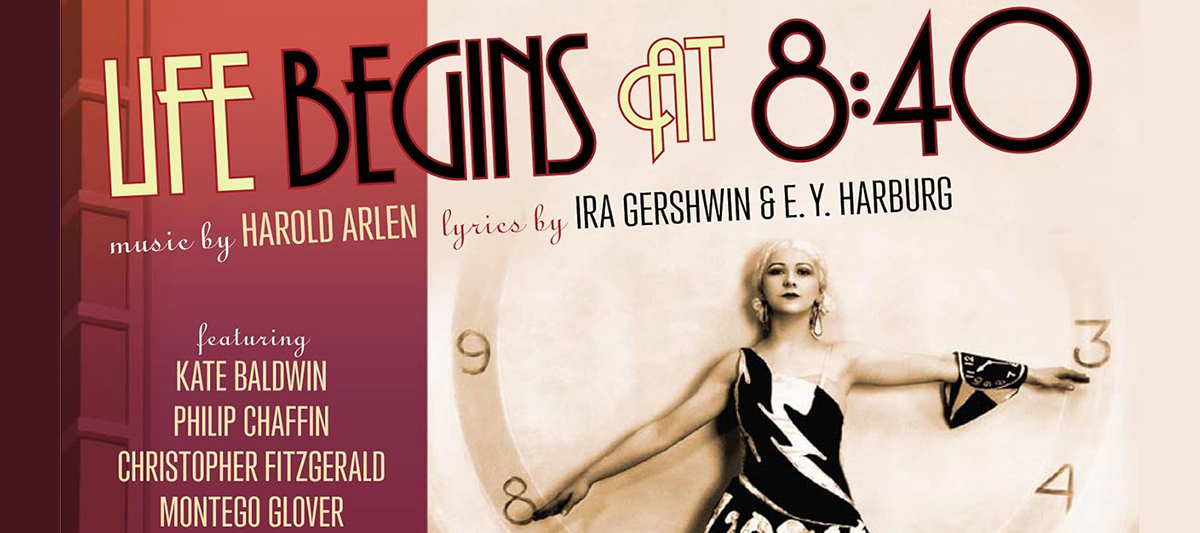
Revue
Musique: Harold Arlen • Paroles: E.Y. Harburg • Ira Gershwin • Livret: *** Revue • Production originale: 1 version mentionnée
Dispo: Liste chansons
La revue Life Begins at 8:40 était une débauche de stars, de chansons et de sketches. Le spectacle a eu une très belle série de 237 représentations avant un bel US Tour. Il y avait en tête d’affiche le comique Bert Lahr et le danseur Ray Bolger, la causitque comédienne Luella Gear, et la chanteuse Frances Williams. La partition avait des paroles d’Ira Gershwin et E. Y. Harburg et la musique d’Harold Arlen était pleine de délices, et a offert un standard, l’optimiste et plein d’entrain Let’s Take a Walk around the Block, qui a été présenté par Earl Oxford et Dixie Dunbar (deux commis dans une agence de voyages qui ne peuvent pas se permettre de se rendre dans des endroits lointains, mais qui apprécient néanmoins les plaisirs simples de la vie), et deux plus petits standards (Fun to Be Fooled et What Can You Say in a Love Song?). Time a qualifié la production de «meilleur divertissement de premier ordre de la saison».
Genèse:
Résumé:
Création: 27/8/1934 - Winter Garden Theatre (Broadway) - 237 représ.

Musical
Musique: George Gershwin • Paroles: DuBose Heyward • Ira Gershwin • Livret: DuBose Heyward • Production originale: 23 versions mentionnées
Dispo: Résumé Commentaire
il aura fallu attendre les années 1980 pour que Porgy and Bess soit reconnu aux États-Unis comme un véritable opéra. Au XXIe siècle, c'est un classique du répertoire lyrique américain. Musicalement, Porgy and Bess réussit une synthèse innovante entre les techniques orchestrales européennes, le jazz américain et la musique populaire.
Genèse:
Résumé:
Acte I
Scène 1 - Catfish Row, un soir d'été
L'opéra commence par une petite introduction très vivace (Allegro con brio). Le rideau s'ouvre sur un soir d'été à Catfish Row. Jabso Brown joue du piano et Clara chante une berceuse pour son enfant (Summertime) pendant que les hommes se préparent à jouer au craps. Le mari de Clara, Jake, tente lui aussi de chanter une berceuse (A woman is a sometime thing), qui n'apaise guère le bébé. Porgy, un mendiant estropié, arrive pour organiser le jeu. Crown, un voyou, et sa femme Bess entrent, et le jeu commence. Sportin' Life, fournisseur de cocaïne et d'alcool de contrebande, prend lui aussi part au jeu. Petit à petit les joueurs quittent le jeu, et il ne reste plus que Robbins et Crown. Lorsque Robbins gagne, Crown, qui est maintenant complètement ivre, commence à se battre, et finit par tuer Robbins. Crown s'enfuit, demandant à Bess de se débrouiller toute seule. Tout le monde l'abandonne, sauf Porgy, qui la protège.Scène 2 - Chambre de Serena, la nuit suivante
La famille et les amis de Robbins chantent un spiritual (Where is brudder Robbins?). Une soucoupe est posée sur sa poitrine pour récolter de l'argent pour son enterrement. Un détective blanc entre, et dit à Serena, la femme de Robbins, qu'elle doit enterrer son mari rapidement, si elle veut éviter que le corps soit donné à des étudiants de médecine. Il arrête Peter, un badaud, qu'il oblige à témoigner contre Crown. Serena pleure la perte de son mari (My man's gone now). L'ordonnateur des pompes funèbres entre et accepte d'enterrer Robbins si Serena promet de le payer plus tard. Bess et le chœur terminent l'acte avec Leavin' for the Promise' Land.Acte II
Scène 1 - Catfish Row, un mois plus tard, le matin
Jake et les autres pêcheurs s'apprêtent à travailler (It take a long pull to get there). Clara demande à Jake de ne pas y aller, et de venir plutôt à un pique-nique. Mais Jake lui répond qu'ils ont terriblement besoin de cet argent. Cela pousse Porgy à chanter son point de vue sur la vie de sa fenêtre (I got plenty o' nuttin). Sportin' Life traîne dans le coin, à vendre de la cocaïne, mais rapidement, la colère de Maria se déchaîne (I hates yo' struttin' style). Un avocat véreux, Frazier, arrive et prononce le divorce de Bess et de Crown. Archdale, un policier blanc, entre et informe Porgy que Peter va bientôt être relâché. Un faucon de mauvais augure traverse Catfish Row, et Porgy chante Buzzard keep on flyin' over. Alors que les autres habitants de Catfish Row se préparent pour le pique-nique, Sportin' Life demande à Bess de partir avec lui pour New York, pour y entamer une nouvelle vie; elle refuse. Bess et Porgy sont maintenant seuls, et s'avouent leur amour (Bess, you are my woman now). Le chœur entre de nouveau, avec entrain car ils s'apprêtent à partir pique-niquer (Oh, I can't sit down). Porgy reste à la traîne alors que tous partent au pique-nique. Porgy chante de nouveau I got plenty o' nuttin.Scène 2 - Kittiwah Island, l'après-midi
Le chœur s'amuse au pique-nique (I ain't got no shame doin' what I like to do!). Sportin' Life explique aux participants sa conception cynique de la Bible (It ain't necessarily so), ce qui amène Serena à le réprimander (Shame on all you sinners!). Crown arrive pour parler à Bess, et lui rappelle que Porgy est "temporaire". Bess veut définitivement quitter Crown (Oh, what you want wid Bess ?) mais Crown s'arrange pour qu'elle le suive en se cachant dans les bois.Scène 3 - Catfish Row, une semaine plus tard, à la tombée de la nuit
Jake part pêcher. Peter est sorti de prison. Bess est couchée dans la chambre de Porgy, où elle délire. Serena prie pour guérir Bess (Oh, Doctor Jesus). La marchande de fraises et le vendeur de crabe appellent les gens dans la rue, et Bess guérit rapidement de sa fièvre. Bess parle de ses péchés à Porgy (I want to stay here) avant de crier à Porgy son amour (I Loves You, Porgy (en)). Porgy promet de la protéger de Crown. La scène se termine avec le son d'une cloche signalant l'arrivée d'une tempête.Scène 4 - Chambre de Serena, fin de la journée suivante
Les habitants de Catfish Row prolongent le son de la tempête par leurs prières. Un coup est frappé à la porte et le chœur pense que c'est la Mort qui arrive (Oh there's somebody knocking at the door). Crown entre à la recherche de Bess. Le chœur essaye de prier pour faire partir Crown, ce qui lui fait chanter A red-headed woman make a choo-choo jump its track. Clara voit le bateau de Jake chavirer et elle court à sa rescousse. Crown affirme que Porgy n'est pas vraiment un homme puisqu'il ne peut pas sortir porter secours. Crown part et le chœur finit sa prière.Acte III
Scène 1 - Catfish Row, la nuit suivante
Le chœur pleure la mort de Clara (Clara, don't you be downhearted). Crown arrive et réclame Bess. La bagarre qui s'ensuit se termine par la victoire de Porgy, il tue Crown d'un coup de couteau dans le dos et l'étrangle, Porgy s'exclame alors You've got a man now. You've got Porgy! (Tu as un homme maintenant. Tu as Porgy !).Scène 2 - Catfish Row, l'après-midi suivant
Un détective entre et s'entretient avec Serena et Maria des meurtres de Crown et de Robbins. Elles affirment ne rien savoir et le détective se rend compte qu'il n'arrivera pas à les faire parler. Il demande à Porgy de venir identifier le corps de Crown, mais Porgy est inquiet. Sportin' Life lui raconte que les corps se mettent à saigner en présence de leur meurtrier, ce qui permettra au détective de mettre Porgy en prison. Porgy refuse d'aller reconnaître le corps et est arrêté pour entrave à la justice. Sportin' Life oblige Bess à prendre de la cocaïne et lui raconte que Porgy va rester en prison pour très longtemps. Il lui dit qu'elle devrait commencer une nouvelle vie avec lui à New York (There's a boat dat's leavin' soon for New York). Elle s'en va, mais il sait qu'elle va le suivre, puisqu'elle ne sait pas quand Porgy va revenir.Scène 3 - Catfish Row, une semaine plus tard
Porgy revient à Catfish Row avec beaucoup d'argent, après avoir joué au craps dans la rue avec ses dés pipés. Il offre des cadeaux aux habitants et ne comprend pas pourquoi tous ont l'air si abattus. Il voit Serena avec le bébé de Bess et lui demande où elle est. Maria et Serena lui racontent qu'elle est partie à New York avec Sportin' Life (Bess is gone). Porgy jette ses béquilles et part à sa recherche (I'm on my way).Création: 10/10/1935 - Neil Simon Theatre (Broadway) - 124 représ.

Musical
Musique: George Gershwin • Harold Arlen • Herman Hupfeld • Richard Rodgers • Will Irwin • Paroles: E.Y. Harburg • Herman Hupfeld • Howard Dietz • Ira Gershwin • Lorenz M. Hart • Ted Fetter • Livret: David Freedman • Moss Hart • Production originale: 1 version mentionnée
Dispo:
Genèse:
Résumé:
Création: 25/12/1936 - Winter Garden Theatre (Broadway) - 236 représ.

Film
Musique: George Gershwin • Paroles: Ira Gershwin • Livret: Allan Scott • Ernest Pagano • Production originale: 1 version mentionnée
Dispo: Résumé Commentaire Génèse
Shall We Dance, released in 1937, is the seventh of the ten Astaire-Rogers musical comedy films. The idea for the film originated in the studio's desire to exploit the successful formula created by Richard Rodgers and Lorenz Hart with their 1936 Broadway hit On Your Toes. The musical featured an American dancer getting involved with a touring Russian ballet company. In a major coup for RKO, Pandro Berman managed to attract the Gershwins – George Gershwin who wrote the symphonic underscore and Ira Gershwin the lyrics – to score this, their second Hollywood musical after Delicious in 1931.
Genèse: Production While the film – the couple's most expensive to date – benefits from quality comedy specialists, opulent art direction by Carroll Clark under Van Nest Polglase's supervision, and a timeless score which introduces three classic Gershwin songs, the convoluted plot and the curious absence of a romantic partnered duet for Astaire and Rogers – a hallmark of their musicals since The Gay Divorcee (1934) – contributed to their least profitable picture to date. Astaire was no stranger to the Gershwins, having headlined, with his sister Adele, two Gershwin Broadway shows: Lady Be Good! in 1924 and Funny Face in 1927. George Gershwin also accompanied the pair on piano in a set of recordings in 1926. Rogers first came to Hollywood's attention when she appeared in the Gershwins' 1930 stage musical Girl Crazy. Shall We Dance was named at the suggestion of Vincente Minnelli, who was a friend of the Gershwins. Minnelli originally suggested "Shall We Dance?" with a question mark, which disappeared at some point. Reception Shall We Dance earned $1,275,000 in the US and Canada and $893,000 elsewhere, resulting in a profit of $413,000, less than half the previous Astaire-Rogers film. It was neither a box office nor a critical success, and was taken as an indication that the Astaire-Rogers pairing was slipping in its audience appeal.
Résumé: Peter P. Peters (Fred Astaire), an American ballet dancer billed as "Petrov", dances for a ballet company in Paris owned by the bumbling Jeffrey Baird (Edward Everett Horton). Peters secretly wants to blend classical ballet with modern jazz dancing, and when he sees a photo of famous tap dancer Linda Keene (Ginger Rogers), he falls in love with her. He contrives to meet her, but she is less than impressed. They meet again on an ocean liner traveling back to New York, and Linda warms to Petrov. Unknown to them, a plot is launched as a publicity stunt "proving" that they are actually married. Outraged, Linda becomes engaged to the bumbling Jim Montgomery (William Brisbane), much to the chagrin of both Peters and Arthur Miller (Jerome Cowan), her manager, who secretly launches more fake publicity. Peters and Keene, unable to squelch the rumor, decide to actually marry and then immediately get divorced. Linda begins to fall in love with her husband, but then discovers him with another woman, Lady Denise Tarrington (Ketti Gallian), and leaves before he can explain. Later, when she comes to his new show to personally serve him divorce papers, she sees him dancing with dozens of women, all wearing masks with her face on them: Peters has decided that if he cannot dance with Linda, he will dance with images of Linda. Seeing that he truly loves her, she happily joins him onstage.
Création: 7/5/1937 - *** Film (***) - représ.

Film
Musique: George Gershwin • Vernon Duke • Paroles: Ira Gershwin • Livret: Production originale: 1 version mentionnée
Dispo: Résumé Commentaire
The Goldwyn Follies is a 1938 Technicolor film written by Ben Hecht, Sid Kuller, Sam Perrin and Arthur Phillips, with music by George Gershwin, Vernon Duke, and Ray Golden, and lyrics by Ira Gershwin and Sid Kuller. Some sources credit Kurt Weill as one of the composers, but this is apparently incorrect. The Goldwyn Follies was the first Technicolor film produced by Samuel Goldwyn.
Genèse:
Résumé: The movie, which features Adolphe Menjou, Vera Zorina, Edgar Bergen (with Charlie McCarthy), Andrea Leeds, Kenny Baker, Ella Logan, Helen Jepson, Bobby Clark and the Ritz Brothers, depicts a movie producer who chooses a simple girl to be "Miss Humanity" and to critically evaluate his movies from the point of view of the ordinary person. The style of the film is very similar to other musicals of its era, including the "Gold Diggers" series and others. The film is an effective satire on Hollywood and has some excellent numbers choreographed by George Balanchine.
Création: 4/2/1938 - *** Film (***) - représ.
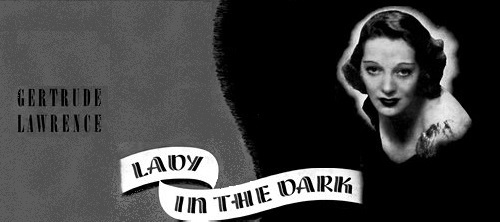
Musical
Musique: Kurt Weill • Paroles: Ira Gershwin • Livret: Moss Hart • Production originale: 2 versions mentionnées
Dispo: Résumé Synopsis Commentaire Génèse Liste chansons
Lady in the Dark a été l’événement musical de la saison 1940-1941, et toutes ses représentations étaient sold-out, y compris les places debout. Tout le monde le savait, cette œuvre était le musical le plus moderne dans laquelle une légende théâtrale jouait le rôle de sa vie. Gertrude Lawrence a joué ce qui était (avec Rose dans le futur Gypsy ()) peut-être le Hamlet des rôles musicaux féminins. Son contrat prévoyait qu'elle avait droit à des vacances l’été. Ainsi, la comédie musicale a joué 162 représentations sold-out, s'est arrêtés les onze semaines de vacances de Gertrude Lawrence, puis a rouvert ses portes à l’automne pour 305 représentations supplémentaires (le total des représentations totalisera 467). Après un US-Tour, en 1943, Lawrence revient au Broadway Theatre pour un 'return engagement' de 83 représentations.
Genèse: Création Le musical a ouvert à Broadway à l'Alvin Theatre (l'actuel Neil Simon Theatre) le 23 janvier 1941 et a fermé le 30 mai 1942 après 467 représentations. Le spectacle produit par Sam H. Harris a été mis en scène par Moss Hart avec une direction musicale de Hassard Short et des chorégraphies d’Albertina Rasch. Les acteurs de la création étaient Gertrude Lawrence, Danny Kaye, Bert Lytell, Victor Mature, Margaret Dale, Davis Cunningham et Macdonald Carey. La performance de Danny Kaye dans le rôle du photographe de mode Russell Paxton, et en particulier sa performance dans la chanson Tschaikowsky (and Other Russians) dans laquelle il énonce les noms de 50 compositeurs russes en 39 secondes, fait de lui une star. Le musical a fait un US-Tour de huit villes et 160 représentations, et a également joué sur la côte ouest, y compris Los Angeles et San Francisco, pour 56 représentations. Le spectacle est ensuite revenu a Broadway, pour ce que l'on appelle un "return engagement" au Broadway Theatre du 27 février au 15 mai 1943 pour 83 représentations. Gertrude Lawrence a joué son rôle de Liza Elliott dans toutes les salles. Autres productions Lady in the Dark a été créée au Royaume-Uni seulement le 9 décembre 1981 au Nottingham Playhouse de Nottingham. A New York City Center Encores! a proposé un concert semi-scénique du en mai 1994 avec Christine Ebersole. Et enfin, le musical a été créé à Londres au Royal National Theatre le 11 mars 1997, présentant 63 représentations jusqu’au 2 août 1997, dans une mise en scène de Francesca Zambello et avec Maria Friedman dans le rôle de Liza. La production a reçu le Evening Standard Award du meilleur musical.
Résumé: Liza Elliott (Gertrude Lawrence), est une éditrice de magazine de mode à succès. Cette dernière se retrouve constamment en proie à l'indécision dans sa vie professionnelle et personnelle. Elle est courtisée par deux hommes, l'éditeur déjà marié Kendall Nesbitt qui tente de divorcer de sa femme pour Liza, et son directeur de la publicité Randy Curtis, et ne peut pas décider qui choisir. Lorsqu'elle décide de recourir à la psychanalyse, elle plonge dans ses rêves et ses souvenirs d'enfance malheureuse. Le musical est constitué ainsi principalement de trois de ses rêves, racontées au psychanalyste. Liza se rend compte qu’elle aime son assistant qui fait preuve de sagesse lorsqu’il termine sa mélodie de rêve, My Ship.
Création: 23/1/1941 - Neil Simon Theatre (Broadway) - représ.
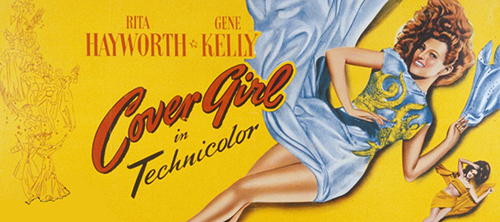
Film
Musique: Jerome Kern • Paroles: Ira Gershwin • Livret: Production originale: 1 version mentionnée
Dispo: Synopsis Commentaire Génèse
Cover Girl is a 1944 American comedy musical film starring Rita Hayworth and Gene Kelly. The film tells the story of a chorus girl given a chance at stardom when she is offered an opportunity to be a highly paid cover girl. The film was directed by Charles Vidor, and was one of the most popular musicals of the war years.
Genèse: Columbia Pictures originally wanted to use Warner Bros. star Dennis Morgan for Cover Girl, but when Kelly's project at MGM, Dragon Seed, was postponed, MGM extended their loan of Kelly to Columbia, allowing this film to be made with him. Columbia's production head, Harry Cohn, was initially opposed to having Kelly do the film, but producer Schwartz nevertheless obtained him, promising Kelly that he would be able to choreograph, which MGM had not allowed him to do. Columbia gave Kelly almost complete control over the making of this film, and many of his ideas contributed to its lasting success. He removed several of the soundstage walls so that he, Hayworth, and Silvers could dance along an entire street in one take. He also used trick photography so that he could dance with his own reflection in the sequence "Alter-Ego Dance", achieved using superimposition to give his "double" a ghost-like quality. Kelly, along with Stanley Donen, devised the choreography. Film historians consider Cover Girl the point where Kelly hit his stride in a musical role that foreshadowed the best of his future work. The film was Hayworth's fourth musical: the first two she had done opposite Fred Astaire. Hayworth's singing voice was dubbed by Martha Mears. Cover Girl was Columbia's first Technicolor musical, and songwriter Arthur Schwartz's first venture into producing. The film was a big hit, and made stars out of both Hayworth and Kelly. The success of Cover Girl caused MGM to pay closer attention to Kelly as a viable property, and they allowed him to create his own dance numbers for his next film, Anchors Aweigh (1945), also starring Frank Sinatra. Columbia bought the film rights to Pal Joey, which Kelly had done on Broadway, hoping to pair up Kelly and Hayworth again, but MGM refused to loan him out, and instead the film was made with Sinatra playing the lead.
Résumé:
Création: 20/3/1944 - *** Film (***) - représ.
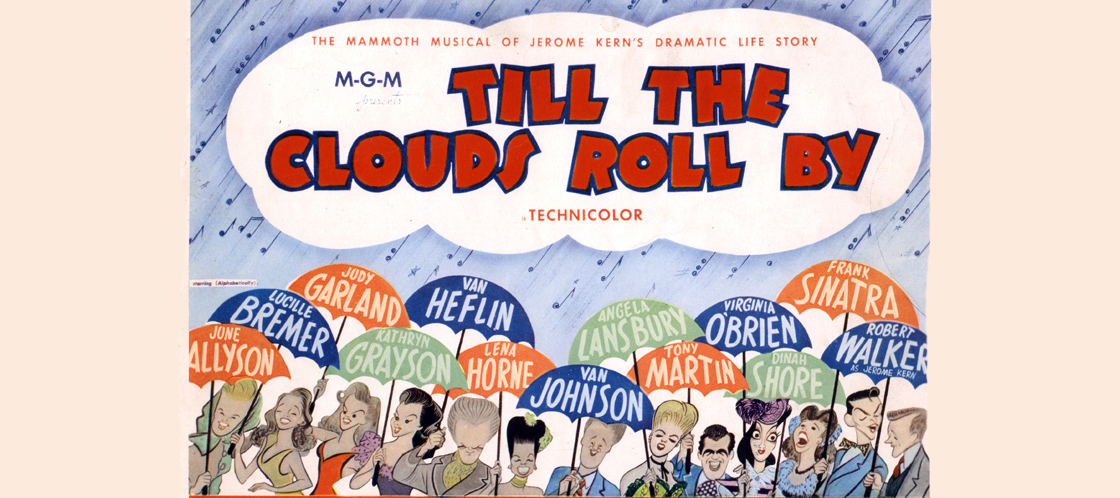
Film
Musique: Jerome Kern • Paroles: Dorothy Fields • Guy Bolton • Ira Gershwin • Jerome Kern • Oscar Hammerstein II • Otto Harbach • P. G. Wodehouse • Livret: Production originale: 1 version mentionnée
Dispo: Résumé
Till The Clouds Roll By est un film musical américain Technicolor de 1946 par Metro-Goldwyn-Mayer. Il s'agit d'un biopic fictif du compositeur Jerome Kern, interprété par Robert Walker. Kern était à l'origine impliqué dans la production, mais est décédé avant qu'elle ne soit terminée. Il présente un large casting de stars musicales bien connues de l'époque qui apparaissent en interprétant les chansons de Kern. C'était le premier d'une série de biopics MGM sur les compositeurs de Broadway; il a été suivi par Words and Music (Rodgers et Hart , 1948), Three Little Words (Kalmar et Ruby, 1950) et Au fond de mon cœur (Sigmund Romberg, 1954).
Genèse:
Résumé: Le 27 décembre 1927, le soir de Première de son dernier et plus élaboré musical, Show Boat (), le célèbre compositeur Jerome Kern visite le quartier où il a commencé sa carrière de nombreuses années plus tôt. Alors qu’il est assis dans sa limousine avec son chauffeur, Jerome se souvient de ses débuts comme jeune auteur-compositeur et du jour où il est arrivé chez le compositeur James I. Hessler (Van Heflin) en quête de conseils professionnels. Alors qu’il se prépare à partir pour l’Angleterre pour écrire une symphonie, Van Heflin dit à Kern qui se présente chez lui, qu’il part parce qu’il est désillusionné par la médiocrité de la musique américaine. Van Helfin rejette Kern, voyant en lui un de ces nombreux paroliers qui viennent lui demander conseil. Mais Van Helfin va changer d'avis lorsqu'il entendra l’une des magnifiques mélodies de Kern. Alors que la jeune fille de James, Sally, et Kern jouent la chanson pour lui, Van Helfin se rend compte que son visiteur est destiné à devenir un grand compositeur. Les deux compositeurs deviennent rapidement amis, et avant que Van Helfin ne parte pour l’Angleterre, il conseille à Kern de «voir grand» et de ne pas perdre son temps à écrire des chansons frivoles. Kern prend le conseil à cœur, mais devient de plus en plus découragé par son incapacité à vendre ses œuvres. Après avoir conclu que Broadway n’est plus accueillant pour les compositeurs américains, il décide de tenter sa chance en Europe et part pour l’Angleterre. Kern retrouve Van Helfin et Sally, qui appelle Jerome Kern: «Oncle Jerry». Ils passent un bel après-midi dans une foire. Là, Kern imagine d’utiliser le rythme des balançoires pour une chanson qu’il a écrit. L’idée est immédiatement incorporée dans un spectacle musical produit par George Edwards. Après le spectacle, Charles Frohman, producteur de théâtre new-yorkais, lui demande d’écrire quatre chansons pour son prochain spectacle à New York. Un jour, alors qu’il parcourt la campagne anglaise à vélo, Jerome rencontre et tombe instantanément amoureux d’une jeune femme nommée Eva. Une romance entre les deux s’épanouit, mais Jerome se retrouve bientôt sur un bateau à destination de l’Amérique, où les répétitions pour le nouveau spectacle de Frohman vont bientôt commencer. Le premier spectacle de Jerome à Broadway, The Girl from Utah () s’avère un grand succès. Très vite, Kern et Van Heflin collaborent sur une partition complète pour un nouveau spectacle. Pour mener le projet à loin, Frohman part pour l’Angleterre à la recherche de nouveaux talents. Kern n'a pas le temps de l'accompagner. En route pour l’Angleterre, le navire de Frohman, le Lusitania, coule, torpillé par la marine allemande le 7 mai 1915. Frohman périt comme 1.200 passagers de ce bateau. Après avoir reçu des encouragements du compositeur Victor Herbert, Jerome reprend son travail et compose un succès de Broadway après l’autre. Kern revient finalement en Angleterre et épouse Eva. Le temps passe, et Sally, maintenant actrice en herbe, obtient son premier rôle dans le nouveau musical de Kern, Sunny (). Cependant, lorsque le producteur du spectacle impose que la chanson-titre soit retirée à Sally au profit de Marilyn Miller, Sally abandonne Kern et son père. Peu de temps après, James Van Heflin meurt d’une maladie cardiaque. Après la mort de son mentor, Jerome Kern perd la volonté de composer de nouvelles chansons, mais sa désillusion s’estompe rapidement lorsqu’il voit Sally chanter dans une discothèque à Memphis. Jerome Kern est engagé pour composer des chansons pour la prochaine production de Victor Herbert, Show Boat (). Jerome sort alors de sa rêverie et est conduit par son chauffeur à une fête pour célébrer le succès de Show Boat (). La renommée de Jerome l’amène finalement à Hollywood, où il est surpris, mais heureux, d’apprendre que Sally a été choisie pour chanter une chanson qu’il a écrite pour un film.
Création: 3/1/1947 - *** Film (***) - représ.

Film
Musique: George Gershwin • Harry Warren • Paroles: Ira Gershwin • Livret: Adolph Green • Betty Comden • Production originale: 1 version mentionnée
Dispo: Résumé Commentaire
Ce film musical en Technicolor de 1949, produit par l'unité Arthur Freed de la Metro-Goldwyn-Mayer, a réuni Fred Astaire et Ginger Rogers après dix ans d'interruption.
Genèse:
Résumé: À la sortie d’une grande première, Josh (Fred Astaire) et Dinah (Ginger Rogers) Barkley prennent part à une grande réception où ils rencontrent Jacques Barredout (Jacques François), dramaturge français émigré aux États-Unis. Jacques Barredout propose à Dinah dont il est amoureux, de devenir "sa" tragédienne dans sa dernière pièce. Il ignore délibérément Josh qui n'est pour lui qu'un amuseur. Après son succès, Dinah revient vers Josh, son amour et ils repartent dans leur domaine, la comédie musicale.
Création: 4/5/1949 - *** Film (***) - représ.

Film
Musique: George Gershwin • Paroles: Ira Gershwin • Livret: Alan Jay Lerner • Production originale: 1 version mentionnée
Dispo: Résumé
"An American in Paris" est une comédie musicale américaine cinématographique inspirée de la composition orchestrale "An American in Paris" de George Gershwin de 1928.
Genèse:
Résumé: À Paris, une riche héritière s'éprend de Jerry Mulligan (Gene Kelly), un jeune peintre américain. Mais celui-ci tombe amoureux de Lise (Leslie Caron), qui est elle-même promise à un autre homme, Henri. Ce film est universellement célèbre pour sa scène finale : Jerry pense qu'il ne pourra jamais être avec Lise et fait un rêve fantastique : apothéose du film. Il rêve qu'il danse avec Lise partout dans les rues de Paris. Le fiancé de la jeune fille et tout un chœur se joignent à eux tout au long d'un ballet magistral qui dure près de dix-huit minutes. La musique du ballet (qui porte le nom du film) est de George Gershwin. Dans les dernières mesures, Henri accepte de renoncer à Lise, qui se précipite dans les bras de Jerry sous la bénédiction d'Henri. Le film s'achève.
Création: 4/10/1951 - *** Film (***) - représ.

Musical
Musique: George Gershwin • Paroles: Ira Gershwin • Livret: Peter Stone • Timothy S Mayer • Production originale: 2 versions mentionnées
Dispo: Résumé Synopsis Génèse Liste chansons
Genèse: Just prior to out of town tryouts in Boston, the original director, Peter Sellars, was fired, with the musical director and arranger, the book writer, Tim Mayer, and set designer, Adrianne Lobel, dismissed soon after. Tommy Tune "nominally took over the direction with his co-choreographer Thommie Walsh, and Mike Nichols, Tony Walton and...Michael Bennett were brought in to help with the direction, choreography and set design." Productions My One and Only opened on Broadway at the St. James Theatre on May 1, 1983 and closed on March 3, 1985 after 767 performances and 37 previews. The musical was directed and choreographed by Tommy Tune and Thommie Walsh. The cast included Tune, Twiggy, Roscoe Lee Browne, Denny Dillon, Charles "Honi" Coles, and Nana Visitor. Notable replacements during the run included Sandy Duncan, Don Correia, Jeff Calhoun, and Georgia Engel. The musical opened in the UK at the Chichester Festival Theatre and then opened in the West End at the Piccadilly Theatre in February 2002, starring Janie Dee as Edythe Herbert and Tim Flavin as Captain Billy Buck Chandler, with direction by Loveday Ingram and choreography by Craig Revel Horwood. Cabaret singer and Gershwin historian Michael Feinstein served as the musical consultant for the project. An extensive review of the show's creation can be found in his book" Nice Work If You Can Get It" in a chapter entitled My One and Only Tommy Tune Fling. There were several tours, all with Tommy Tune. The first was in 1985 with Sandy Duncan which started at the Kennedy Center in March 1985 and included a six week engagement in Japan. Lucie Arnaz replaced Duncan in this tour. Stephanie Zimbalist starred in the US national tour in 1987.
Résumé: Captain Billy Buck Chandler wants to be the first to make a solo flight across the Atlantic. Edythe Herbert, a champion swimmer, is being blackmailed by her wicked Russian manager who has some compromising photographs of her . This devious baddy known as Prince Nikki (and secretly a spy) will get his come-uppance, thanks to Billy’s airplane engineer, a rather butch lady called Mickey (who turns out to be a secret agent). By then, however, Billy and Edythe have fallen in love, have crashed on a desert island (actually Staten Island!), and have seen off a bootlegging Harlem minister and a tap-dancing philosopher called Mr Magix.
Création: 1/5/1983 - St. James Theatre (Broadway) - représ.

Musical
Musique: George Gershwin • Paroles: Ira Gershwin • Livret: Ken Ludwig • Production originale: 8 versions mentionnées
Dispo: Résumé Synopsis Génèse Liste chansons
Genèse: The Broadway production was directed by Mike Ockrent and choreographed by Susan Stroman. After 10 previews, it opened at the Shubert Theatre on February 19, 1992, and ran for 1,622 performances. The cast included Jodi Benson as Polly, Harry Groener as Bobby Child, Bruce Adler as Bela Zangler, John Hillner as Lank Hawkins, Michele Pawk as Irene Roth, Jane Connell as Mother, Beth Leavel as Tess (Leavel also understudied Benson), Ronn Carroll as Everett Baker, and Stephen Temperley and Amelia White as Eugene and Patricia Fodor. The Manhattan Rhythm Kings played cowboys Mingo, Moose, and Sam, singing in their trademark close harmony. In his review in The New York Times, Frank Rich wrote, "When future historians try to find the exact moment at which Broadway finally rose up to grab the musical back from the British, they just may conclude that the revolution began last night. The shot was fired at the Shubert Theater, where a riotously entertaining show called Crazy for You uncorked the American musical’s classic blend of music, laughter, dancing, sentiment and showmanship with a freshness and confidence rarely seen during the Cats decade . . . Crazy for You scrapes away decades of cabaret and jazz and variety-show interpretations to reclaim the Gershwins’ standards, in all their glorious youth, for the dynamism of the stage." A cast album was released by Angel Records. The West End production, directed by Ockrent, choreographed by Stroman, and starring Ruthie Henshall, Kirby Ward, and Chris Langham, opened at the Prince Edward Theatre on March 3, 1993 and ran for nearly three years. On October 20, 1999, the PBS series Great Performances broadcast a production directed by Matthew Diamond, who was nominated for the Emmy Award for Outstanding Direction of a Variety or Music Program. On October 18, 2009, a showtime challenge, charity gala performance of Crazy for You, directed by Katherine Hare and choreographed by Racky Plews was staged by Eyebrow Productions at the London Palladium. Eyebrow are well known for their unique Showtime Challenges, where all aspects of the show are rehearsed and performed in 48 hours. All proceeds went to Cecily's Fund. In 2011, Regent's Park Open Air Theatre did a revival of Crazy for You as part of the 2011 Summer Season. The production has since moved to the West End, at the Novello Theatre where it is running from October 8, 2011 to July 28, 2012.
Résumé: CRAZY FOR YOU™ is the story of Bobby Child, a well-to-do 1930's playboy, who's dream in life is to dance. And despite the serious efforts of his mother and soon-to-be-ex-fiancee, Bobby achieves his dream! Memorable Gershwin tunes include I Can't Be Bothered Now, Bidin' My Time, I Got Rhythm, Naughty Baby, They Can't Take That Away from Me, But Not for Me, Nice Work if You Can Get It, Embraceable You and Someone to Watch Over Me. It's a high energy comedy which includes mistaken identity, plot twists, fabulous dance numbers and classic Gershwin music.
Création: 19/2/1992 - Shubert Theatre (Broadway) - 1622 représ.

Musical
Musique: George Gershwin • Paroles: Ira Gershwin • Livret: Jo DiPietro • Production originale: 2 versions mentionnées
Dispo: Résumé Génèse Liste chansons
Nice Work If You Can Get It is a musical featuring songs by George and Ira Gershwin, with a book written by Joe DiPietro, and based on material by Guy Bolton and P. G. Wodehouse. Nice Work premiered on Broadway in April 2012.
Genèse: Background The musical was initially produced in 2001 at the Goodspeed Opera House titled They All Laughed!, with the book by Joe DiPietro and direction by Christopher Ashley. The musical received "mixed notices" according to Frank Rizzo, writing in the Hartford Courant.[3] New collaborators and producers then became involved. A workshop was held in November 2007, featuring Harry Connick, Jr. and Erin Dilly. At that time, the show was titled Heaven on Earth. The musical was first scheduled to debut at the Colonial Theatre in Boston, running from December 2008 through January 2009. The production was expected to open on Broadway in Spring 2009, with Harry Connick, Jr. However, in 2008 it was announced that the musical was "officially postponed", due to a change in the producing team; Connick ultimately left the project. Productions Preview performances began on Broadway at the Imperial Theatre on March 29, 2012 with the opening on April 24, 2012. Directed and choreographed by Kathleen Marshall, the cast starred Matthew Broderick (Jimmy Winter) and Kelli O'Hara (Billie Bendix). The production closed on June 15, 2013, after 27 previews and 478 regular performances. A US national tour started on September 2, 2014 at the Music Hall at Fair Park in Dallas, Texas, and ran, with an extended break for the winter holidays, until March 22, 2015. It finished at the Segerstrom Center for the Arts in Costa Mesa, California. The Australian premiere, a non-replica production directed by Roger Hodgman for The Production Company, played at the State Theatre, Arts Centre Melbourne from August 15 to 23, 2015. It featured Rohan Browne, Esther Hannaford, Christie Whelan-Browne, John Wood, Gina Riley, George Kapiniaris, and Nicki Wendt. The UK premiere ran at Upstairs at The Gatehouse in London from 12 December 2018 to 27 January 2019. It was directed by John Plews, with choreography by Grant Murphy, musical supervision by Charlie Ingles, musical direction by Chris Poon, design by Pollyanna Elston, sound design by Nico Menghini (assisted by Alistair Warr & Rachel Darwood), lighting design by Sam Waddington (assisted by Bethany Gupwell), costume supervision by Nadine Froehlich, wigs by Jessica Plews, and produced by Katie Plews for Ovation Productions.
Résumé: Act I It's 1927, in the midst of a riotous bachelor party for the oft-married Jimmy Winter ("Sweet and Lowdown"). Outside, a trio of bootleggers – Cookie, Billie and Duke – are trying to figure out where to hide the 400 cases of gin they have stashed on their boat. As a stranger approaches, Duke and Cookie rush off. A drunken Jimmy staggers and comes across the pants-wearing Billie and is immediately smitten. He explains his plight – he must marry someone respectable or his mother will disinherit him, so he's marrying someone he doesn't truly love. Billie isn't all that interested in his tale of woe, until he reveals that he has a huge Long Island beach house that he never uses, so she swipes his wallet to discover the address. Jimmy assumes Billie is falling for him, but Billie insists that love is for suckers. Jimmy vehemently disagrees ("Nice Work If You Can Get It"). Jimmy passes out, and Billie focuses on this interesting man unconscious on the ground before her ("Nice Work If You Can Get It - Reprise"). Cookie and Duke rush back on, and Billie tells them that she found a place to store their bootleg – a Long Island beach house. A police whistle pierces the air, and the bootleggers scatter. Senator Max Evergreen and Chief Berry enter, along with Duchess Estonia Dulworth, who has brought along her Vice Squad and vows to rid society of its greatest evil ("Demon Rum"). The next morning, Billie, Cookie and Duke have stored their 400 cases of gin in the cellar of Jimmy's ritzy beach house. Eileen Evergreen, the finest interpreter of modern dance in the world, enters with Jimmy. They were married that morning, and they are on their honeymoon, though Eileen has yet to allow Jimmy to touch her. Cookie, disguised as a butler, enters and they naturally assume he's their servant. They send him off, and Eileen tells Jimmy that she's ready for the honeymoon shenanigans to begin – as soon as she takes a bath. She exits into the house as Billie enters, stunned to see Jimmy. Jimmy has no memory of meeting her last night, and as Jimmy flirts with her, Billie confesses that she's never been kissed. Strictly for educational purposes, Jimmy kisses Billie, and she realizes what she's been missing ("Someone to Watch Over Me"). Four and a half hours later, Eileen is still bathing ("Delishious"). In the ritzy living room, Cookie and Billie devise a plan for Billie to distract Jimmy from the 400 cases of gin in his cellar. Billie runs off as Jimmy enters, followed by a gaggle of chorus girls who invite him for a group swim, which Jimmy almost accepts ("I've Got to be There"). Eileen enters with a flourish, and just as she is about to let Jimmy touch her, he receives a telegram revealing that his last wife has refused to sign the annulment, and an irate Eileen storms off to get her father. That night in Jimmy's ritzy bedroom, Billie breaks in and tries to seduce him, badly ("Treat Me Rough"). Chief Berry, who has been pursuing Billie, barges in to arrest her. But Jimmy convinces him that Billie is actually his newest wife ("Let's Call the Whole Thing Off") and Billie and Jimmy are forced to spend the whole night together in his bedroom. The next morning, Jeannie, a happy-go-lucky chorus girl, comes upon Duke, a lug from New Jersey, and mistakes him for an actual English Duke. Duke, who is perpetually nervous around women, tries to escape, but Jeannie does everything in her power to get him to notice her ("Do it Again"). In the ritzy living room, Jimmy and Billie realize that they are hopelessly in love ("'S Wonderful") But Eileen returns with her father – the ultra-conservative Senator Evergreen – and her aunt – the Duchess Estonia Dulworth – to demand that Jimmy and Eileen have a legal wedding. Jimmy has no choice but to marry Eileen, and Billie pretends to be a cockney maid so she can stick around and guard the bootleg. As Eileen beelines towards the cellar to get the wedding china, Jimmy and Cookie frantically distract the wedding party away from the basement ("Fascinating Rhythm") as the curtain falls. Act II On the ritzy terrace, the Vice Squad and Chorus Girls revel ("Lady Be Good"). Billie enters and realizes she'll never be as happy as the dancing revelers around her ("But Not For Me"). Cookie and Duke enter and, since they're all now disguised as servants, they plot how they can get the impending wedding luncheon over and done with as quickly as possible. The Duchess barrels on to instruct Cookie in the finer points of luncheon preparation. She insists on hiring a string quartet for entertainment, but Cookie has other ideas ("By Strauss" / "Sweet and Lowdown - Reprise"). As Billie sets the ritzy luncheon table, Jimmy makes one last attempt to appease her ("Do, Do, Do"). But Billie will have none of it. As the luncheon begins, Cookie and Duke frantically serve the luncheon guests, and the Duchess continues to annoy Cookie, who spikes her lemonade with Gin. Billie entertains them all with a cockney song ("Hangin' Around With You") which mainly serves as an excuse to keep pouring hot soup on Jimmy's lap. But Billie accidentally pours some steaming soup onto Eileen, who immediately fires her. The Duchess, now happily drunk, defends Billie and reveals a deep secret as she grabs onto Cookie, climbs on the luncheon table and swings from a chandelier ("Looking for a Boy"). After he drags off the Duchess, an angry Jimmy calls Billie a common criminal, and they realize that they can never be together. Jimmy goes to prepare for his wedding, as Jeannie enters looking for Duke, who Billie accidentally reveals isn't a real duke. Jeannie is furious, so Duke tries to win her over with a poem ("Blah Blah Blah"), but Jeannie rushes away. In the ritzy bedroom, Cookie is dressing Jimmy for his wedding as Billie enters to return his wallet. Jimmy and Billie both realize that this is the last time they'll ever see each other ("Will You Remember Me?"). The Chorus Girls and Vice Squad set up the wedding ("I've Got To Be There - Reprise"). As Senator Evergreen presides, Eileen makes her very grand entrance ("I've Got a Crush on You"). But just before vows are exchanged, Cookie and Duke rush in, pretending to be Prohibition Agents, though Chief Berry quickly enters and reveals their true identities. As they're arrested, Jeannie rushes in and proclaims her love for Duke, then the now sober Duchess proclaims her love for Cookie. Still, Senator Evergreen insists the bootleggers must be arrested, but Jimmy's mother, Millicent, makes an appearance, revealing the true nature of her son's heritage – Senator Evergreen is Jimmy's father. The senator proclaims the day a joyous one and all are free to pursue their new and surprising loves. Jimmy realizes that Billie has rushed to the boathouse to sail away forever, and he rushes to swear his devotion to her. Millicent follows and reveals that she happens to be the biggest rum-runner on Long Island, and she'd like Billie to marry her son and take over her business. Billie happily accepts ("Someone to Watch Over Me - Reprise"). And on the ritzy terrace under a starry night, love has blossomed, the bootleg is opened and the company celebrates their new found joy ("They All Laughed!").
Création: 24/4/2012 - Imperial Theatre (Broadway) - 478 représ.

Musical
Musique: George Gershwin • Paroles: Ira Gershwin • Livret: Craig Lucas • Production originale: 3 versions mentionnées
Dispo: Résumé Génèse Liste chansons
Vidéos:
Ce n’est pas tous les jours que l’on assiste à la première mondiale d’une comédie musicale…
Genèse: Contrairement à la majorité des cas, An American in Paris n'est pas une pièce de Broadway qui fut adaptée au cinéma, pour toucher un public plus large. Il manquait donc à la scène ce fleuron du genre. Jean-Luc Choplin, associé aux producteurs Van Kaplan et Stuart Oken de Broadway, comblent ainsi cette attente. Le succès de Rhapsody in Blue en 1924, permet à George Gershwin de voyager en Europe et de rencontrer lors d'un séjour à Paris nombre de compositeurs qu'il admire. Stravinsky, Ravel, Poulenc, Milhaud… témoignent à l'américain reconnaissance et encouragement. Un Américain à Paris, composé en 1928, est un poème symphonique d'une vingtaine de minutes salué par le critique Isaac Goldberg comme étant "L'après-midi d'un faune américain". En 1950, le producteur Arthur Freed veut illustrer les compositions de Gershwin et en premier lieu Un Américain. Comme il le fera avec Chantons sous la pluie, il met bout à bout un ensemble de chansons existantes sur lesquelles il brode une histoire. Soit celle d'un GI américain, Jerry, peintre à Montmartre, débordant de joie de vivre et de bonne humeur. Il rencontre Lise, une jeune vendeuse mais Lise est aimé d’Henri un chanteur populaire. Les sentiments (l'amour, la déception, la joie et le blues) culminent lors d'une scène de ballet qui verra le couple s'unir sur une des plus célèbres chorégraphies de l'histoire de la comédie musicale hollywoodienne. Réalisé par Vincente Minnelli (qui sera l’un des spécialistes du genre avec Tous en scène, Brigadoon ou Gigi), le film sera récompensé par six oscars. Et Gene Kelly reçoit à cette occasion un oscar d'honneur pour sa contribution exceptionnelle à l'art de la chorégraphie cinématographique. Incorporating songs from George and Ira Gershwin, including "I Got Rhythm", "Liza", "'S Wonderful", "But Not For Me", "Stairway to Paradise", as well as orchestral music including "Concerto in F", "2nd Prelude", "2nd Rhapsody", "Cuban Overture", and the title song, An American in Paris features a book by Craig Lucas.
Résumé: Après la libération, désireux de reprendre sa vie et de tirer un trait sur les violences de la Seconde Guerre mondiale, le vétéran Jerry Mulligan s’installe à Paris et tente de se faire un nom comme artiste peintre. Il trouve un soutien en la personne de Milo Davenport, une riche américaine au passé trouble. L’existence de Jerry se complique lorsqu’il tombe amoureux de Lise, jeune vendeuse parisienne qui porte aussi sa part de secrets, car son ami Adam – un compositeur juif américain, et Henri - un aristocrate parisien - se disputent également son amour. Cette situation sans issue ne trouve de dénouement que dans le miracle de la danse, sur les musiques et lyrics parmi les plus beaux jamais composés. Ce récit culte de jeunesse et d’errance dans le Paris d’Après-Guerre est ici repensé pour la scène du 21e siècle.
Création: 10/12/2014 - Théâtre du Châtelet (Paris) - représ.


.png)
.png)





